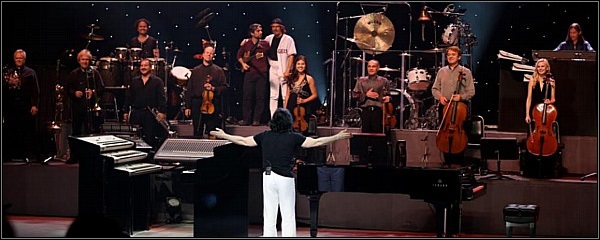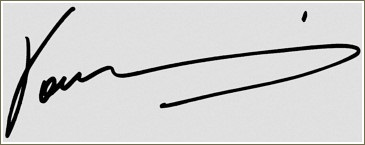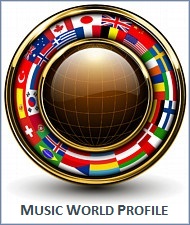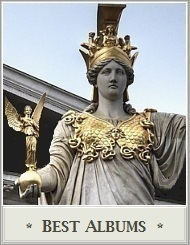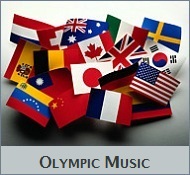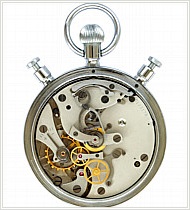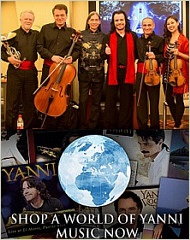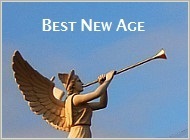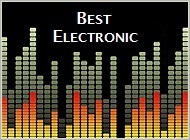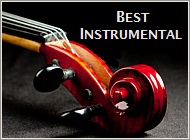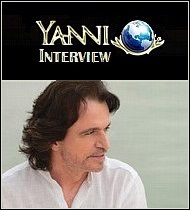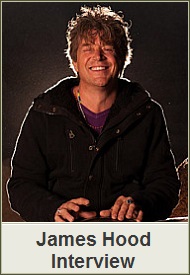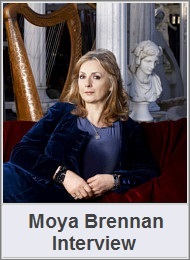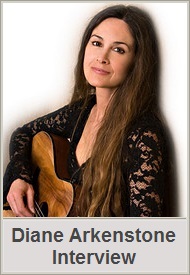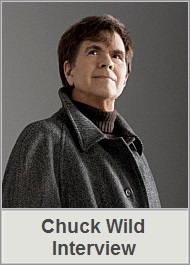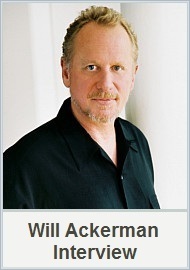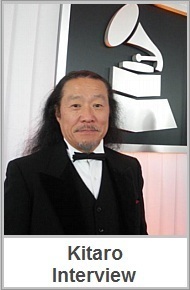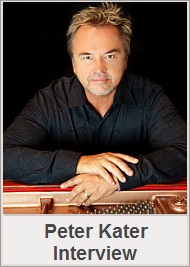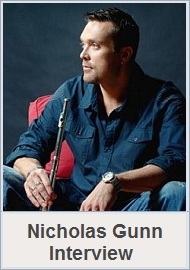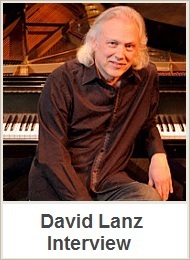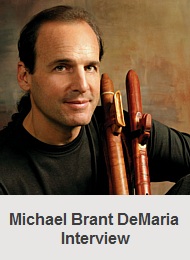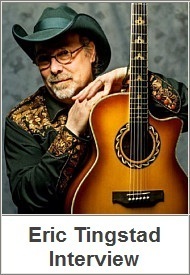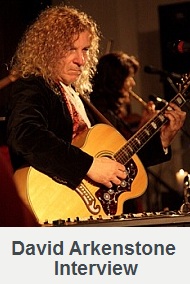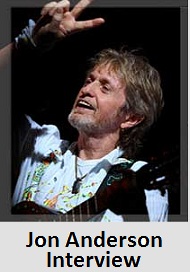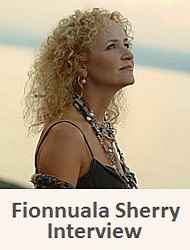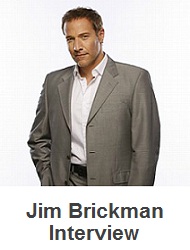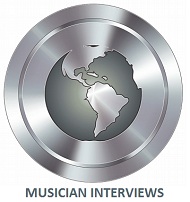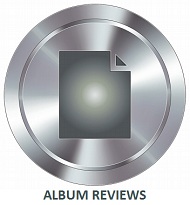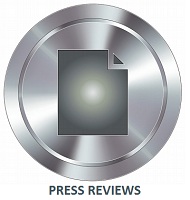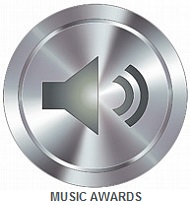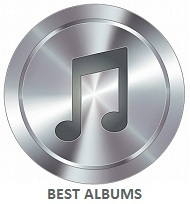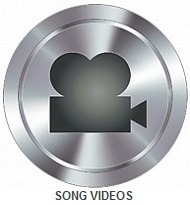Archive for the ‘An Interview with John P. Olsen’ Category

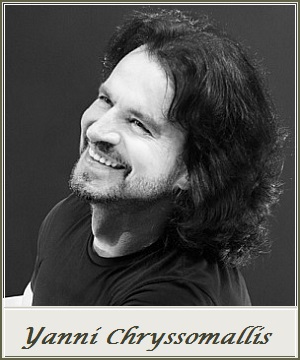 Special new interview in 2014 with international concert and recording music celebrity Yanni.
Special new interview in 2014 with international concert and recording music celebrity Yanni.
Multi-Platinum selling recording and international concert artist Yanni is a legendary artist known worldwide for bringing professional live music and unifying message to all parts of the world. For over 30 years, Yanni has made his presence known as a leading international concert artist with around one billion admirers of all nationalities.
Famous for his concert venues in settings of historical significance, Yanni and his elite orchestra have begun their Worldwide Concert Tour in 2014. During the 2014 concert season an extensive worldwide tour will include venues covering over 20 countries, including Chile, Argentine, Brazil, UK, Germany, Czech Republic, Ukraine and Russia. Also scheduled later this year are concert venues in the U.S. and Canada, with more dates to be added as the year progresses.
Topics covered in this interview are related to Yanni’s newest album Inspirato, a collective project which has taken 20 years to compose and four years to complete. Soon to be released, Inspirato is unlike any other album ever produced. Yanni details the 2014 concert season, with an emphasis on the extraordinary musicians and vocalists in his orchestra. His close relationship with fans of all nationalities and the importance of official Street Team members and Fan Clubs are covered, along with news and his plans for the future.
Exclusive New Interview with Yanni:
John P. Olsen: Let me begin by thanking you for your time Yanni. It is widely known your yearly concert schedule, with consistently sold out concert venues is demanding to say the least. It’s an honor to present to fans your most current, up-to-date interview, taking place during your Worldwide Concert Tour in 2014 and upcoming new release Inspirato.
I am confident many people who have attended one of your earlier concerts, are now anticipating their next opportunity to watch you perform live during the 2014 concert season. For some people this year will be their first chance to attend a live Yanni concert. For the benefit of every concertgoer; can you tell us about any changes you have planned this year, and what attendees will experience during a live concert event in 2014?
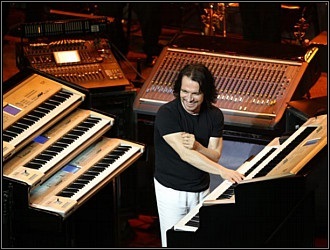 Yanni: We have listened to what the fans have been requesting and asking us to put into the concert though the social media in the internet. I have introduced some songs that have been not performed for many years into this current tour.
Yanni: We have listened to what the fans have been requesting and asking us to put into the concert though the social media in the internet. I have introduced some songs that have been not performed for many years into this current tour.
There is music from the very beginning of my career right up my most recent studio album. We have just started this recent tour in South America and the audience reaction was fantastic.
John: Clearly, the extraordinary vocalists and instrumentalists in your orchestra are an integral part of the total Yanni concert experience. Would you like to tell us about the artists performing with you during the 2014 concert season?
Yanni: I believe that our orchestra is made up of the best musicians in the world. Some of these musicians have been touring with us for decades and the most recent additions have already been with us for over 3 years.
Our musicians represent 11 different nationalities on the stage including England, Germany, Venezuela, Cuba, Paraguay, China, Canada, USA, Russia, Armenia and Greece. Some of the featured soloists fans will be familiar with are Samvel Yervinyan (Armenia) on violin, Charlie Adams (USA) on drums, Ming Freeman (China) on keyboards and Alexander Zhiroff on cello.
Here is a short biography for each orchestra member and vocalists touring with us in 2014 – 2015. (Shown Below)
John: The 2014 concert schedule posted at Yanni.com is already an ambitious number of concert appearances, with many more performances to be added later in the year. Given the fact each concert venue is special in its own way, what drives or motivates you and the orchestra to produce an exciting and memorable concert experience for an audience every time?
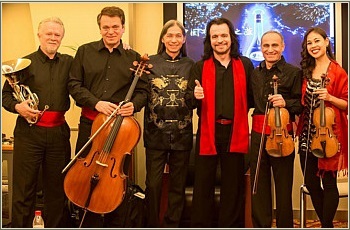 Yanni: Every single concert is different. Each one has a unique experience with the audience and in my career I have never experienced any two concerts that were the same. This coming year we will be touring in over 20 countries and we get a renewed enthusiasm from each new audience.
Yanni: Every single concert is different. Each one has a unique experience with the audience and in my career I have never experienced any two concerts that were the same. This coming year we will be touring in over 20 countries and we get a renewed enthusiasm from each new audience.
That is the magic of live performances, they are live and never the same. I still get “butterflies” or anxious before every single show. When we perform for an audience, we get so much love from the audience that makes all of us on the stage feel so motivated and rewarded for our effort and this love and relationship with the audience is what keeps us going with such enthusiasm.
John: For any person who has attended or watched one of your televised live concerts, it is apparent the caliber of artists and vocalists in your orchestra is unsurpassed.
Even to the untrained ear their performances are stunning! It is easy to tell that you select only the very best musicians and vocalists from around the world. Can you tell us a little bit about the selection process for artists in your orchestra?
Yanni: Our history has been that someone in the orchestra refers the new person to us. Each member knows the commitment that is required to be in this orchestra and they understand the chemistry, personality and the skill level that is required. Once we have people referred, they undergo a rigorous audition process and then we put them in with the rest of the orchestra. If the chemistry works and they are of the caliber of character needed, then they join and stay for many years. Thankfully, we don’t find ourselves looking for new people very often. Usually several years pass before we look for new members.
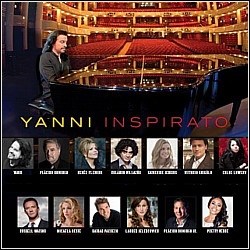 John: Recent albums Truth Of Touch & Yanni: Live At El Morro, Puerto Rico have proven to be an enormous success worldwide, having achieved 40 platinum and gold albums and Best Albums of the year at Billboard during your career. Needless to say your millions strong fan base would love for you to produce more releases. I understand the most aspiring project of your life is nearing release, isn’t that right?
John: Recent albums Truth Of Touch & Yanni: Live At El Morro, Puerto Rico have proven to be an enormous success worldwide, having achieved 40 platinum and gold albums and Best Albums of the year at Billboard during your career. Needless to say your millions strong fan base would love for you to produce more releases. I understand the most aspiring project of your life is nearing release, isn’t that right?
Yanni: Yes, we have a new studio album titled “Inspirato” that is coming out in April of 2014. This album took 4 years to record and 20 years to compose the music that inspired it.
I have collaborated with Placido Domingo to have vocals recorded to some many of my instrumental songs with the greatest voices in the world including Placido Domingo, Renée Fleming, Vittorio Grigolo, Rolando Villazon, Katherine Jenkins, Russell Watson, Pretty Yende, Nathan Pacheco, Placido Domingo Jr., Lauren Jelenkovich and Chloe Lowery.
We also have a new television show that is being completed right now. It should also be ready for release in April 2014. The title is “World Without Borders.” It is a collection of performances and behind the scenes looks at our concert tour over the past 3 years and is taken from concerts from over 20 different countries.
John: In your autobiography entitled Yanni in Words, you talk about the creative process in which you compose music. Undoubtedly, music technology has changed greatly from the early years when you first began composing. Your studio albums Truth Of Touch & Inspirato were produced with today’s most innovative electronic equipment. To what degree has today’s advanced music equipment and technology influenced, or changed the thought process while composing, in comparison to the way you composed music years ago?
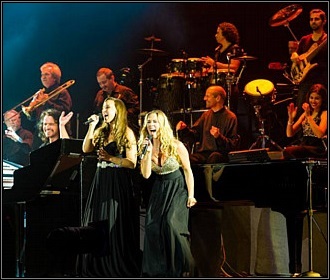 Yanni: For me the development of new technology to assist with the recording process has made it possible for me to express a much wider array of the creative aspect of music. I am able to record more efficiently and to adapt and alter the sounds to more closely replicate what is in my imagination.
Yanni: For me the development of new technology to assist with the recording process has made it possible for me to express a much wider array of the creative aspect of music. I am able to record more efficiently and to adapt and alter the sounds to more closely replicate what is in my imagination.
I also have been able to experiment with new sound designs thought technology and many of these sounds were never previously available. For me as a composer this technology has allowed me to more completely express my creative thoughts.
John: In your 2003 autobiography, Yanni in Words, many topics about your life are revealed. Have you considered publishing an updated version of your autobiography at some point in your life?
Yanni: I think that the time will come in the near future for me to share the changes and new lessons learned over the past decade. In recent years I have been able to travel the world more extensively than ever before in my life and I have been able to conquer new challenges and perform and be educated by different people and cultures like never before.
John: Throughout your career, you have shared a close relationship with your fans. It seems you devote so much of your time and energy to please the millions of Yanni fans, which includes membership portals, special events and countless interviews, including our interview today. Why are fans so important to you Yanni?
Yanni: The relationship with my audience is very important because the fans give to me more than I could ever give to them. The love I receive from fans along with the knowledge that my music has affected so many people gives me the passion to continue my career. This interaction with the fans is why I have been able to work at my passion for over 30 years now and there is no end or sign of slowing down in sight. I am extremely grateful to all of my fans for this support and encouragement.
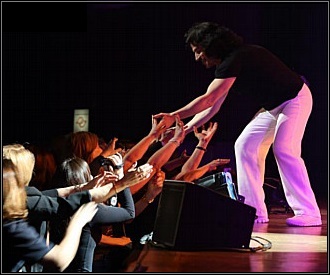 John: In addition to the official Yanni international website hosts and great staff members I met at Yanni-Wake Entertainment, you also have official groups like Fan Clubs, Street Teams, and organizations that provide an invaluable role by organizing pre-concert events and a variety of official Yanni activities.
John: In addition to the official Yanni international website hosts and great staff members I met at Yanni-Wake Entertainment, you also have official groups like Fan Clubs, Street Teams, and organizations that provide an invaluable role by organizing pre-concert events and a variety of official Yanni activities.
Would you please tell us about the people in these vital organizations, their role, responsibilities, and who to contact if a person would like to join, and be a part of the Yanni team?
Yanni: I am very proud of our street team members and our fan clubs around the world. I believe we have 32 official Yanni fan clubs around the world. I can tell you that these people are incredibly important to what I do as a musician in that they help answer questions, share information and are the back bone of creating a global community centered on the music.
It is always an honor for me to travel around the world and meet these people personally. Anyone can join our family by registering at Yanni.com or join our team by emailing: TeamYanni(at)YanniWake.com.
John: It is no secret that you and the U.S. based Public Broadcast Service (PBS) share a wonderful connection together for decades. You are recognized as one of the top PBS fundraisers during the non-profit television network’s pledge drives and TV specials, but on the other hand, you and other artists can be thankful for PBS too. In what way has the television Public Broadcasting Service been a positive influence for artists in general and for you personally throughout your music career?
Yanni: PBS has been a wonderful partner for many artists in that PBS gives artists the opportunity to present their art in the manner that is true to them and shares it with a huge audience. Without PBS, many artists would have never had this opportunity and may never have realized professional careers. I am thankful for my long relationship with PBS, it has been a significant factor in helping to give me a professional career as a composer and musician.
 John: You are an international music celebrity whose innovative achievements are many Yanni. You are perhaps most famous for your groundbreaking, international concert venues at the Acropolis in Greece, Forbidden City in China, Taj Mahal in India, The Kremlin in Russia, and other significant international concert venues. Of your numerous professional or personal successes, what would you say are the two most rewarding moments in your career to date?
John: You are an international music celebrity whose innovative achievements are many Yanni. You are perhaps most famous for your groundbreaking, international concert venues at the Acropolis in Greece, Forbidden City in China, Taj Mahal in India, The Kremlin in Russia, and other significant international concert venues. Of your numerous professional or personal successes, what would you say are the two most rewarding moments in your career to date?
Yanni: There are so many rewarding moments and for so many different reasons. Recently, I have been very proud of our ability to break into some new markets such as the Middle East in Oman, Bahrain, UAE and Qatar.
I also have been very moved by our recent success in South America, specifically Brazil where we have been able to perform several concerts and are continuing to grow our audience.
I also appreciate the very intimate and heartfelt experiences realized by meeting many people and coming in contact with many cultures such as helping with the flood victims in Thailand, the adoption of a Panda from the people of China, and my relationship with the International Space Station through NASA and the Russian space program.
John: Do you have any personal or professional endeavors you would like to achieve sometime in the future?
Yanni: At the moment I am very happy with our plans to continue touring around the world and meeting new people and learning from new cultures. I am sure that in some years from now, this will slow down and I will have other initiatives to explore but for the moment I am living in what is the best time of my life and I am very happy with that.
John: While preparing for our interview Yanni, I couldn’t help but think of what an amazing success story your life has been. Every day I am in contact with artists, many of which envision the attainment and level of success in their careers, similar to what you have achieved during your career. Knowing there will be a variety of debuting and seasoned artists reading our interview; can you offer any advice or guidance for musicians in general or artists in the early stages of their music career?
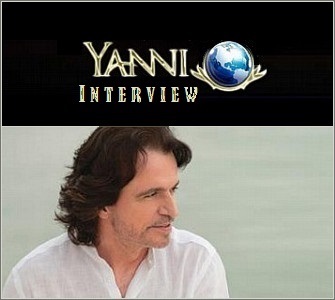 Yanni: I believe that as an artist and composer, you must stay true to your dreams and persist through the challenging times. I never had a master plan for how my career would work out. I would just focus on the task at hand and dedicate all of my energy and resources to what I was doing at that time.
Yanni: I believe that as an artist and composer, you must stay true to your dreams and persist through the challenging times. I never had a master plan for how my career would work out. I would just focus on the task at hand and dedicate all of my energy and resources to what I was doing at that time.
I never thought about success or money, I only thought about my music and doing the very best I could in being a creative artist. I believe that by putting all of my energy and resources into my music, it led to me being able to have a career as a professional music artist.
John: It has been a privilege to present your most current interview in 2014 Yanni! On behalf of your millions of fans around the world and myself, thank you yet again for sharing a moment of your time. Until the day we visit again, is there anything you would like to express to your fans or official team members who have supported you over the years?
Yanni: It is because of all of the fans and our affiliates that I am able to continue with my career. It gives me great pride to be associated with all of you and I look forward to meeting with as many of you as possible as we continue to travel the world.
Warm Regards, Yanni
Visit the official Yanni.com homepage where you can find 2014 Concert Tour information. Read the full biographies for the elite team of Yanni Orchestra Members and visit their official websites. To purchase CD albums, DVDs, gift items and merchandise visit the Yanni Store. Find information for the Yanni Community, Street Team, Fan Club and International Affiliate Members at Yanni.com and read my Yanni Section. For current news visit social media sites Facebook and Twitter. Interview photos courtesy yanni-wake entertainment & whit padgett. Big stock photos courtesy sborisov & pius99.
Orchestra Member’s Biography Summary:
Yanni’s orchestra is a truly unique collection of musicians. Yanni has hand-picked each member of his orchestra and has been in search for the world’s top performers to bring you what you see today. He refers to them as the “United Nations” as they come from all walks of life, backgrounds and experiences from all over the world. Yanni brings you on a musical journey that only this group of musicians can attempt. The talents from each member surpass the imaginable, and they are all brought to you on one stage under the guidance of a true modern day orchestrator.
1. Charlie Adams, Drummer, Illinois, USA
From the USA, Charlie has been with Yanni from the beginning performing on drums in rock bands when they were kids. Charlie’s energy, stage performance and stamina gets every audience on their feet all around the world.
2. Benedikt Brydern, Violin, Munich, Germany
From Germany, Benedikt has a background in jazz violin and brings his unique style to Yanni’s music. He has been touring with the Yanni orchestra for 4 years.
3. Jason Carder, Trumpet, Arizona, USA
From the USA, Jason has shared his talents as a professor of jazz trumpet at the University of Miami. He has toured with Yanni for 4 years and uses his flugelhorn to reach unimaginable notes.
4. Yoel Del Sol, Percussion, Cuba
From Cuba, Yoel has been Yanni’s leading percussionist for 4 years performing the congas like no other. He brings an energy and latin flair to stage.
5. Victor Espinola, Harp, Asuncion, Paraguay
From Paraguay, Victor is a unique performer who brings a dynamic injection of unique style to the harp. Victor has been with the Yanni orchestra for a decade.
6. Ming Freeman, Keyboards, Taiwan
From Taiwan, Ming has been with Yanni for almost two decades touring as the lead keyboardist. Ming’s solos feature his true talents and showcases just how fast and rhythmic he can be on the keyboards.
7. Lauren Jelencovich, Vocalist, Florida, USA
From the USA, Lauren is classically trained at the Manhattan School of Music and has a voice capable of effortlessly hitting notes that no other singer would attempt. Lauren has been with the tour for the past 2 years.
8. Lisa Lavie, Vocalist, Montreal, Canada
From Canada, Lisa’s powerful voice takes on some of Yanni’s most difficult compositions. As singer and songwriter, she brings energy and emotion to the stage. Lisa has been with the tour for the past 2 years.
9. James Mattos, French Horn, California, USA
From the USA, James has been performing on his French Horn for over 18 years with Yanni’s orchestra. He maintains the warm, rich undertones throughout the concert events.
10. Sarah O’Brien, Cello, Nottingham, England
From England, Sarah has toured all over the world with Yanni. Trained on cello in London’s Guildhall School of Music, she has been seen on the stage with Yanni at every major concert event.
11. Mary Simpson, Violin, Virginia, USA
From the USA of Chinese decent, Mary plays her “fiddle” bringing warmth and richness with a bluegrass edge – her style and her smile capture the hearts of every audience. Mary has been touring with Yanni for the past 2 years.
12. Dana Teboe, Trombone, Florida, USA
From the USA, Dana is a widely recognized trombone player who has impeccable tone, accuracy and energy. Dana has been performing with Yanni for 8 years.
13. Gabriel Vivas, Bass, Caracas, Venezuela
From Venezuela, Gabriel brings a new life to the bass performing runs and scales rarely seen. Gabriel has been with Yanni since 2008 and remains a top performer.
14. Samvel Yervinyan, Violin, Yerevan, Armenia
From Armenia, Samvel has been widely recognized as one of the world’s premier violinists and has been a star performer among Yanni’s orchestra for the past decade.
15. Alexander Zhiroff, Cello, Russia
From Russia, “Sacha” has been touring with Yanni for almost 17 years performing at all the major concert events around the world with his cello. Sacha performs with a unique style and incredible talent.

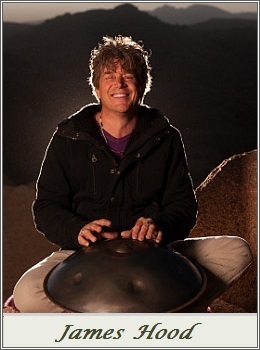 Exclusive interview in 2014 with music artist James Hood.
Exclusive interview in 2014 with music artist James Hood.
Interview host and publicist John P. Olsen recently had an opportunity to interview celebrated percussionist and soloist James Hood, creator of the ambient electronic group, Moodswings, and former percussionist for the popular new wave/alternative band the Pretenders.
Composer, producer and percussionist James Hood has enjoyed a diverse and lengthy career as an instrumentalist. Highlights include a successful solo career, having just released a new 2 disc solo album titled Ceremony. This new release, recorded at the Integratron structure near Joshua Tree, California is currently the #1 album on iTunes Canadian World Music Chart.
James Hood is a highly respected artist who possesses, and has delivered, a versatile range of music to millions throughout his decade’s long career. During this newest interview conversation, which takes place in March of 2014, a wide variety of in-depth topics are explored.
Included in this discussion James Hood talks in detail about his new solo album Ceremony, which is performed exclusively on an exotic percussion instrument named PanArt Hang.
Information on the unique tonal qualities of the percussion instrument is provided, along with the fundamental variations of the Hang. Today I am pleased to present an informative conversation with fans and visitors.
Interview with James Hood in 2014:
John P. Olsen: Thank you so much for accepting my interview invitation James. I have been a fan of the music you have produced for years, and it’s a privilege to host your newest interview in 2014.
James Hood: Thanks John. I appreciate all of your support over the years and it is a pleasure to talk with you.
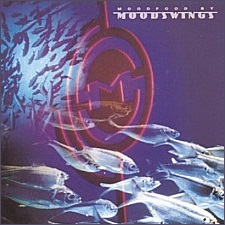 John: In addition to your solo career as a new age artist, you have enjoyed a diverse and remarkable music career, including being the originating member of the popular, ambient electronic band Moodswings. Plus you were a percussionist for several other bands, including the music icons Jeff Beck and pop new wave band the Pretenders.
John: In addition to your solo career as a new age artist, you have enjoyed a diverse and remarkable music career, including being the originating member of the popular, ambient electronic band Moodswings. Plus you were a percussionist for several other bands, including the music icons Jeff Beck and pop new wave band the Pretenders.
James Hood: Actually it was Jeff Beck who played on Moodswings’s first CD “Moodfood.” He is a good friend of Chrissie Hynde and she loved the track “Skinthieves,” which she heard me working on while I was playing with the Pretenders the first time. It went on to be the TV theme music for “America’s most wanted” for about 5 years, which was a bit of a shock! I’ve never once watched an episode – not my thing at all!
John: You have a new age double CD album titled Ceremony, newly released on February 4, 2014. I wrote an album review about Ceremony and in preparation for our interview together I read your new solo album is unlike any other album you have produced. I now understand why. Ceremony was recorded at the Integratron structure near Joshua Tree, California, in the Mojave Desert. Why did you decide to record your album at the Integration?
James Hood: I went to the Integratron to hear for myself because I had heard that the sound there was extraordinary. And what I had been told was true; it was an extraordinary aural experience. And I thought it would be a beautiful match for this wonderful sounding instrument.
There are a number of different natural sound effects in different places inside the Integratron and we found the area that suited the instrument best. Then we just put mikes everywhere and started recording. There is something wonderful about listening to music in a building that has been constructed solely for its sound. It was an honor to play there.
John: There are 11 songs on the 2 disk CD Ceremony album. Were all songs improvised or was Ceremony played from a composer’s song sheet while recording at the Integration?
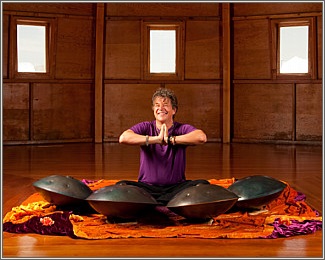 James Hood: Angelica and Biorhythmetic were entirely improvised by what I call stream of consciousness playing where I become mesmerized by the beauty and subtlety of the sound until I simply lose track of time.
James Hood: Angelica and Biorhythmetic were entirely improvised by what I call stream of consciousness playing where I become mesmerized by the beauty and subtlety of the sound until I simply lose track of time.
With the more rhythmically melodic tracks, I wouldn’t say “from a composer’s song sheet” but I already had some melodies planned and grooves in my head when I got to the Integratron and then it just developed on the day from there.
The entire 2 hour double album was recorded in just 2 days and not much longer than that to mix down back at my place. I don’t know what happened here to be honest, ask anyone – I’m the guy who takes 4 years to make a Moodswings album!
John: The music you produced on Ceremony is near opposite in composition to the music you produced with your ambient electronic group, Moodswings, and band the Pretenders. Other people will be writing about your work so your own words James, how would you best describe your music compositions today?
James Hood: I actually don’t agree that they are completely the opposite of Moodswings. It’s simply a different sonic vocabulary. In the Pretenders, apart from a couple of co-writes, I was simply the drummer. Despite the fact that Moodswings and Ceremony sound so different, they were actually written in a similar process.
It starts with hearing a melody or a groove in my head, something that evokes that feeling of something timeless and magical. It’s just that it is found through utterly different musical modalities – really the difference between finding beauty through the digital or the analog. In the case of Ceremony by playing a concave metal plate or with Moodswings by firing off billions of samples!
John: What were the circumstances or events where you discovered the PanArt Hang for the first time, and why did you become interested in this exotic percussion instrument?
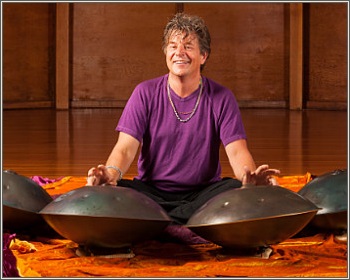 James Hood: I was at a drum circle at a British music festival. Someone had one and it was love at first sight. Having been a drummer my whole life, I was very interested in a percussion instrument that was so melodic – or a melodic instrument that was so percussive!
James Hood: I was at a drum circle at a British music festival. Someone had one and it was love at first sight. Having been a drummer my whole life, I was very interested in a percussion instrument that was so melodic – or a melodic instrument that was so percussive!
The sound totally mesmerized me, made me feel instantly inspired and elevated. Why wouldn’t you want to play that instrument every day? I immediately started imagining first how to play it both very fast and very lightly to create a sort of watery rhythmical momentum that I felt would be very mesmerizing.
It took me a few years to find out while I built up the finger strength, because to hit the drum consistently softly strangely takes more strength than hitting it hard. I had to train my right arm to be stronger so that I could play completely evenly which is more comforting on the ear.
John: There are several variations of the PanArt Hang since its creation by Felix Rohner and Sabina Scharerin in the year 2000. At your official JamesHood.com website you describe the PanArt Hang as a musical instrument with seven holes, and a dome in the middle. Included in our interview together are photos, but could you describe the instrument in more detail and explain the variations of this exclusive instrument?
James Hood: When PanArt first released the first generation of Hang drums, which are still my favorite, they were very adventurous with the range of tunings, both Western and Eastern scales were experimented with. This allows me like a harmonica player, to play in multiple keys. The second generation, they reduced the range of tunings and although I have a second generation hang that I love, I think the first generation are the most magical of all PanArt products.
John: What version do you play with live performances, and why have you selected this specific version?
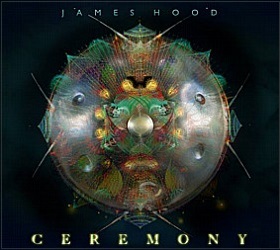 James Hood: I perform with a first generation Pentatonic F (Metal Ambulance, Sonic Ashram, Friendly Alien), a first generation Pentatonic C (Sweet Acceptance, Imaginary Friend, A Goat Called Lavendar Angelika).These two are both very light with a beautiful chime. The second generation D Minor Pentatonic (Cherry Mandala, Fey Bedouin) is much warmer in tone, darker and almost sultry.
James Hood: I perform with a first generation Pentatonic F (Metal Ambulance, Sonic Ashram, Friendly Alien), a first generation Pentatonic C (Sweet Acceptance, Imaginary Friend, A Goat Called Lavendar Angelika).These two are both very light with a beautiful chime. The second generation D Minor Pentatonic (Cherry Mandala, Fey Bedouin) is much warmer in tone, darker and almost sultry.
John: In terms of the music you produce today, was making a transition from more popular forms of music to a niche genre like new age music a challenge for you, or was the change a relatively easy one to make?
James Hood: It was both. Having produced music from an almost infinite palate of sounds, it was refreshing to limit myself to one instrument. It certainly made completing a record that much faster. But I was also aware of a sweet momentum with “CEREMONY” – everything just flowed.
As a producer it didn’t feel at all limited to just use one instrument because by using different microphones and certain different sonic approaches. I found I could get a very wide variety of sounds.
And something extraordinary started to happen when I overdubbed a couple of different parts with the same drum. I started to hear wonderful harmonics that were simply the sum of all the individual parts – sometimes I thought could hear angelic voices and washes that are entirely a sonic mirage, caused by the pure harmony of the overtones in the metal.
I have become used to really taking my time over completing a record. I am perhaps a little bit of a perfectionist. Recording with the PanArt Hang was like learning how to produce in a different way. Because it already sounded pretty perfect in its raw form, whereas I suppose in the past I would spend a huge amount of time trying to polish samples to get to the same glistening effect that the Hang does so naturally.
I never listened back to much in the studio but would rather do a rough mix-down and then go listen to it in a normal environment like my car or in the kitchen. For some reason, I was unable to make decisions regarding the pacing or progress of a track in the usual studio environment. As soon as I took it out of the studio, it made more sense. It’s a different kind of music that wants to be part of scenery – like sonic incense.
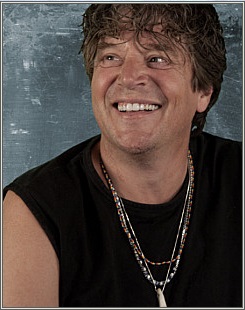 John: I would imagine most musicians know from experience, what may appear to be an easy instrument to play is often more difficult than it looks, and vice versa. Is playing the Hang difficult, or is the instrument pretty forgiving, and relatively easy to play?
John: I would imagine most musicians know from experience, what may appear to be an easy instrument to play is often more difficult than it looks, and vice versa. Is playing the Hang difficult, or is the instrument pretty forgiving, and relatively easy to play?
James Hood: I think it is fairly easy to sound okay on the Hang pretty fast if you know how to play a steady rhythm. Some people hit it and can’t really get a sound out of it. It’s best if you have pretty rubbery wrists! If you have to learn both all about playing rhythm and getting a sound out of the hang, I think it would be pretty challenging.
Since I already knew the rhythm bit, it was just learning the technique of how to hit the Hang. Some people can just pick the hang up, hit it and it sounds nice. But a lot of people, when they first hit the hang, it makes no sound at all, just a dull metallic clunk.
John: In relation to being a solo instrumental performer, what are the main components that set your music apart from other musicians who perform on a hand played solo instrument?
James Hood: I think I play softer than most people. I am obsessed by the gossamer light warm tone that the instrument emits when stroked very lightly. I also don’t think a record quite like this has ever been made, apart from a couple of solo performances.
Most of this record is a veritable orchestra of interweaving hang parts intricately pieced together rather like making sonic jewelry – then add into the mix (literally), a brilliant warm old valve microphone that we recorded everything on and of course the extraordinary sounding place we recorded everything – love it or not, it’s undeniably a pretty unique album. What I am trying to achieve with this instrument is to find sacred sonic moments that warm the heart and make time stand still for a while. I consider the Hang to be sacred, created by a small company with an inspired pure intention to reach the divine.
John: The sound qualities of a PanArt Hang are quite unique, possessing tonal qualities apart from all other percussion instruments, including the Steel Pan or Steel Drum percussion instruments, and other directly struck, or hand played idiophone. How would you describe this unique sound?
James Hood: I feel it is the sound of perfection, a simple pure ringing tone that sweeps thru the body and I think for other people it is the same. People react instantly when they hear it! I feel the sound has an almost primordial quality, a thin piece of welded iron that sings with a compassionate grace.
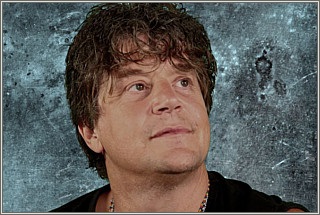 John: In addition to your current studio album Ceremony, you plan to perform live on stage playing the PanArt Hang. Are there any obstacles for you to overcome while performing a live solo act?
John: In addition to your current studio album Ceremony, you plan to perform live on stage playing the PanArt Hang. Are there any obstacles for you to overcome while performing a live solo act?
James Hood: My approach is rather like that of a classical Indian musician or those who play kirtan, in that I aim to birth a devotional sacred atmosphere that speaks to the warm sensitivity in people.
Live I also perform with beautiful immersive visual accompaniment going on around me, mostly created by a brilliant Russian artist, Tatiana Plakhova from complexitygraphics.com to encourage the mind to swim in this ecstatic reverie of pure sound and light.
The combination of the sound and the images form a powerful transformative experience that aims to help people fall effortlessly into that intimate pure inner space within them self where they can really access their own power and clarity thru this instrument.
When I perform my intention is first to try get out of my own way mentally and allow myself to be in a trance by the sound. If I can get there it’s more likely that that energy will transmit to the audience. There can be no stress in my mind when I’m playing the Hang. Luckily the amount of time that I have played the Hang now and the mesmerizing effect of the sound usually helps me to get into a sort of trance and awe which can have a powerful effect on both me and the audience!
John: Obviously the concert venues you will be performing at will be a lot different than say, The Pretenders and Moodswings. What venue setting would be a likely venue for you to perform live solo music, and who would one contact to book you for a performance?
James Hood: The ideal setting is an intimate seated, comfortable warm environment with lots of wood, where there is no background noise (like in a theater or cinema). You’re right in that this is a very different type of show to what I have previously done in my musical career. Simply put, I’m trying to calm people’s heart rates down rather than whip them up into a frenzy of rocking excitement.
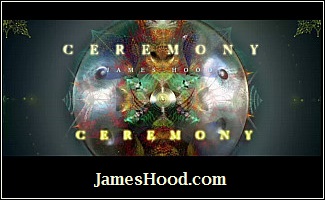 John: I try to provide music news coverage for an artist’s fans if possible, so do you have any press information about upcoming events, your solo work or news related to Moodswings?
John: I try to provide music news coverage for an artist’s fans if possible, so do you have any press information about upcoming events, your solo work or news related to Moodswings?
James Hood: Just keep an eye on www.jameshood.com and my Facebook page https://www.facebook.com/jameshoodmusic all news will be posted there. It’s also worth keeping an eye on YouTube because I will be posting regular improvisations and other sonic snippets because I am recording all the time and it has to keep flowing out so as to make a space for the new to come in!
John: In closing I want to thank you again for agreeing to our interview James. I am pleased to present your newest interview for your fans and visitors. I hope we have a chance to visit again to update everyone on current news about you.
James Hood: It has been a pleasure! Thank you so much for your interest and support. I appreciate you and everyone who can help me reach as many people as possible with this unusual music, because this instrument needs to be heard and not many have. There are not many undeniably and uniquely beautiful things in this world, something whose beauty you can’t deny and the PanArt Hang is such a thing! It has been such a joy to learn its ways, it has already changed me for the best and I feel I am just getting started. This instrument is like a fractal-the deeper you go into it the more it reveals!
Visit JamesHood.com for more news and information. You may also sample and purchase Ceremony at Amazon.com. Follow current news and events at James Hood Facebook page. Photos and album cover art courtesy jameshood.com.

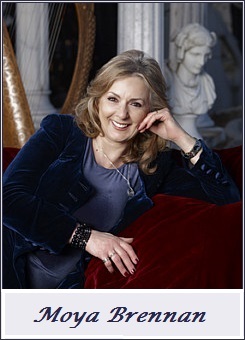 Publicist and blog host John P. Olsen had an opportunity to interview famed singer, harpist and instrumental recording artist from Ireland, Moya Brennan.
Publicist and blog host John P. Olsen had an opportunity to interview famed singer, harpist and instrumental recording artist from Ireland, Moya Brennan.
During this interview taking place during the summer of 2013, a variety of in-depth topics are covered. Included is a conversation about her new vocal and instrumental album with professional harpist Cormac De Barra titled Affinity. Moya Brennan also details aspects of her life and solo career, and of the Celtic music group Clannad.
Recognized as the First Lady of Celtic Music, and The Voice of Clannad, today I am pleased to present an informative interview conversation with the famed Irish musician, Moya Brennan.
John P. Olsen: Thank you for accepting my interview invitation Moya! Interest in your music has grown tremendously over the years, and you have a wonderful story to share. Like your fans, I am a longtime admirer of the music you have produced too, so it’s a privilege to host your newest interview for fans and visitors in 2013, here at New Age Music World.
Shall we begin our conversation with the topic of your brand new album with Cormac de Barra titled Affinity. Your newest album is now available at your Voices & Harps website, and currently available at major music stores like Amazon and iTunes. I have been listening to Affinity non-stop, and consider it to be one of your best albums yet. It makes me curious to know if others share the same view as I. What is the feedback you have received so far on your newest album, and is the response what you expected?
Moya Brennan: John, thank you for your kind words about Affinity and I’m so glad you are enjoying it. You’ll be pleased to hear that you are not alone in reacting to Affinity in such a way. Feedback has been really positive (and sometimes verging on the superlative!) To say that this is what we hoped for would be spot on but what we expected? I’m not sure.
Of course we are supremely proud of the album but I have been working for long enough to know that you can emerge from the bubble of the studio thinking you have redefined the musical universe, only to discover that the rest of the world doesn’t necessarily share your feelings. All I know is that the musical partnership I have developed with Cormac is far greater than the sum of the parts and that our song choices, arrangements and performances are of the best we both have to offer.
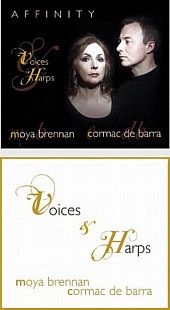 John: Affinity is the follow-up album of your earlier release with harpist Cormac De Barra titled; Voices & Harps. Another fine release I might add. What would you say are the distinctions in theme and melody in comparison to your newest release?
John: Affinity is the follow-up album of your earlier release with harpist Cormac De Barra titled; Voices & Harps. Another fine release I might add. What would you say are the distinctions in theme and melody in comparison to your newest release?
Moya Brennan: To give you some background, Voices & Harps was recorded on an inspired whim! That’s not to say we didn’t put our hearts into it. More that it was something we’d been talking about doing for several years and a little three-week window opened up early 2011, which we jumped through and emerged with our first V&H album. We sat back and listened to it in the cold light of day and were thrilled to have achieved so much in such a short space of time.
As with Affinity, I think we surprised a few people – and ourselves. Cormac has been quite a significant force for me rediscovering the beauty and purity of my traditional roots. In my solo work I have explored quite a lot of contemporary forms along with musical influences from around the world – for instance Eastern Europe and Africa. Cormac’s repertoire and knowledge of the Irish tradition is incredible so this was always our starting point.
The theme of Voices & Harps was as simple as the title. I arrived with my voice (and harp) while Cormac arrived with his harp (and voice). Sounds funny but we both came to each other with the same skills, albeit with different emphasis respectively. We chose some songs and tunes that we both had been performing already, some which we had always wanted to record and we wrote others which encompassed my approach to atmospheric vocal layers with a harp foundation.
When we came to record (what turned out to be titled Affinity) the approach was similar but with attitude made bolder by our happiness and reaction to our first album. We were actually going to call it Voices & Harps II but realized that the title, Affinity, once again, summed up our performing relationship and the blending of our musical skills.
John: What is the creative drive behind your newest album composition Affinity?
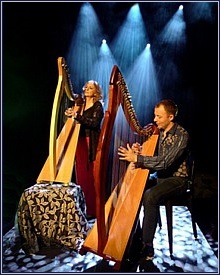 Moya Brennan: Echoing what I said previously, our creative inspiration is a bringing together of what we do well! Maybe, more than anything though we let ourselves go a bit more than before. Sure, there are absolutely beautiful songs which we both of learned from our grandparents – Ardaigh Cuan from my grandmother and Seoithin Seo from Cormac’s – but we felt we had the confidence to write new songs as well.
Moya Brennan: Echoing what I said previously, our creative inspiration is a bringing together of what we do well! Maybe, more than anything though we let ourselves go a bit more than before. Sure, there are absolutely beautiful songs which we both of learned from our grandparents – Ardaigh Cuan from my grandmother and Seoithin Seo from Cormac’s – but we felt we had the confidence to write new songs as well.
While we both grew up surrounded by traditional music we have also been open to a wide range of musical influences. So there is the dreamy, trancy ambience of song Suas Sios, and a contemporary slant to Worlds Collide and I Feel You Breathe.
I should also mention The Lass of Aughrim, from Affinity. I was invited to perform at a Galway alumni dinner in New York last year. The Galway Association were to honor Angelica Houston as part of the ceremonials. I had always been moved by her part in the John Houston movie, The Dead, based on a James Joyce short story.
This song appears at one of the most poignant moments in the film and I heard that she loved the song. It brought her to tears at the dinner and afterwards she said that we must record it. So we did and have her to thank for encouraging us.
John: The chart topping hit song Sailing by Christopher Cross is a lead single on Afffinity. I read in a press release the cover song Sailing holds special meaning to you on a personal level. What is the personal significance of the song Sailing?
Moya Brennan: Hey, I think what I said is that it was part of the soundtrack of my youth. So in the respect that it will forever bring me back to that stage in my life I’m not saying it has any emotional or cosmic significance! It’s a beautiful song and an unusual song. Cormac and I had been toying with the idea of doing a cover song and we were nearing the end of the process of choosing our final selection.
I was driving back from a concert in Cork and just as I pulled into the house in Dublin Sailing came on the radio. I had my daughter, Aisling (my band guitarist and album studio engineer), in the car and we sat and heard it out. I wondered how it would translate to harp and vocals but when Cormac came in the next morning he played around with the intro on the harp (some devilish key changes) and eventually broke through to provide the song with familiar, but new, bedrock.
Lyrically, it’s a song of hope and dreams – subjects that I love to visit in songs anyway. As you can imagine, our cover of this song has surprised a lot of people but nobody has said that it feels out of place among the others.
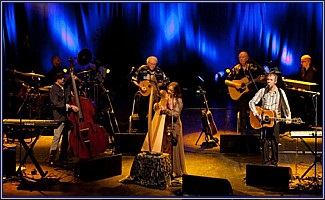 John: Harpist and television host Cormac De Barra is also a member of your band and the group Clannad. In addition to the numerous albums you and Cormac have produced together you each have achieved successful solo careers. How did you and Cormac meet and form a professional team Voices & Harps?
John: Harpist and television host Cormac De Barra is also a member of your band and the group Clannad. In addition to the numerous albums you and Cormac have produced together you each have achieved successful solo careers. How did you and Cormac meet and form a professional team Voices & Harps?
Moya Brennan: In 2004 I recorded my Two Horizons album. This, more than any other recording I have made, was a concept album. Starting with the Thomas Moore song, The Harp that Once Through Tara’s Hill, I developed a story line bringing a mythical harp through the ages, through slavery in Africa and emigration to the wilds of an American desert populated by native women played the harp in their traditional ceremonials.
My (then) musical director Fionan De Barra, introduced me to his brother, Cormac, whose harp playing instantly provided a fullness to my stage setup. We have worked together ever since and discovered an interesting fact that less is more. It is such a resonant and powerful instrument that often, very little else is needed.
John: During the course of your music career you have toured extensively in many parts of the world. Would it be fair to say you simply adore the personal interaction with an audience while performing live shows?
Moya Brennan: I absolutely love it. My father spent his life on stage – firstly in a traveling show band and then as host in his own music pub in County Donegal – and I’m convinced that I take after him. I love the way that you can engage an audience and draw them into your world – even if they are unfamiliar with your work. I love bringing people to another place in shows (even for ninety minutes) and hearing how afterwards how they were able to shake off their stress and troubles for that short period as they became absorbed in what was coming from the stage.
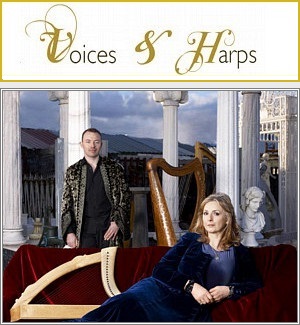 John: Even today you perform live concerts, and recently gave a Voices & Harps Workshop last month. Could you tell everyone about your live performances and provide details about the workshops?
John: Even today you perform live concerts, and recently gave a Voices & Harps Workshop last month. Could you tell everyone about your live performances and provide details about the workshops?
Moya Brennan: Cormac and I do the workshop every June and have just completed our third year running. This year was a sell out! We keep to limited numbers in order to give everyone direct and personal attention. I work through a choice of songs with some and Cormac works on harp tunes with others. At the end of the weekend the two meet in a thrilling showcase. I say thrilling deliberately because I see people who have walked in on the Friday with virtually no experience singing and playing on stage for the first time and literally going through a life changing experience.
John: What song selections can a concert attendee expect to hear during a live concert with Moya Brennan?
Moya Brennan: I think I gave a taste of that in an earlier question. I like to create an atmosphere which frees the mind and spirit of an audience. But in a more practical sense Cormac and I obviously play much of our Voices & Harps repertoire, I have a number of solo favorites and, of course, I do visit some of the Clannad classics from time to time. There’s a bit of everything – from quiet atmosphere to rousing Irish trad sets.
John: Music has been a part of your life from the beginning, with many notable achievements along the way. What would you say was the turning point where you knew you were a career musician with a professional career ahead of you?
Moya Brennan: You’re right, it started early! I used to go off to Scotland with my father’s band at the age of seven to perform on St. Patrick’s Day. There were two significant moments in our (Clannad’s) career which convinced us that we had this calling. In 1970 we came first in the prestigious Letterkenny Folk Festival. The prize was to record an album which turned out to be Clannad 1.
 Our music was almost exclusively in the Irish language and, strange as it may seem now, nobody in Ireland wanted to listen to songs in their native language. So we’d go off to Germany in a battered van and drive up and down the autobahns playing to audiences who couldn’t get enough of it! Yes, bizarre!
Our music was almost exclusively in the Irish language and, strange as it may seem now, nobody in Ireland wanted to listen to songs in their native language. So we’d go off to Germany in a battered van and drive up and down the autobahns playing to audiences who couldn’t get enough of it! Yes, bizarre!
In 1978, during a German tour, we received a standing ovation in the classic Bremen Town Hall. As we glowed in the dressing room after the show we suddenly realized we could do this as a career and returned to Ireland as a professional band.
John: There are a number of original songs on Affinity sung in Gaelic, which is the native Irish language. It is in part a reason for the surge in popularity taking place during your solo career, and of the group Clannad, in which you are a founding member. What is it about the Gaelic dialect, blended with melodic themes that have generated so much interest?
Moya Brennan: As I said above, there was a time when we were actively discouraged from singing Gaeilge songs. Ireland of the seventies was only forward looking and chose not to think about its traditional culture. Thankfully, things changed slowly and we are so pleased we stuck to our principles and language. Irish is a very different to other European languages.
It allows us to reflect images of our natural surroundings in a true way. Many of our songs celebrate the sea, mountains and ruggedness of our native Donegal. I’m so proud of my language and it combines beautifully with my music.
John: Clannad’s influence on the merging of traditional Celtic and pop music, including Celtic Fusion in the 1980s and 1990s cannot be overstated. I read at the Clannad.ie website that a new follow-up album to Clannad at Christ Church Cathedral CD & DVD is scheduled for release in September of 2013. Can you provide any news or information regarding the new Clannad album for 2013?
Moya Brennan: I do believe we were pioneers in bringing Celtic music to a wider audience with contemporary influences and instrumentation. Although it didn’t make us popular with the trad community at the time, it’s interesting to see how the form has been followed, imitated and developed into a distinct musical genre. We have just finished recording a new Clannad album – the first studio album since 1997. It will be released in September this year and the title is under wraps for now.
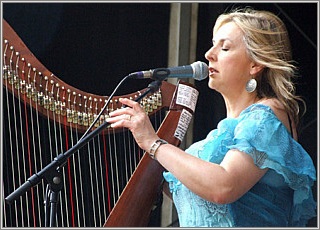 John: You have enjoyed a stellar music career with many successes, awards and recognition along the way Moya. What do you find most rewarding intrinsically as a professional concert and studio musician?
John: You have enjoyed a stellar music career with many successes, awards and recognition along the way Moya. What do you find most rewarding intrinsically as a professional concert and studio musician?
Moya Brennan: It has to be winning the Letterkenny Folk Festival in 1970. I know there have been many other incredible moments but this probably changed my life more than any other.
John: Would you like to tell us about your charitable endeavors and work as a goodwill ambassador, and why is philanthropy important to you on a personal level?
Moya Brennan: I hope that what I do comes from my heart and in that applies equally to my music and my charity work. Like anyone else, I am seriously humbled by those who dedicate their entire lives to helping the disadvantaged and downtrodden. I do get asked to be involved in far more than I am able to take on so one thing I have chosen is to broaden awareness of the disability charity, CBM.
Although they originally set out to work with blindness they have come to realize that lack of sight is just one of a number of common disabilities in the developing world which leaves its sufferers as marginalized and hidden in their communities. As a Goodwill Ambassador I have traveled in Africa and South America to see CBM’s amazing work and bring back my experiences to remind people how fortunate they are and how much needs to be done to provide decency and respect for the disabled.
John: I know for a fact that artists at various stages of their music careers will read our interview Moya. One question I always like to ask a highly successful artist like yourself is; would be willing to offer any helpful suggestions about the music business, or offer some words of advice to artists just beginning their music careers?
Moya Brennan: The music business has changed so much since I started. There was once a time when we could survive quite well just on record sales. Those days have gone and it has become far more important to get on stage and engage your audience in a live setting.
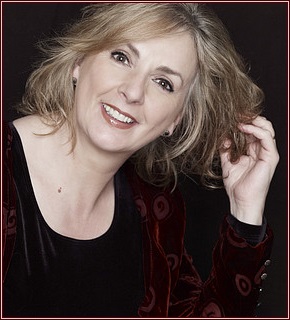 But the universal truths still remain: Believe in what you’re doing, don’t be discouraged by rejection, remain true to your art, practice your instrument (or voice), share ideas with others you trust and learn how to express them to a wider audience.
But the universal truths still remain: Believe in what you’re doing, don’t be discouraged by rejection, remain true to your art, practice your instrument (or voice), share ideas with others you trust and learn how to express them to a wider audience.
John: As a publicist I like to report on current music news information when I can, so I would like to ask if you have any press information you would care to pass along about additional album projects or upcoming special events you plan to make public soon?
Moya Brennan: I am currently planning a Christmas tour in the USA in December. Final details have yet to be settled but will appear on my website in due course. I recorded a Christmas album a few years ago and, amazingly, it hasn’t dated over the years. I normally tour it in Europe so this will be the first time American audiences will experience An Irish Christmas.
John: I look forward to providing more information when available Moya, and must say you have experienced a fascinating life and career. It has been a privilege to host your newest interview in 2013 and I wish you continued success in the years ahead. I hope we have a chance to visit again to update everyone on the current news about you. In closing for now, is there anything you would like to express to our readers, and fans that have supported you throughout your career?
Moya Brennan: Nothing but immense thanks and appreciation for letting me do what I enjoy and share it with fans. Their loyalty, friendship and encouragement are what keep me going.
Moya Brennan and Cormac De Barra’s new album Affinity is currently available in physical CD format and Mp3 format, or single song downloads at VoicesAndHarps.com. You may sample and purchase the 12 songs on Affinity at Amazon.com and find the album or single song downloads for Affinity at iTunes.
Find albums and concert info at MoyaBrennan.com. Interview photos courtesy moyabrennan.com & voicesandharps.com.

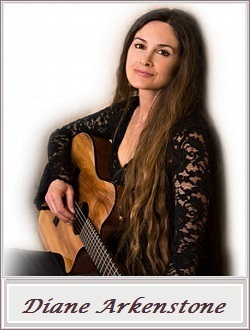 Interview in 2013 with contemporary artist Diane Arkenstone.
Interview in 2013 with contemporary artist Diane Arkenstone.
New Age Music World interview host and publicist John P. Olsen had a recent opportunity to interview the popular, multi-platinum selling singer, songwriter, and contemporary instrumental recording artist Diane Arkenstone.
During this interview taking place near the spring of 2013 a variety of in-depth topics are covered. Included is a conversation about Diane Arkenstone’s soon to be released album titled Union Road, and the contributing artists who have helped transform her newest vocal and instrumental release into one of her most captivating albums produced to date.
Diane Arkenstone also replies to questions about her experiences as founder of the Neo Pacifica Recordings Label, and the meaning behind the formation of artist titles she has released in a variety of music styles.
Today I am pleased to present an informative and lighthearted conversation with one of today’s leading, and most beloved producers of contemporary music covering a wide variety of instrumental styles.
John P. Olsen: Thank you for accepting my interview invitation Diane! It’s a privilege to host your newest interview for fans and visitors in 2013, here at New Age Music World. I can honestly say I have been a fan and admirer of the music you create for years so our interview is especially rewarding to me!
Diane Arkenstone: Hi John! Thank you so much for your very kind words, I am smiling! And thank you for this wonderful opportunity to connect with everyone here!
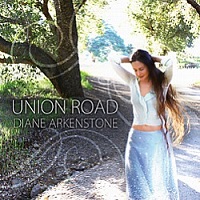 John: Let’s begin our conversation with the topic of your brand new album Union Road, due for release next week on March 26, 2013. Earlier this year I wrote a pre-release review for Union Road, I believe it’s clear by what I wrote, I felt your newest release of contemporary Folk ballads is indeed special! Beautiful in every way, Union Road is a uniquely personal album with special meaning to you too, isn’t that right?
John: Let’s begin our conversation with the topic of your brand new album Union Road, due for release next week on March 26, 2013. Earlier this year I wrote a pre-release review for Union Road, I believe it’s clear by what I wrote, I felt your newest release of contemporary Folk ballads is indeed special! Beautiful in every way, Union Road is a uniquely personal album with special meaning to you too, isn’t that right?
Diane Arkenstone: Yes, this is my most personal album yet because the lyrics I wrote are of stories and observations I have personally experienced. I am a story teller and have always loved to write about life which made this album a great joy to create. And a even greater catharsis.
John: Who are the instrumental artists performing with you, and what are their individual contributions which have helped make your release an exceptional album?
Diane Arkenstone: Mader, who is a wonderful film composer from France, and has scored two films for Ang Lee, among many others, produced most of the album with me, and played a wide and wonderful variety of instruments such as mandolin, bass, keyboards, accordion, various percussion instruments and guitar.
MB Gordy, who is a wonderful percussionist and studio musician, played beautiful and exotic percussion on quite a few of the songs as well. Chad Watson, who has played with many, many well-known artists, played bass, and I watched spellbound, as his hands danced all over his fretless bass on several songs.
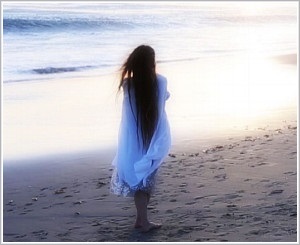 Eric Rigler, who played the pipes in the film score, The Titanic, added magic with his penny whistle on the first song, Little Cup of Coffee.
Eric Rigler, who played the pipes in the film score, The Titanic, added magic with his penny whistle on the first song, Little Cup of Coffee.
David Arkenstone played guitar, bass, keyboards and percussion magnificently, and helped produce a couple of the songs with me for the album. Charlee Brooks and Jane George added beautiful background vocals on two of the songs.
And then, Bruce Watson played some amazing guitar on a couple of songs and has played with many well-known artists for quite a while himself. They are all truly unique and gifted artists in their own right and I am deeply grateful for each and every one of them.
John: Union Road is an instrumental and vocal album with lovely poetic lyrics. Would you like to tell us the point of view you are expressing by lyrical verses?
Diane Arkenstone: Very simply, thru lyric and song, I am telling the stories of situations that I have personally observed in life.
John: Album reviews from other sources and press commentaries are coming in, plus you have given a number of new interviews including Blog Talk Radio and KSBR 88.5 FM Jazz. How is the reception of your new release been so far?
Diane Arkenstone: Oh my gosh, it has been a huge happy welcoming committee! I wrote 77 songs for the album and truly just grabbed a handful of songs that seemed to fit well together and am pleased and elated by the reviews and press!
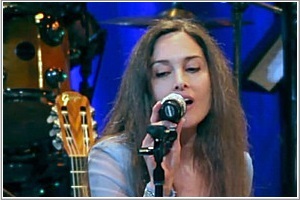 John: I am not surprised but that’s great news Diane! Union Road is a brilliant album in every way, unique to your earlier releases, and I read there is an earlier first album of contemporary folk songs too. Would you please tell us all about this earlier first album?
John: I am not surprised but that’s great news Diane! Union Road is a brilliant album in every way, unique to your earlier releases, and I read there is an earlier first album of contemporary folk songs too. Would you please tell us all about this earlier first album?
Diane Arkenstone: Thank you John for saying that about Union Road! And yes, I released an album in digital format called, Stories. It is a cross between my earlier releases and the Folk/Americana feel of Union Road. It also is an album that sings of stories of life’s observations.
John: In addition to the studio albums you also perform live concerts. This must be an exciting time for you since you are about to begin an extensive tour this spring. Would you give us the details like the concert venue locations and artists who will be performing with you?
Diane Arkenstone: Right now, I am finishing up a number of music projects, so touring may be a bit delayed.
John: Do you have a song set list selected, and in terms of atmosphere and setting, what can a concert attendee expect to experience during a live concert with Diane Arkenstone?
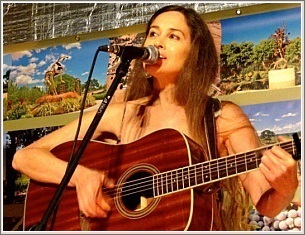 Diane Arkenstone: The songs will be from Union Road of course, plus a few unreleased songs where I play some interesting and exotic instruments and sing. And the band is a group of dear friends who are wonderful studio and touring musicians. Lots of beautiful music, good energy and love, will be present for every show!
Diane Arkenstone: The songs will be from Union Road of course, plus a few unreleased songs where I play some interesting and exotic instruments and sing. And the band is a group of dear friends who are wonderful studio and touring musicians. Lots of beautiful music, good energy and love, will be present for every show!
John: The artist titles you have either founded or performed in are; Ah Nee Mah, Earth Trybe, Enaid, Adventure Cargo, Marquis Ensemble, Middle Earth Orchestra, and naturally as the duo with former husband David Arkenstone. What are the distinctions of these artist titles?
Diane Arkenstone: ‘Ah Nee Mah’ is our Native American music, inspired by my Cherokee heritage and our love of playing Native flutes and percussion. David and I lived in the Southwest for a few years, next to several reservations and lived a very interesting and beautiful life there.
We wrote several ‘Ah Nee Mah’ albums during that time, which are still selling quite well. And ‘Earth Trybe’ is beautiful world music where we had fun writing and playing many unusual and interesting instruments from around the world. And ‘Enaid’ is Celtic music, and I came up with that name by reversing my first name and then surprised to find out that is means, life/soul in old Celtic/Irish.
‘Adventure Cargo’ is more world music, with more wild instruments, and beautiful songs. The last album for ‘Adventure Cargo’ is called, Following The Equator and it has songs on it that represent the countries along the Equator. It was great fun for me learning about all the countries along the Equator then writing songs for a special place or landmark in each country.
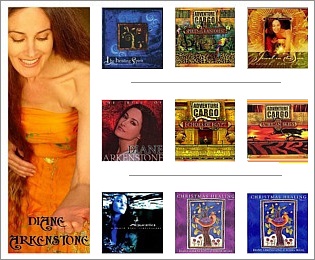 ‘Marquis Ensemble’ is lovely, sweet piano music. Reflections from the Wine Country was the first album under the alias, ‘Marquise Ensemble’ and was inspired by my family’s winery. And ‘Middle Earth Orchestra’, is music inspired by the book, The Hobbit.
‘Marquis Ensemble’ is lovely, sweet piano music. Reflections from the Wine Country was the first album under the alias, ‘Marquise Ensemble’ and was inspired by my family’s winery. And ‘Middle Earth Orchestra’, is music inspired by the book, The Hobbit.
John: In the 1990’s you founded Neo Pacifica Recordings Label. Would you tell us some aspects of owning your own record label, including the advantages and obstacles to this business venture?
Diane Arkenstone: It has been a great advantage for me, to have my own record company; it is a lot of work but stretched me to new heights in terms of experience and knowledge.
I appreciate the work the major labels do, which is tremendous, but I navigate these waters quite successfully, and prefer knowing what the expenses are and what is going on with manufacturing, distribution, licensing, marketing, publicity, publishing and especially royalties. It is a great sense of accomplishment and freedom, to truly own your music, and do with it as you wish.
John: On the subject of record labels, I read your biography at the Eversound Music Label website where it states; “Diane Arkenstone wrote her first song at the age of three, played piano at five and picked up her first guitar at the tender age of seven.” I am curious to know if you aspired to become a musician at a young age too, or in other words, what were the circumstances surrounding your decision to pursue a career in music?
Diane Arkenstone: I loved writing music at a very young age, but also had a great desire to be an Olympic runner. I worked extremely hard at running but could not keep up with anyone. Music came much easier, and I learned that if you have to force something, it is not right to begin with.
As it turned out, after I kept passing out, we discovered I was born with a ‘special heart’ that required a lot of surgeries to fix things. And along the way since childhood, I have had six pacemakers. The seventh pacemaker and more surgeries are due in a few years. Life is precious.
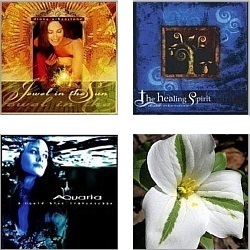 John: I didn’t realize the challenges you face Diane, and we all wish you well. The music industry as a whole has greatly changed since you began producing music early on to the present. What observations have you made over the years, and what changes in the music industry have affected you most?
John: I didn’t realize the challenges you face Diane, and we all wish you well. The music industry as a whole has greatly changed since you began producing music early on to the present. What observations have you made over the years, and what changes in the music industry have affected you most?
Diane Arkenstone: My observations come from a unique vantage point. Having my own label and releasing dozens of albums under different aliases and different genres, I created a lot of niche markets for the music in the mainstream and alternative markets, and it is all still going strong today. And for me, the digital world has been a great success for so many reasons.
John: You have enjoyed a wonderful and successful music career for many years Diane. You are a source of admiration for millions of fans and even colleagues in the music industry alike. What would you say is the best part of being a highly successful, contemporary artist?
Diane Arkenstone: You are so sweet John to say that, thank you! Truly though, I am unaware of such a thing because every day I put one foot in front of the other and focus and do my very best with whatever project is at hand.
John: Well Diane, fans truly adore you, plus you are a role model for many artists. Knowing artists at varying stages of their music careers will read our interview; do you have any words of advice to artists just beginning their music careers?
Diane Arkenstone: If you have a dream, follow it! Be prepared for long hours and depend on yourself as much as possible, and then all that energy you put into your career, will reward you greatly in countless ways. When you are passionate about something, every door you need to walk thru will open, even the ones you have no clue about.
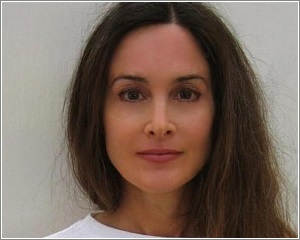 John: Being a prolific artist Diane you have an extensive collection of excellent albums to choose from. I have my favorite albums and songs, and your fans likewise have their favorite albums.
John: Being a prolific artist Diane you have an extensive collection of excellent albums to choose from. I have my favorite albums and songs, and your fans likewise have their favorite albums.
I realize this is a never an easy question for an artist, but for persons new to your music, what 3 albums other than Union Road is a starting point to begin sampling your many outstanding releases?
Diane Arkenstone: Oh my goodness, I love them all! Let’s see, Jewel In The Sun, The Healing Spirit & Aquaria: A Liquid Blue Trancescape, which are all so very different from each other.
John: I would like to thank you again for your generosity by giving fans and myself this opportunity to find out more about you, and your newest projects Diane.
I hope we can get together by another interview someday. Before we close our conversation for now, is there anything you would like to express to the fans that have supported you over the years?
Diane Arkenstone: First of all, thank you again from my heart, John, for this wonderful opportunity to connect and share with everyone, it means the world to me. And I very much look forward to more interviews with you!
And to every beautiful soul who has supported my music, I am deeply grateful beyond words. A million thanks, and a million blessings. And please always be compassionate and loving towards yourself and towards others, it is our most valuable currency and reason for being, for truly, we are all one.
Visit DianeArkenstone.com and discover a great selection of albums in her store download section. Sample and purchase albums and songs by Diane Arkenstone at Amazon.com & iTunes.com. Photos & artwork courtesy dianearkenstone.com.

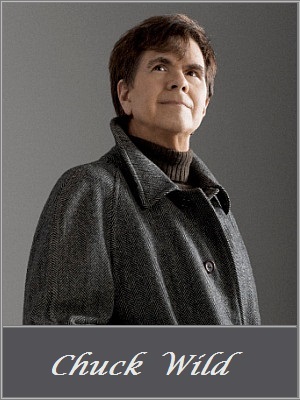 New Age Music World interview host and publicist John P. Olsen had an opportunity to interview songwriter, recording artist, and Liquid Mind Musical Healthcare® experience developer Chuck Wild.
New Age Music World interview host and publicist John P. Olsen had an opportunity to interview songwriter, recording artist, and Liquid Mind Musical Healthcare® experience developer Chuck Wild.
John P. Olsen: Thank you for accepting my interview invitation Chuck. It’s a privilege to host your newest interview in 2013!
Chuck Wild: Hi John, thanks for the insightful questions, I appreciate the opportunity to talk about my journey in musical healthcare.
John: My admiration for your work began when you were a member of the phenomenal new wave pop band Missing Persons, and years later when you transitioned to the highly successful artist title Liquid Mind. Let’s begin with your earliest experiences as a musician Chuck. How did your music career begin prior to joining Missing Persons?
Chuck Wild: I grew up in Kansas City, Missouri, and began playing piano at age four. I was diagnosed with a congenital hip problem (which was completely resolved by age eight), but back in the 1950’s the only cure was to remain off my feet for a full year. My parents hired a wonderful caregiver for me for that year, and she used to carry me down to the piano every morning and teach me how to play.
By the age of five I was permitted to walk with a brace for about a year, but the piano already had me hooked. By age six, I was mobile, and my heart’s desire was to sit behind the church organist at our church, so my folks arranged for me to spend all morning most Sundays with our organist, Gladys Hamilton Combs. After services, Gladys would sometimes let me play the giant Kilgen organ which had 39 ranks and five keyboards.
My formal music training started as member of the kids’ choir at church and also in grade school, where daily music was part of the curriculum. At age 6, I began studying classical piano privately with various teachers until age 16. During high school, I played organ for youth services every Sunday for about four years, where I gained lots of experience improvising and playing the type of meditational music that eventually became Liquid Mind. I also sang in an award winning male octet, and played piano for our high school concert choir at times. Though I have a degree in Business Administration, I studied and performed music all through college as well.
After graduating from college I served four years in the Navy. The captain of our ship had sung in the famous Robert Shaw Chorale, and when he found out I was a piano player, we made the rounds together of Naval and local clubs all over the Pacific. He would sing, I would accompany on some of the most colorful pianos I’ve ever played on, and in some of the most exotic places I’ve ever been. After serving in the Navy, I went on the road with various bands for 11 years, “paying my dues” as the saying goes. I played in almost a dozen such show and cover bands prior to coming to LA (1979) and joining the band Missing Persons in 1980.
John: What factors led to your decision to begin a career as a musician?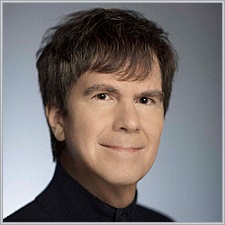
Chuck Wild: The very first water color I painted as a child was a picture of me sitting in front of a large pipe organ, so perhaps there was some early predestination about the career. I remember telling my parents when I returned home for the Navy that I wanted to be a musician. My folks, realizing that the life of a musician can be very challenging, were not encouraging, and suggested I might try it for just a couple of years. Two years has turned into 40 years now…
I wish I could say I had a grand design back then, but the truth at that point in time was much shallower. I just enjoyed being on the road in the many bands, and did learn a lot about life and music. The “road” is also the “tuition” a new musician pays for better musicianship. There have been many ups and downs, I remember in the early days sleeping in the back of my van with a pillow on the pedal board of my old Hammond B3 organ. Still, they were generally happy days, as friends were generous with their couches when our bands ran out of money!
John: Missing Persons became a phenomenal chart topping band with international success with hit albums and songs like Walking In L.A., Words, Destination Unknown, & Mental Hopscotch, just to name a few. In addition to massive radio airtime, Missing Persons was a favorite group played nearly non-stop during the early years of an American television channel and cultural game-changer named Music Television, otherwise known as MTV. A lot of people have varied tastes in music like me so would you please tell us all about your music career while you were with the popular Capitol Records group Missing Persons?
Chuck Wild: On September 22, 1980, I received a call from singer Dale Bozzio, asking me if I’d like to audition for their band. Dale had found me through the Musicians Contact Service in Hollywood. I said “no” as it was my birthday, but maybe another time. Dale said, “Oh, since it’s your birthday, if you’ll come audition, we’ll buy you dinner after the audition!” I agreed, and went to the audition, and they bought me a wonderful Italian birthday dinner.
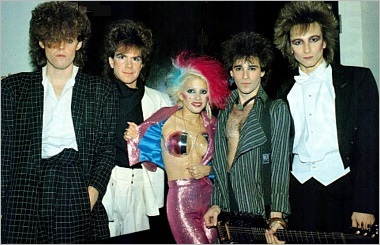 However, when I arrived for the audition, I found out that they needed a keyboard player who had the coordination to play left hand (very fast) bass parts in odd time signatures, while at the same time playing keyboard parts in the right hand in different time signatures!
However, when I arrived for the audition, I found out that they needed a keyboard player who had the coordination to play left hand (very fast) bass parts in odd time signatures, while at the same time playing keyboard parts in the right hand in different time signatures!
I had no problem playing either hand alone, but had never played keyboard bass & keyboard parts at the same time. So, I failed the audition but we still had a fun birthday dinner that night. During the course of the audition, they played four songs for me which they’d recorded with producer Ken Scott (The Beatles, David Bowie, Supertramp) up at Frank Zappa’s house.
I really loved the tracks they’d played for me, so the next day I made the decision to get up at 5 am every morning and practice the new technique of left hand bass and right hand keys, in odd time signatures, first in slow motion, then very fast, until I was proficient enough to audition again. After a couple of weeks I asked for another audition, and this time got the job.
That turned into a whirlwind of activity – Missing Persons started playing live in late 1980 and we sold out 40 shows in a row in Los Angeles prior to getting signed, primarily because the other 3 members of the band had worked extensively with Frank Zappa, who had a big Los Angeles following. I must say it was an extraordinary experience. Terry Bozzio, arguably still one of the greatest living drummers, Warren Cuccurullo, an amazingly creative guitarist who went on to play with Duran Duran for twelve years, and Dale Bozzio, a fashion leader long before Lady Gaga and Madonna, and myself played gig after gig for those first 18 months.
In 1981, once the band had some label interest, we were joined by the talented bassist/composer Patrick O’Hearn, who is a wonderful artist in his own right. Although we were initially rejected by some labels, our manager/producer Ken Scott persisted, and decided it would benefit us to tour in Canada, and then play some dates in New York City area to prove we could attract fans outside of California. Capitol Records staff in NY heard us, on that trip, where we played three sold out shows, the Peppermint Lounge, the Ritz, and a live concert recording for the venerable rock station, WPLR-FM Long Island. When we returned to Los Angeles, Capitol Records signed the group.
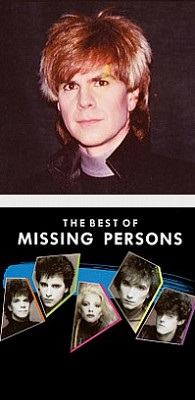 One of my fondest memories from those days was taking a copy of our 4-song EP (phonograph record in those days) to radio station KROQ in 1980. It was very difficult to get music to KROQ, so I waited in the parking lot after everyone left, and as one of the employees was leaving, I propped open the back door with a twig. When the lot had cleared out, I went in and gave our EP to the on-air DJ, Freddie Snakeskin who happened to be program director for KROQ. About 2 weeks later we were riding in a car to rehearsal and heard our song Mental Hopscotch on the air. That song went on to become #1 song of the year in LA before we were even signed. From that point on, our Los Angeles gigs were often introduced by Dusty Street, Jed the Fish, and Freddy Snakeskin (program director for KROQ).
One of my fondest memories from those days was taking a copy of our 4-song EP (phonograph record in those days) to radio station KROQ in 1980. It was very difficult to get music to KROQ, so I waited in the parking lot after everyone left, and as one of the employees was leaving, I propped open the back door with a twig. When the lot had cleared out, I went in and gave our EP to the on-air DJ, Freddie Snakeskin who happened to be program director for KROQ. About 2 weeks later we were riding in a car to rehearsal and heard our song Mental Hopscotch on the air. That song went on to become #1 song of the year in LA before we were even signed. From that point on, our Los Angeles gigs were often introduced by Dusty Street, Jed the Fish, and Freddy Snakeskin (program director for KROQ).
During that same period, Les Garland, an A & R person from Atlantic Records had become a fan of the band, and though Atlantic didn’t sign us, Les went on to become Senior VP of the new Music Television station, MTV, and once we were signed to Capitol, we soon had six videos in heavy rotation, which helped enormously.
John: Fascinating Chuck! In addition to being a band member for Missing Persons you were a session musician on albums for many music celebrities including Paula Abdul, The Pointer Sisters, Frank Zappa and the late Michael Jackson to name a few. Would you like to tell of your experiences while working with famous celebrity artists?
Chuck Wild: In the mid 1970’s I was playing in a blues band in Zebulon, NC, and actually lived in a studio called Mega Sound Studios in nearby Bailey, NC. I traded a place to live in return for playing sessions and keeping the place clean. My initial training in recording arts came from a wonderful engineer by the name of Richard Royal, who was one of the studio owners. So I got a lot of early studio experience in those days. As I mentioned, Missing Persons’ producer on our first album was Ken Scott, and I sat behind Ken whenever possible to learn as much as I could. Missing Persons’ second full-length album, Rhyme and Reason, was produced by legendary five time Grammy-winning engineer/producer Bruce Swedien who had been Quincy Jones’ engineer for over 35 years, including having engineered Thriller and most of the other Michael Jackson albums. Over the years Bruce and his wonderful wife Bea have been mentors for me, and were instrumental in encouraging me to begin the Liquid Mind® series.
In 1987 I co-wrote (and played on) a song for the Pointer Sisters called Say the Word with Grammy-winning producer Glen Ballard and the late great songwriter, Marti Sharron. Glen started calling me for some sessions, including a song on Paula Abdul’s debut album. My longest stint in the studio began when Bruce Swedien called me in 1994 to ask if I’d like to program sounds for Michael Jackson’s HIStory album. I said yes, and I continued to create soundscapes, sounds, and do some percussion programming for Michael between 1994 and 1998. The money I earned from Michael those years helped me to start Chuck Wild Records in the early days, in order to distribute Liquid Mind. Suzanne Doucet, a friend and wonderful New Age artist in her own right, was instrumental as a consultant in setting up my label and distribution, and in guiding me through the trials of running a small label.
John: When you were signed as a staff songwriter to Lorimar Telepictures and Warner/Chappell Music, and also in the years to follow, you’ve composed over 125 songs, scores, and compositions for the television and film industry. Who are some of the artists who’ve recorded your songs?
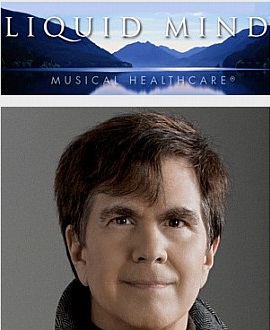 Chuck Wild: After co-writing the above mentioned song for the Pointer Sisters, I was approached by Linda Perry, VP of Lorimar Telepictures Music Publishing Division about becoming a staff songwriter there. My deal continued with Warner/Chappell Music after Warner Brothers purchased Lorimar a couple of years later.
Chuck Wild: After co-writing the above mentioned song for the Pointer Sisters, I was approached by Linda Perry, VP of Lorimar Telepictures Music Publishing Division about becoming a staff songwriter there. My deal continued with Warner/Chappell Music after Warner Brothers purchased Lorimar a couple of years later.
A lot of artists recorded songs I wrote or co-wrote back then including Philip Bailey (from Earth Wind & Fire), Jennifer Rush (I co-wrote a #1 song in Europe for her Passion album called You’re My One and Only), Tommy Page (now a publisher at Billboard Magazine), Glen Medeiros (who sang High Wire from one of the Karate Kid films), Hidden Faces (who sang Hurt So Bad to Love which has appeared in several films), the legendary Japanese band Wink recorded my song One Kiss At a Time.
Thelma Houston, Gary Lemel, Vector, Angela Cole, the Perri Sisters and David Pomeranz are some of the other artists recording my songs back then. In the early 90’s I also recorded two libraries of neo-classical instrumental music, which have had hundreds of plays in dozens of television episodes & films.
More recently I’ve also co-written a number of songs for television & film with the Emmy-winning president of the California Songwriters’ Association, Michèle Vice-Maslin, including Starr X’d Lovers, our Emmy-nominated song in 2011.
John: After leaving Missing Persons you began producing music designed for relaxation under the artist name Liquid Mind®. What was the turning point in your life that led you to begin producing music in the new age genre that is near opposite to the music of Missing Persons?
Chuck Wild: In 1987 while co-composing music with Michael Hoenig for the Emmy-winning Max Headroom ABC-TV series, the filming & post-production of the show got seriously behind schedule, and instead of having 2-3 weeks to score each episode, we typically had only 4-5 days to score, write, arrange and mix 43 minutes of music for each episode, meaning there was little time for sleep. For three months, I slept only about 4 hours a night, usually in the studio. At the same time, a large number of my friends were dying of what was then called AIDs, so I was very stressed out and sleep deprived. I started having anxiety attacks, then panic attacks. The show was cancelled in late 1987 and I went home to rest, and actually became agoraphobic (wouldn’t leave home for several weeks).
At one point during a particularly bad panic attack, co-composer Michael Hoenig and Peter Wagg, the producer of Max Headroom, took me to an urgent care clinic. After examining me, the doctor held up two things in his hands. In one hand was a bottle of anti-anxiety medication, in the other hand was a sheet of paper with instructions on how to do a simple clearing meditation. The doctor said, “Chuck, they both work equally as well for what you have – clinical anxiety. It’s up to you: Medication or Meditation?
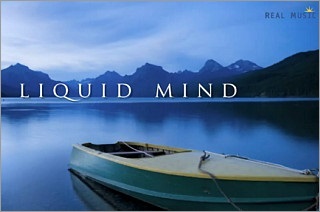 There’s only one letter difference between the two.” I chose meditation over medication that day. The instructions were for a simple clearing meditation, just breathing slowly in and out and counting a number for each breath from 1 to 10, and repeating over and over. To this day, I still have a section at my site for a “meditation break” with those instructions.
There’s only one letter difference between the two.” I chose meditation over medication that day. The instructions were for a simple clearing meditation, just breathing slowly in and out and counting a number for each breath from 1 to 10, and repeating over and over. To this day, I still have a section at my site for a “meditation break” with those instructions.
The meditation helped quite a bit, but I was still unstable at times. My friend Jeff Kingfisher (composer, recording artist, and inventor of Muzoracle, Musicians Dice, and Muzundrum musical board game) suggested I see a counselor friend of his. The counselor suggested that, as part of my healing from anxiety/panic, I try to compose the type of music that represented the way I wanted to feel.
Liquid Mind was borne of the thought: Music can help heal me, and sonically represented the calm I yearned for. She also encouraged me to increase my meditation time to an hour a day.
Though I don’t meditate that long these days, it was a great help to me at the time, and brought me much peace. My early meditations and slow music efforts (especially Zero Degrees Zero from the first Liquid Mind album), plus some intensive therapy with excellent counselors, brought me some relief, enough to leave the house and start a routine of counseling and weekly acupuncture. Within a couple of years, I was pretty much anxiety free and physically recovered from the harm I’d done myself in those 3 months of sleep deprivation and stress.
John: What would you say are the defining characteristics of Liquid Mind Music?
Chuck Wild: There are several readily identifiable characteristic of my music. First and foremost, the music has no predominant rhythm, and is sometimes called “zero beat” music. One day while sitting on the rocks in Laguna Beach, CA, on a therapist-mandated “mini vacation”, I realized that the sound of the ocean was continuous, low and rich, tonally complex, never stopping, and deeply relaxing. That day I came up with the name “Liquid Mind” (i.e. liquid-ocean was relaxing my mind). I determined that the sonic characteristic of my healing music must be similar to the ocean.
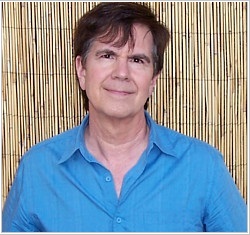 I favor low frequencies, continuous sound, absence of any predominant rhythms, gradual but sometimes complex textural and harmonic changes, moving at about the speed of my breathing, ebbing and flowing at times, and the inclusion of sampled vocal sounds subtly playing chords. Live singers weren’t added until later albums, but I definitely prefer the more organic live vocal textures. Tenors AJ Teshin and Seven Whitfield have sung on almost every album since 2001, and more recently tenor Jimmy Demers as well.
I favor low frequencies, continuous sound, absence of any predominant rhythms, gradual but sometimes complex textural and harmonic changes, moving at about the speed of my breathing, ebbing and flowing at times, and the inclusion of sampled vocal sounds subtly playing chords. Live singers weren’t added until later albums, but I definitely prefer the more organic live vocal textures. Tenors AJ Teshin and Seven Whitfield have sung on almost every album since 2001, and more recently tenor Jimmy Demers as well.
This music is tedious to record, to say the least, since the pieces are long form (many are 10-15 minutes length), and so slow moving. Liquid Mind albums can take 5-7 months to write, arrange, record, mix, and master. Also, as I’ve been caffeine free since 1988, I definitely get drowsy while working on this music, especially during the mixing process and have learned the benefits of a fifteen-minute power-nap!
John: What is sedative or therapeutic music primarily used for?
Chuck Wild: Music therapy, which includes almost every style of music imaginable, is administered by a certified music therapist (who often has a master’s degree in music therapy), and can help most anyone who has a health issue. My sedative music is but a tiny part of the music therapist’s toolbox. The American Music Therapy Association, a wonderful organization which certifies and educates music therapists, says this: “Music Therapy is an established healthcare profession that uses music to address physical, emotional, cognitive, and social needs of individuals of all ages. Music therapy improves the quality of life for persons who are well, and meets the needs of children and adults with disabilities or illnesses.”
I’m not a music therapist myself, but as a composer of therapeutic music, I’m an associate member of the American Music Therapy Association, and was honored to receive their Presidential Award in late 2009. The terms “sedative” and “stimulative” are used to describe less active and more active music. It’s up to the attending physician and the attending music therapist to decide together whether a patient needs relaxation (as in the case of folks with PTSD, anxiety, pain, grief, emotional exhaustion, sleep deprivation etc.) or stimulation (like some elderly, for example, or someone who’s suffered a stroke).
John: Scientific studies have documented the positive effects of therapeutic music, and in your case the benefits of calming music proved to be successful by relieving your personal medical issues with anxiety and panic attacks. But do you feel music therapy can be beneficial to everyone?
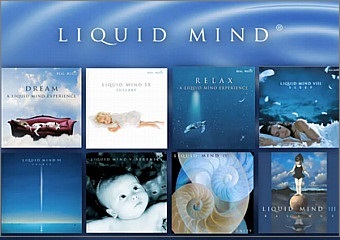 Chuck Wild: Music therapy interventions can be designed to manage stress, help folks learn to express their feelings, alleviate physical pain, improve communication, promote physical rehab, enhance memory, and generally promote wellness. It’s really quite amazing, and most music therapists use music with characteristics that are proven in evidence-based research to achieve a particular healing effect.
Chuck Wild: Music therapy interventions can be designed to manage stress, help folks learn to express their feelings, alleviate physical pain, improve communication, promote physical rehab, enhance memory, and generally promote wellness. It’s really quite amazing, and most music therapists use music with characteristics that are proven in evidence-based research to achieve a particular healing effect.
John: Of course one doesn’t need to have a specific medical issue like panic attacks to benefit from, and enjoy your music, so what are some of the ways people use Liquid Mind Music other than this particular medical disorder?
Chuck Wild: A lot of folks use my Liquid Mind music to relax prior to going to sleep. Dr. William Dement, the “father of sleep medicine” offered an unsolicited endorsement of my 8th album, Liquid Mind VIII: Sleep as part of a pre-sleep routine. I collated some “sleep tips” from his book and other sources, which can be accessed from my website. Massage therapists and yoga instructors use Liquid Mind frequently. One use I don’t recommend is driving while listening to my music. There’s a warning on every CD & my website about that.
Liquid Mind is also used in dozens of healthcare settings for different purposes. I’ve heard from doctors, nurses, music therapists, state prison counselors, drug rehabs, hypnotherapists, yoga instructors, massage therapists, acupuncturists, psychologists, cancer chemotherapy centers, psychologists and other counselors, ministers, meditation teachers, hospice caregivers, special needs school teachers, and many patients who use the Liquid Mind® music for healing. I’m quite humbled by the over two thousand gratitude emails I’ve received from patients and their families. I never imagined there would be that much interest in my music.
John: Like you stated earlier, Liquid Mind albums are composed using specific techniques based on scientifically supported research to achieve the desired physical responses. Based on these scientific studies, could you tell us the techniques you use when composing your music?
Chuck Wild: Evidence based research does support some characteristics of Liquid Mind – bass (lower) frequencies and vocal sounds are perceived to be relaxing to humans, because when we’re in the womb, a safe place prior to birth, we don’t hear a lot of treble frequencies, it’s more muffled sounds, and we get used to the sound of our mother’s voice, so there is that familiarity. I’ve done some unpublished research myself using a bi-spectral index anesthesia monitor, and determined that continuous slow music (similar to ocean sounds) has a “masking” effect on other environmental sounds, making it much easier to relax.
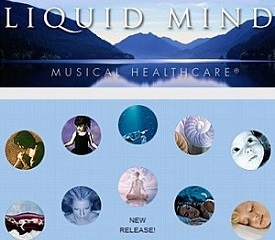 There is also the effect of entrainment, which in a reverse way, in my own non-scientific opinion, helps Liquid Mind to relax folks. Entrainment is the propensity for two oscillating systems (imagine two pendulum clocks on a wall) to entrain and move at the same time. This happens in biological systems as well. When I hear fast music, my heart rate rises. When I hear slow music, my heart rate falls as muscle relaxation ensues.
There is also the effect of entrainment, which in a reverse way, in my own non-scientific opinion, helps Liquid Mind to relax folks. Entrainment is the propensity for two oscillating systems (imagine two pendulum clocks on a wall) to entrain and move at the same time. This happens in biological systems as well. When I hear fast music, my heart rate rises. When I hear slow music, my heart rate falls as muscle relaxation ensues.
My recording process is as follows: (1) I spend 4-5 weeks sketching about 40 pieces, 10-20 minutes each (2) I choose the best 5 or 6 pieces (3) I spend 6-10 weeks arranging, really the most difficult stage, where I’m smoothing any attacks on the sounds I use (generated from 10-15 synths and dozens of tracks of live vocals).
The music sounds quite simple, but the texture is always in motion under the surface. (4) 6-10 weeks mixing and creating the sonic fingerprint of Liquid Mind. (5) 2 weeks premastering where I reduce certain mid-high frequencies, boost certain bass frequencies and importantly to volume-match within and between the pieces.
I don’t want someone to have to reach for a volume adjustment while they’re listening. (6) 1 or 2 weeks mastering with Bernie Grundman here in Hollywood. Bernie is a legend in the recording industry and he and Joe Bozzi supervise the final touches of the process.
John: Liquid Mind albums are consistent best-selling albums making the Top 25 sales charts at Billboard again and again. In fact your 8th album Liquid Mind VIII: SLEEP was on the Billboard top 25 sales charts for over a year, and has reached #1 on the iTunes USA Top Ten New Age Chart countless times. Were you at any point surprised by the widespread popularity of your work has received or did you “just know” your music would achieve universal acceptance?
Chuck Wild: I never really expected to have the kind of acceptance I’ve had for Liquid Mind®, it was a pleasant surprise when I started charting on iTunes. I’ve always worked hard at making Liquid Mind “pay for itself” as a business, but was surprised when Liquid Mind VIII: SLEEP showed up on the Billboard® New Age sales charts for over a year running.
John: To say your music career is diverse is an understatement Chuck! You have received a lot of recognition for your work as Liquid Mind over the years so would you please tell us about the honors and awards you’ve achieved?
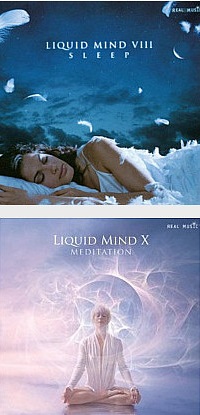 Chuck Wild: I’ve had some recognition from the Academy of Television Arts & Sciences (Emmy® nomination), the American Music Therapy (Presidential Award for advocacy and support of the music therapy profession), Billboard and iTunes USA charting dozens of times (for sales), Coalition of Visionary Resources award for Best Meditation/Healing Album for Liquid Mind VI: Spirit, Northern California Independent Film Festival best score honors for the award-winning short animation film “Horses on Mars” which exclusively used music from the first Liquid Mind album. Most recently, the prestigious Zone Music Reporter, representing US new age broadcasters and program directors, has nominated my new album, Liquid Mind X: Meditation for Best Electronic Album of 2012.
Chuck Wild: I’ve had some recognition from the Academy of Television Arts & Sciences (Emmy® nomination), the American Music Therapy (Presidential Award for advocacy and support of the music therapy profession), Billboard and iTunes USA charting dozens of times (for sales), Coalition of Visionary Resources award for Best Meditation/Healing Album for Liquid Mind VI: Spirit, Northern California Independent Film Festival best score honors for the award-winning short animation film “Horses on Mars” which exclusively used music from the first Liquid Mind album. Most recently, the prestigious Zone Music Reporter, representing US new age broadcasters and program directors, has nominated my new album, Liquid Mind X: Meditation for Best Electronic Album of 2012.
John: You are an artist with most of your albums on the successful Real Music Label, which features a quality lineup of top industry artists like yourself. What are the advantages to marketing your music through the Real Music Label?
Chuck Wild: John, I ran my own label for 10 years (1994-2004), focusing only on Liquid Mind, supervising employees and working seven days a week, with very long hours. That left me little time to create music, and even less time to “have a life.” In 2004, I decided to approach Terence Yallop and his wife Karen Kael, the owners of Real Music, about taking over distribution (i.e. licensing) of my first six albums, and also signing a recording agreement for four additional albums.
I’d met Terence in 1994 or 1995, and by 2004, and knew he and Karen had been meditating to my Liquid Mind music almost daily for ten years, so it seemed like a good fit. Real Music has real integrity, being one of the few New Age labels to survive the mergers of the 80’s, 90’s and 00’s, and to prosper in the downturns that have plagued the music industry. Terence and Karen and the wonderful staff at Real Music have remained true to their mission of bringing the music of relaxation, renewal and healing to everyone on the planet who can benefit from it.
To answer your question more specifically, there are economies of scale from being signed to a label. I get to work less time on administration and more time on music. Real Music has been a respected and established label for over 25 years in this niche, and it’s a relief to have the label administering, promoting and distributing my catalog. BTW, most recently my friend and Real Music label mate Omar Akram won the Grammy for his latest album.
John: What would you say are the fundamental differences in the music you compose versus meditative or made for relaxation albums created by other artists in the same category?
Chuck Wild: There is wonderful relaxation/meditation music by many artists from all over the world. Since relaxation is often cultural, something that may be relaxing in one country or society might not be perceived favorably in another. So, it’s a bit difficult to compare artists. I’d say Liquid Mind has different characteristics than some relaxation music. My music tends to be slower; perhaps more mellow sonically, laced with European classical harmonies, and is notable for the absence of any percussion instruments. I don’t listen much to other artists unless I’m working with them, so don’t consider myself an expert. One of my former students, the talented composer and performer Armen Chakmakian, is fond of saying that all music is relaxing and healing to someone. I fully agree.
John: Liquid Mind albums and songs are available on audio CD, but is all of your music available as digital downloads too?
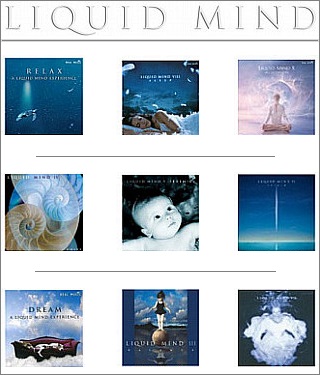 Chuck Wild: Yes, all twelve albums (ten studio CDs and two compilations) are available both digitally and on CD. 70% of Liquid Mind sales are now digital, fewer CDs are still being sold these days. All twelve Liquid Mind® albums are sold through iTunes, Amazon.com, CDBaby.com, and dozens of digital sites. Real Music also sells all albums, both in digital and physical CD copies. Liquid Mind is streamed around the clock on Pandora, Spotify and just about every streaming service, as well as dozens of internet radio stations, digital television, and Sirius XM.
Chuck Wild: Yes, all twelve albums (ten studio CDs and two compilations) are available both digitally and on CD. 70% of Liquid Mind sales are now digital, fewer CDs are still being sold these days. All twelve Liquid Mind® albums are sold through iTunes, Amazon.com, CDBaby.com, and dozens of digital sites. Real Music also sells all albums, both in digital and physical CD copies. Liquid Mind is streamed around the clock on Pandora, Spotify and just about every streaming service, as well as dozens of internet radio stations, digital television, and Sirius XM.
John: It’s a well-known fact the music industry as a whole has experienced serious problems with piracy issues. Has there been much improvement regarding piracy as a whole, and have you ever experienced problems with piracy yourself?
Chuck Wild: Unfortunately, the technological advances that enable file sharing have hit our industry (and many other industries) hard. At one point, all my Liquid Mind albums were on nearly 100 pirate websites.
It can be disheartening, but there’s really nothing substantial that can be done about it until music fans grow to understand the harm free file-sharing does to artists, engineers, producers, songwriters, composers, performers, and employees of labels. I think the most devastating effect of piracy is that it has caused the disappearance of several major labels, and destroyed a portion of the major label “farm club” system that used to nurture new artists.
These days, instead of a new artist spending their time on music, they must become musical entrepreneurs, wearing every hat (producer, engineer, publisher, label, PR person, social media expert, marketer, and so forth). I personally believe that the quality of music has suffered and the majority of new artists are never able to make a “sustainable” living at music now.
Major labels have been criticized for being greedy and taking advantage of artists, which may have happened in some cases, however, it’s estimated that only 5% of artists ever sell enough albums to break even. The other 95% of artists used to be supported by the top 5%. But that system of artist development is no longer in place for the most part.
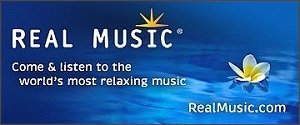 Individuals and some websites like Kickstarter have stepped in to fill that void, but these efforts require a lot more time commitment to business by the artists, meaning less time to grow musically. Pirate sites do, in a sense, provide some promotional value, as long as folks go on to support artists by purchasing some tracks, but there is no proof that this is happening on a large scale and overall music sales have declined over 50%.
Individuals and some websites like Kickstarter have stepped in to fill that void, but these efforts require a lot more time commitment to business by the artists, meaning less time to grow musically. Pirate sites do, in a sense, provide some promotional value, as long as folks go on to support artists by purchasing some tracks, but there is no proof that this is happening on a large scale and overall music sales have declined over 50%.
Like every other artist, Liquid Mind has been hit by file-sharing. I’m in hopes that folks are now coming to the understanding that artists, composers, singers, arrangers, engineers, mixers, studios, and label staff spend many months creating an album and preparing for release, and are just asking for fair compensation for their time. Though I enjoy music production, it is a business for me, and every other artist, especially as we grow older. Without support of fans and listeners, many artists will need to turn elsewhere to make a living.
John: During interviews I try to provide the latest press news for my artist and their fans if possible. Can you release any news information or perhaps give us the details if you have plans for a new Liquid Mind album?
Chuck Wild: I have no plans for release of a new Liquid Mind album, having just released Liquid Mind X: Meditation in September 2012. This year, I’m focusing on pop music production, and my classical piano pieces.
John: You have enjoyed several distinctly separate, but highly successful careers in your lifetime. What do you find most rewarding, songwriting/composing, production or being a musician?
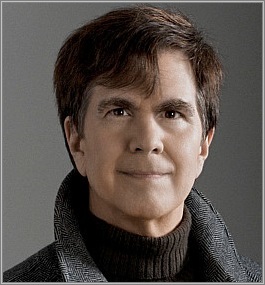 Chuck Wild: In my own case, the three are synergistic, and I find reward in all of them. I love what the great writer Pearl Buck said: “The secret to joy in work is excellence.” I strive for (but never fully achieve) excellence.
Chuck Wild: In my own case, the three are synergistic, and I find reward in all of them. I love what the great writer Pearl Buck said: “The secret to joy in work is excellence.” I strive for (but never fully achieve) excellence.
The process is what keeps me going, especially when working with folks who have high standards and are willing to take the time required for high quality work. I’m producing a young artist now, one of the singers from NBC’s The Voice, Nathan Parrett.
He’s a terrific talent both as singer and songwriter, and it’s one of those opportunities to excel that make me get up every morning with a smile on my face. As well, I’ve written seven short classical preludes for piano, available for free at ChuckWild.com (including pdf sheet music), and am about one-third of the way through a long form (22 minute) piano sonata at the moment.
John: I enjoyed reading more about your fascinating life and career while preparing for our interview together Chuck. I hope we have a chance to interview again in the future. In closing for now, I want to thank you again for giving everyone this opportunity to find out the latest news about you, and the music of Liquid Mind. Is there anything you would like to express to the fans that have supported you over the course of your career?
Chuck Wild: I’m incredibly grateful to fans of Liquid Mind, and the many healthcare practitioners that use my music for healing. There is no greater reward for me than knowing someone’s life is made easier by listening to my music. Thanks so much, John, for this opportunity to be part of your wonderful website. I want you to know how much I and many other artists appreciate your support of the music profession and music creators.
To listen to samples or purchase songs and albums by Liquid Mind®, visit LiquidMindMusic.com. To learn more about Chuck’s non-Liquid Mind projects at ChuckWild.com. To find album and single digital downloads, CDs and song samples, visit Liquid Mind at RealMusic.com. Liquid Mind albums and songs may also be sampled or purchased at Amazon.com and iTunes.com. Follow Chuck at Facebook and Twitter social media. Photo and cover art courtesy Chuck Wild & Glen Wexler.

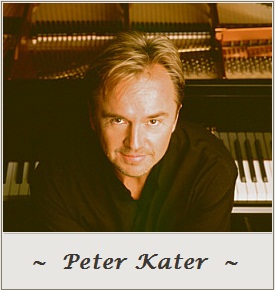 Interview with Peter Kater in 2013 – Newest interview with multi-platinum selling composer and pianist Peter Kater.
Interview with Peter Kater in 2013 – Newest interview with multi-platinum selling composer and pianist Peter Kater.
Multi-Platinum selling recording and concert artist Peter Kater is a legendary composing pianist recognized as one the leading new age and instrumental music producers worldwide. GRAMMY® Nominated seven times over the past eight years, along with his own albums he is a consistent producer of cinematic music for the television and film industry.
Peter Kater has composed music scores for over 100 television programs and films, including 11 off and On-Broadway theatrical plays to date. In addition to performing at Carnegie Hall in New York City, Peter Kater’s music was played during the NBC broadcast of the 2000 and 2004 Summer Olympic Games and is recognized for his collaboration work with distinguished actors and celebrities in the film and music industry.
Topics for the newest interview with Peter Kater include a conversation of his GRAMMY® Nominated album Light Body and notable achievements during his music career. Peter Kater also replies to questions about important film directors and celebrities he has worked with, and offers encouraging words of advice to artists beginning their music careers.
Peter Kater Interview – New in 2013:
New Age Music World interview host and publicist John P. Olsen had an opportunity to interview Peter Kater in early 2013. Today we are pleased to present a new interview with the esteemed instrumental music composer and pianist Peter Kater.
John P. Olsen: Thank you for accepting my interview invitation Peter, and for taking time out of your demanding schedule. Recently your piano with instrumentals album Light Body was GRAMMY® Nominated in the 55th Annual Music Awards.
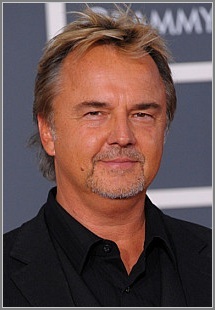 Light Body is your eighth GRAMMY® nomination, which is a significant achievement in itself. Would I be correct by saying even though you are accustomed the prestige and recognition Nomination brings, that the Annual Music Awards Ceremony is always an exciting time of the year for you?
Light Body is your eighth GRAMMY® nomination, which is a significant achievement in itself. Would I be correct by saying even though you are accustomed the prestige and recognition Nomination brings, that the Annual Music Awards Ceremony is always an exciting time of the year for you?
Peter Kater: Yes, it’s an exciting time of year and it’s also a time to stay very close to my center and remain true to the reason that I do music, and to connect with a deeper more intimate and profound part of myself, my experience and others. To get swept up into something as external as a Grammy Award or to look outside of myself for my happiness and contentment would be a mistake. However, having said that – yes, it’s very cool to be Nominated.
John: I imagine you have a chance to visit with old friends and perhaps meet new friends during the Music Awards Ceremony. One GRAMMY® Award winning artist you have collaborated with in the past is American flute performer R. Carlos Nakai. Would you like to tell us about your friendship and projects with R. Carlos Nakai?
Peter Kater: R. Carlos Nakai has been Nominated for a Grammy 9 times and unfortunately has not yet won, although he certainly deserves to. R. Carlos and I met in 1989 after I was turned on to his music and invited him to play on a CD of mine. Our first collaboration was on the album Natives.
We improvised the whole CD in a few short hours. We’ve known each other for decades and have had our ups and downs but whenever we get to playing music together either on stage, in the studio or in my living room it’s literally . . . magic. It flows like a mountain spring. It’s a connection we’ve always had. And yet, sometimes the human personality is not quite as fluid.
John: You have also collaborated with an impressive number of projects with popular film directors and award-winning celebrity actors. Who are some notable film directors and celebrities you have worked on projects with over the years?
Peter Kater: My favorite scoring projects were “10 Questions for the Dalai Lama” cause I really liked the film and subject matter and “How The West Was Lost” because it was such an important series (13 hour mini-series) that really exposed the truth of the settlement out west in the U.S. and what the heavy price our Native American culture paid. It was a very sad and poignant series where I found myself literally crying in the studio as I was playing the visual footage.
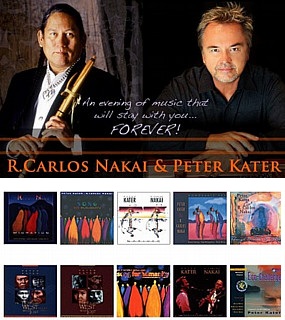 I also really enjoyed the work I did on Broadway and Off-Broadway theater productions. I was working with the very best in the business, director Marshall Mason: Pulitzer Prize winning playwright, Lanford Wilson and amazing actors like John Malcovich, Joan Allen, Tyne Daley, Ethan Hawke, John Voight and many others. Being in the rehearsal process with these great talents for weeks at a time was definitely a highlight of my career.
I also really enjoyed the work I did on Broadway and Off-Broadway theater productions. I was working with the very best in the business, director Marshall Mason: Pulitzer Prize winning playwright, Lanford Wilson and amazing actors like John Malcovich, Joan Allen, Tyne Daley, Ethan Hawke, John Voight and many others. Being in the rehearsal process with these great talents for weeks at a time was definitely a highlight of my career.
I also enjoyed performing in the early years at the Sundance Institute and Film Festival as per the request of Robert Redford who really liked my music. And I have to mention my wonderful 10 years of playing with and for John Denver at his “Choices for the Future” Symposiums in Aspen, Colorado.
I met many famous influential authors and world leaders thru his symposiums. And I would be remiss in not mentioning my work with Kenny Loggins. Actually I could go on and on cause there have been so many amazing experiences but for that I may need to write book.
John: With a list of celebrities like you described I can see why Peter! Earlier releases like Light Body are wonderful arrangements showing your creativity as a composer and musician. Could you describe the theme of Light Body, which is based on seven Chakras?
Peter Kater: Light Body’s theme is of the 7 Chakras starting at the root chakra and working our way up. It was designed to create an experience of acceptance and illumination for people dealing with life changing circumstances from everything from daily stress thru disease and dying.
John: In addition to your superb performance on piano and synthesizers, Paul McCandless and Trisha Bowden have helped you transform Light Body into an outstanding instrumental album that indeed has award-winning potential. Would you like to tell us what musical instruments they perform and enhancements they bring to your recent GRAMMY® Nominated arrangement Light Body?
Peter Kater: Trisha sang some beautiful wordless vocals on the record really giving it a human compassionate feeling. Paul McCandless played oboe, penny whistles and English horn. Paul always adds a lot to any recording project. He is one my musical mentors and heroes.
John: Undoubtedly, a lot has transpired over the years since 1983 when you released your first solo piano album entitled Spirit. At what point during your career did you find the incentive to begin producing serene new age, instrumental piano music made for reflection and relaxation?
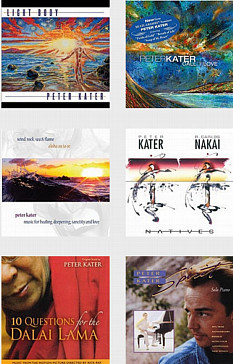 Peter Kater: I decided to go into the direction of deeper, more reflective music after I had three National Top 10 Contemporary Jazz albums and was touring playing jazz festivals around the country.
Peter Kater: I decided to go into the direction of deeper, more reflective music after I had three National Top 10 Contemporary Jazz albums and was touring playing jazz festivals around the country.
I realized then I definitely wasn’t feeling fulfilled playing that kind of music (even though I wrote and produced it) and wanted my music to fill a need in the world for greater healing, peace, love and compassion.
John: During your career as a music professional spanning three decades, you have released over 60 recordings, and over 100 soundtracks for movie scores for films or television, including off and On-Broadway theatrical plays. Could you tell us about the varying process of composing music for television or theater, verses composing music for an album?
Peter Kater: When you’re working with another art medium like film, theater or dance you’re in an interactive process and need to leave space and room for the other medium. You’re bouncing off each other and as result coming up with material you never would have come up with on your own.
John: Knowing you have lived in the U.S. in the state of Hawaii, has the natural beauty of the Hawaiian Islands been a stimulus to your music?
Peter Kater: Actually living in Hawaii brought me such peace and contentment that I was actually playing less and less music. Therefore my move back to Boulder, Colorado last year has reignited my burning passion for the piano and for writing and recording music. I’ve always done great work from Colorado and it’s been exciting to feel that part of my “being” engaged once more.
John: Along with easy access you give fans at your website you also have Facebook and Twitter social media sites. Have your social media pages proven to be a beneficial outlet for exchanging ideas and information with your fans and visitors?
Peter Kater: I like being connected to my fans and people of like mind and heart and soul. It’s one of the good things about the internet. I enjoy it but I think it’s important to stay present in one’s life in a real physical and tangible way and not get lost staring at the computer screen.
John: I have a question I always like to ask a highly successful artist like you Peter. Would you be willing to offer any advice for pianists or artists in general who are just beginning their music careers?
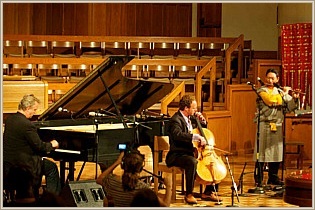 Peter Kater: Follow your heart. Trust your instincts. Don’t second guess yourself. Don’t ask for too many opinions from others. Play each note like it’s never been played before in this space and time (cause it hasn’t been) and never lie to your instrument. Play what you’re feeling honestly . . . don’t pretend to be confident when you’re feeling nervous . . . don’t pretend to be happy when you’re feeling sad. Don’t be out going with your feeling introspective and don’t hide from your fears or your pain cause then you’ll never find your joy and bliss. And place “authenticity” before all else.
Peter Kater: Follow your heart. Trust your instincts. Don’t second guess yourself. Don’t ask for too many opinions from others. Play each note like it’s never been played before in this space and time (cause it hasn’t been) and never lie to your instrument. Play what you’re feeling honestly . . . don’t pretend to be confident when you’re feeling nervous . . . don’t pretend to be happy when you’re feeling sad. Don’t be out going with your feeling introspective and don’t hide from your fears or your pain cause then you’ll never find your joy and bliss. And place “authenticity” before all else.
John: I read while taking piano lessons as a youngster, you struggled with early piano instructors because you wanted to improvise on “the classics.” Do you feel this desire to improvise early in life was an important factor with your success today, and if so, would you advise parents with young children taking music lessons to allow them “creative freedom” to explore too?
Peter Kater: I always wanted to play things my own way. But it was important for me to learn the basics and structure as well. In the early years there has to be that balance of learning and enjoyment. But most importantly, find a teacher that really inspires you and makes you feel good about playing.
John: Along with your numerous studio releases you perform live concerts, plus people can book a live home concert with you to perform during special occasions. Will you be performing live in 2013, and what can people expect while attending a Peter Kater concert?
Peter Kater: I’ll be doing plenty of concerts in 2013. Some solo and some with collaborators. I think people can expect a “real” experience. A lot of people have a “moving” experience and some even have a cathartic experience. I think the honesty with which I approach my music is felt within the listeners and as a result “real” feelings emerge and true “experiences” are had. But it’s a very personal and individual thing. Everyone has their own experience.
John: Your successes and achievements during your career is truly remarkable Peter. Of your many achievements, what would you say are the two most gratifying moments during your music career to date?
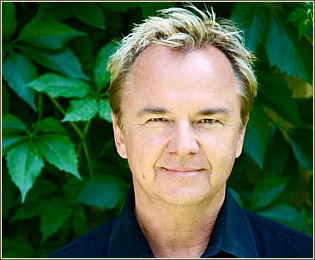 Peter Kater: The most gratifying thing about my musical career to date is that I’m still passionate about it. I still can sit down at the piano, solo of playing with someone, and have a real experience of wonderment, honesty and excitement. I’m still curious about what’s possible and I still love it. There’s nothing more gratifying than the enjoyment of making music and sharing it with others in the moment. If you’re attached to the past you’re not living in the present. And the “present” is all we ever have.
Peter Kater: The most gratifying thing about my musical career to date is that I’m still passionate about it. I still can sit down at the piano, solo of playing with someone, and have a real experience of wonderment, honesty and excitement. I’m still curious about what’s possible and I still love it. There’s nothing more gratifying than the enjoyment of making music and sharing it with others in the moment. If you’re attached to the past you’re not living in the present. And the “present” is all we ever have.
John: Thank you again for taking time away from your work for our interview Peter! In closing for now, is there anything you would like to express to your fans that have supported you over the years?
Peter Kater: Thanks for your good wishes. I really appreciate them and I appreciate the opportunity to talk about what’s important to me. And I also appreciate, very much, the people that listened to my music and have a personal experience through it that is there’s. The fact that I can create something, or channel something that can add to the life of another person in a positive and impactful way is truly wonderful. That is a gift to me in and of itself.
It’s an honor to be a musician and it’s wonderful to have a life filled with music flowing thru me and out into the world.
Thank you for listening! ~ Peter Kater ~
Visit the PeterKater.com homepage for news, and learn more on this great artist on the Peter Kater profile page and visit his music shop for special offers and to sample or purchase his albums. Photos and cover art are courtesy peterkater.com.

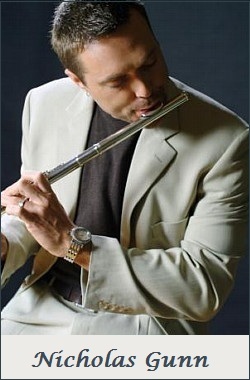 Nicholas Gunn Interview – Special News in 2013 and Forward:
Nicholas Gunn Interview – Special News in 2013 and Forward:
Multi-platinum recording artist Nicholas Gunn is a classically trained flutist recognized as one of the best-selling instrumental flutists worldwide.
Famous for the contemporary atmosphere and resounding beauty of his music, Nicholas Gunn has achieved earlier success of over 2 million albums sold, having become a legendary artist in the instrumental music industry, with many of his albums reaching the Top 10 Billboard Charts.
Nicholas Gunn’s newest instrumental release for 2012, and perhaps most significant of all is his fourteenth album named Thirty-One Nights, which arrives after an interval of 5 years. The highest standards we have come to expect are expertly portrayed on Thirty-One Nights, which enlists the world-class talents of vocalist Dana Kemmerle, along with acoustic guitarist Chris Fossek.
New Age Music World host John P. Olsen had an opportunity to interview Nicholas Gunn months prior to 2013. During the newest interview with Nicholas Gunn the range of topic include a conversation about his new album, history and career as an artist, National Park albums, and the Gemini Sun Records Label he once owned and operated.
Nicholas Gunn also states his views on today’s music industry and the upcoming Ballots and Nominations for the 55th GRAMMY® Awards. And perhaps most importantly, Nicholas Gunn has released a significant news announcement regarding his music career going forward. Today we are pleased to present their conversation to fans, and to Music World site visitors.
John P. Olsen: Thank you for accepting my interview invitation Nicholas. It is a privilege to host your newest interview in 2012, here at New Age Music World. I have been a huge fan of your music for many years, plus I enjoyed reading even more about you while preparing for our interview together. I must say you have experienced a fascinating life and career Nicholas.
Nicholas Gunn: Thank you John, it is really a pleasure to be a part of your music forum today, and it’s great to see how popular New Age Music World has become.
John: Thanks for your compliment! Let me begin with your earliest experiences as a musician, since your educational studies seem to have been a formative influence in the music you produce today. You were born in South East England, and were academically trained from age 7 to 11 in classical music at the Royal Academy of Music conservatoire in the UK. While attending the Royal Academy of Music, what led you to choose woodwinds over other instruments, and would you please tell us about your earliest academic studies, training and first introduction to music while living in the UK?
 Nicholas Gunn: I grew up in a small, quaint village called Hartlip in Kent County England. It was in many ways a beautiful childhood. I think when there is that much space around you and the chatter is minimized, it’s easier to focus on things such as music. When I was around 5 or 6 I used to watch Top of the Pops on TV and tap away on the side of the couch. I think my folks were listening carefully to see if I had any sense of rhythm and inclination for music.
Nicholas Gunn: I grew up in a small, quaint village called Hartlip in Kent County England. It was in many ways a beautiful childhood. I think when there is that much space around you and the chatter is minimized, it’s easier to focus on things such as music. When I was around 5 or 6 I used to watch Top of the Pops on TV and tap away on the side of the couch. I think my folks were listening carefully to see if I had any sense of rhythm and inclination for music.
My Grandfather was a professional guitar player with The Felix Mendelssohn Orchestra so I think there was a desire in many ways to keep the music going in the family. I remember at 6 seeing a performance on TV of Sir James Galway and thinking how beautiful the flute sounded. It stuck with me and when my folks asked me what I wanted to play as an instrument that’s immediately what I said. It’s crazy really, the next thing I know I am taking lessons at 6 from the Royal Marines Bands principle flautist, Mick Judson. An incredible experience, full of wonder and endless possibilities!
He would come to my house in Hartlip once or twice a week for lessons and I would take my exams in London; it was a lot for a young kid but really rewarding. He was a great instructor and man, and a big part of the foundation my music is built upon. One time, Mick allowed me to sit with him in the pit orchestra to the musical Oliver in London, and I remember having a brief encounter with Sir James Galway during this time and thinking, this is really what I want to do!
By the time we moved to Los Angeles in 1979 I had music training most eleven year olds rarely acquire and was a misfit really. It was tough, as an eleven year old boy, walking with your flute to band through junior high school. I witnessed a huge disparity in culture and acceptance of art on multiple levels. It was cruel and I was pissed off at these kids that bullied me. There were several occasions I would walk outside of gym class and I would have my ass handed to me on a platter for playing flute. Its cliche really, all band kids experience bullying, some more than others, it’s just the way it was and sometimes still is. My music holds a sense of compassion I have trouble finding otherwise. I believe it has healed me and allowed me an outlet of expression to resolve these feelings for myself. I like to believe there is no anger in my music, just love, beauty, compassion, and acceptance. I wanted to convey that message.
John: Knowing now that the Royal Academy of Music Alumni include other great artists like Elton John, Annie Lennox and Michael Nyman, and others; did you appreciate the fact at the time you were beginning a strong foundation for a successful music career later in life?
Nicholas Gunn: No, not really, not at that time. I had no idea about any of those things. It was more a feeling of this is what everyone does. When you are that young, there is no real sense for “aligning” yourself within academics or community. I pretty much followed what my folks told me to do, and believed it to be normal, and now have immense appreciation for them guiding me and recognizing my potential.
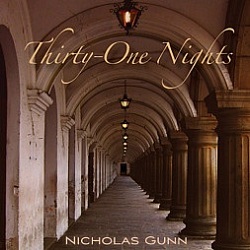 John: Classical music influences are apparent in your compositions, including your new album Thirty-One Nights. What classical music elements, for example structure, rhythm or metrics, do you find most appealing?
John: Classical music influences are apparent in your compositions, including your new album Thirty-One Nights. What classical music elements, for example structure, rhythm or metrics, do you find most appealing?
Nicholas Gunn: I have to say it’s the interplay between rhythm and melody. Being a flautist, I studied mostly counterpoint theory at the academy. We poured over the great composers in detail and I absorbed the constant interplay you find in lead lines, counter melody lines, and the foundation it all sits upon; rhythm. I believe that one essential element of music is structure. Meaning; memorable, reoccurring, lasting melody will always make an impression on the listener over a long extended period of time.
As an instrumentalist I find it even more important to remember this. Strong verse, chorus, turnaround and bridge are vital to great compositions. If the music lacks a lyric and a vocal, I believe it’s even more important to impress structure and melody on the listener. Think about it, music in the moment can be inspirational, but if one can reflect upon a composition because of its melody and literally be transported to that moment in time again, that is the true essence of the music experience on the human experience.
John: What was the turning point when you decided to pursue a challenging career as an artist?
Nicholas Gunn: When I was around 16-17 years old I side stepped flute for a few years and took up drums, playing in both marching band and several rock bands. I literally played the kit in every bar on the Sunset Strip over a three year period including The Whiskey, The Roxy, Madam Wong’s, The Troubadour, etc. It was a great experience at a very young age and it gave me the douse of confidence I needed. I had a brief stint doing some commercials and modeling as well and actually made a few bucks but that’s a whole different story! I came out of this phase “knowing” I guess you could say, that there was only one direction for me, and that was to fully immerse myself into creating my own instrumental music.
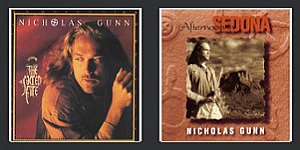 I was a huge fan of Vangelis, Jean Michael Jarre, Pink Floyd etc., and saw that instrumental music had its place in the market and was growing at that time. I bought some recording gear and schooled myself in engineering and production, learning how to get recordings to sound great! I went down to Westlake Studios and other studios in West Hollywood and just hung out asking awesome stupid questions and rubbing shoulders with the best engineers. There was no question afterward that I was fiercely dedicated to making my own music.
I was a huge fan of Vangelis, Jean Michael Jarre, Pink Floyd etc., and saw that instrumental music had its place in the market and was growing at that time. I bought some recording gear and schooled myself in engineering and production, learning how to get recordings to sound great! I went down to Westlake Studios and other studios in West Hollywood and just hung out asking awesome stupid questions and rubbing shoulders with the best engineers. There was no question afterward that I was fiercely dedicated to making my own music.
John: You released your first album Afternoon In Sedona in 1992, and a year later re-released Afternoon In Sedona thru the Real Music record label, which directly influenced sales, and changed the course of your career, isn’t that right?
Nicholas Gunn: That’s pretty accurate I would say. Before being signed to Real Music I had worked pretty hard to get popular retail chains such as Natural Wonders and Nature Company to recognize myself release of Afternoon in Sedona. Those were great retail chains and they focused on a select amount of instrumental titles in their thousands of high end stores. It was easy math really; mass retail exposure, select titles, genre specific, those were great days for sales! I had sent Real Music several submissions of Afternoon in Sedona but it was only until Natural Wonders showed interest they offered me a deal. It made sense for everyone and we re-worked the album a little and re-released in 1993 to moderate success, not big success mind you! There was a heightened awareness of the product but it was not until my second album The Sacred Fire that things changed drastically.
John: That’s right your 1994 release The Sacred Fire, was the first album to make the Top 10 Billboard Charts in the new age category. Were you surprised by making the Billboard Top 10 New Age chart verses another category since your albums can be placed in a broader, instrumental or world music category?
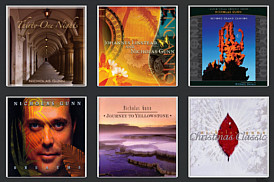 Nicholas Gunn: No, I was not surprised actually. Real Music had made it clear we were binning the album New Age at retail. Back in those days, binning was integral to sales and exposure and once you chose your category, well you’re pretty much stuck, especially if you sell.
Nicholas Gunn: No, I was not surprised actually. Real Music had made it clear we were binning the album New Age at retail. Back in those days, binning was integral to sales and exposure and once you chose your category, well you’re pretty much stuck, especially if you sell.
The New Age chart was an accessible chart as well, meaning it was an emerging genre and not so saturated with other artists. The Sacred Fire actually did not receive its initial success at conventional retail but started selling big at both Natural Wonders and at Nature Company.
The album was literally blowing out the doors holding a #1 chart position in the chains for a year or so. Around this time conventional retail chains such as Borders and Barnes were watching this emerging genre closely and started to expand their New Age Music selections and positioning.
The Sacred Fire album, along with my third album, The Music of the Grand Canyon, which closely followed, was embraced and we finally received chart position through sales at these and similar retail chains.
John: I must say your newest release Thirty-One Nights, which debuted on the Billboard Top Ten New Age Chart, is a beautifully designed album Nicholas. Your albums have consistently made the Top 10 Billboard Charts over the years, so I wondered is making the Billboard Chart is an accurate litmus test for an album’s success over the long haul?
Nicholas Gunn: Thank you John, I am happy to hear Thirty-One Nights resonates with you. This is a great question, but I think it’s important to clarify what Billboard chart position actually means as it seems there is a general misunderstanding of how the system really works. Billboard is an independent trade magazine that reports industry sales via chart position. Billboard receives its sales data from another company called Soundscan.
Soundscan retrieve its sales data from Soundscan retail members. For example, Wal-Mart pays an annual fee to be a member of Soundscan, required by the RIAA (Recording Industry Association of America) that they participate as a major and recognized record retailer. Barcodes at the register are scanned upon sale and sent to Soundscan acknowledging each sale. At major online retailers such as iTunes it is via the embedded ISRC code on the MP3 data through digital download.
 Depending on the zip code of sale, one sale can actually represent two or more sales due to the remote location of the sale and person per capita of the zip code. If you are a small retailer, mom or pop store, or even a significant type of other retailer, then most often, these retailers are not participating members of Soundscan. Sales in turn are not being reported, at all! At the height of my sales through alternative retailers such as Nature Company, Natural Wonders, National Park stores, hundreds of thousands of sales went unrecognized as they were not members of Soundscan. There are no gold or platinum records on my walls despite my significant overall sales within the industry.
Depending on the zip code of sale, one sale can actually represent two or more sales due to the remote location of the sale and person per capita of the zip code. If you are a small retailer, mom or pop store, or even a significant type of other retailer, then most often, these retailers are not participating members of Soundscan. Sales in turn are not being reported, at all! At the height of my sales through alternative retailers such as Nature Company, Natural Wonders, National Park stores, hundreds of thousands of sales went unrecognized as they were not members of Soundscan. There are no gold or platinum records on my walls despite my significant overall sales within the industry.
The Billboard chart positions I actually received over the years were from a fraction of these sales through member participating retailers such as Borders, Barnes, Sam Goody, etc. With that said, while Billboard is indeed an actual litmus test of the success of a title, it does not represent the overall sales performance of a title accurately. My mentor, Harvey Cooper, always said; “Comments and opinions of music are only perceptions but real sales are a true indicator of commercial success.”
John: On your fourteenth album Thirty-One Nights, I must say you have a great team with vocalist Dana Kemmerle and guitarist Chris Fossek. How did you meet Dana and Chris, and could you tell us about the project you created together?
Nicholas Gunn: I met both Chris Fossek and Dana Kemmerle in Santa Barbara, CA. Chris was a local accomplished musician, who has been playing the Santa Barbara circuit for some time. I heard him at a local wine bar and quickly realized this guy had great technique and style. At that time I was starting to formulate what I wanted to do for a new album and listening to him play was really inspiring! I got to know Chris over a period of months before we started tracking together and we became tight friends.
We are the same kind of people, infusing our music with our life experiences! Chris wrote several pieces on the album which allows it to transition beautifully at two main points; Candle Dance & From Water to Wind. Chris also wrote the title track Thirty-One Nights which sets the tone of the album so well. Dana is an absolute breathe of fresh air. After deciding to finish her graduate degree at UCSB in global studies our paths crossed at the very same wine bar I first met Chris in.
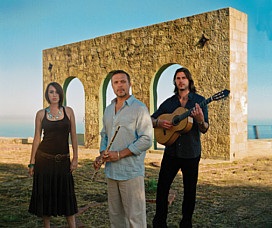 Dana has been the core inspiration behind the experience and story that became Thirty-One Nights. I was going through a very difficult time with many changes in my life and she was continuing on with her studies in Spain and in Mexico. We became romantically involved and the next thing I know I asked her to record some spoken word vocals on a track that became track 13 Recuerdame, on the album.
Dana has been the core inspiration behind the experience and story that became Thirty-One Nights. I was going through a very difficult time with many changes in my life and she was continuing on with her studies in Spain and in Mexico. We became romantically involved and the next thing I know I asked her to record some spoken word vocals on a track that became track 13 Recuerdame, on the album.
She has a gorgeous balanced tone in her speaking voice and it was an instant match and hit for me in the studio and many more tracks followed! It’s difficult to make spoken word work within music; it has to be just right! Dana and I now work passionately together in many aspects of our lives. We spent thirty one nights together in Mexico recording flutes on top of Mayan pyramids and writing poetry deep in the jungle. She’s one smart cookie, has a healthy and balanced perspective on life, and someone I want to associate and grow with for a very long time.
John: What are the vital key elements Dana and Chris convey to your instrumental with vocals composition Thirty-One Nights?
Nicholas Gunn: Well, Chris comes from an extremely studied background in music with a master’s degree from Cal Arts in Flamenco guitar. It was important to me that I had an authentic approach and sound for Thirty-One Nights. Authentic Flamenco playing includes so many different aspects, such as the knocking on the guitar body, types of open strumming and closed strumming and where picking occurs over the sound hole. Even finer details, such as which part of the finger nail is used to create different sounds against the string, are all important factors!
The guitar itself is vital to the sound. Chris plays on a handcrafted Manuel Bellido guitar which includes design features such as a wider neck and intricate body/sound hole design. Nylon strings are always used, of a certain type, and after a certain amount of wear. There are no pickups used in recording and a single microphone placement to capture a clean natural sound. These are all important factors that create a certain resonance consistent with Flamenco guitar. His writing style is also different than mine which lends to a well-balanced album that transitions at all the right spots. It’s a good partnership in that we are different in all the right ways! With Dana it is about a personal and emotional connection that is intimate.
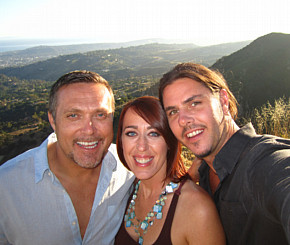 We experienced Thirty-One Nights together in real time and she has watched, supported, and participated in the unfolding of the album over a year and a half. She has a beautiful speaking voice and her bilingual abilities were a perfect and authentic evocative addition to the album. I have used spoken word sparingly before, and I am telling you, it’s a hard thing to pull off! Dana just had this tone and approach that was, well otherworldly, very seductive such as on The Swallows of Na’ Lu’um. We walked together through jungles, remote Mayan pyramids, went cave diving in Senotes, and used this experience to fuel creativity. Dana wrote about her experiences and created poetry centric to the experience. Dana and I are continuing to work on other exciting projects and in business together. We are partners in many ways.
We experienced Thirty-One Nights together in real time and she has watched, supported, and participated in the unfolding of the album over a year and a half. She has a beautiful speaking voice and her bilingual abilities were a perfect and authentic evocative addition to the album. I have used spoken word sparingly before, and I am telling you, it’s a hard thing to pull off! Dana just had this tone and approach that was, well otherworldly, very seductive such as on The Swallows of Na’ Lu’um. We walked together through jungles, remote Mayan pyramids, went cave diving in Senotes, and used this experience to fuel creativity. Dana wrote about her experiences and created poetry centric to the experience. Dana and I are continuing to work on other exciting projects and in business together. We are partners in many ways.
John: Would you like to tell us more of the story for Thirty-One Nights, and inspiration behind the songs?
Nicholas Gunn: There is a special Thirty-One Nights storybook PDF, with personal photos, that is embedded on the CD and is also available with a full album download. It would be my pleasure to share this with your readers and is the best way to answer this question. Enjoy!
John: I read Thirty-One Nights had a release date of September 11, 2012. Was there any significance of releasing Thirty-One Nights on 9/11, a date now recognized as the American Federal Holiday – Patriot Day?
Nicholas Gunn: No, not at all. Here is the thing; September 11th is a recognized national street date with most major music distributors. This street date has long been in place before the unfortunate events of 9/11. I decided to sign with label Spring Hill Media, distributed by Allegro Media and their system adheres to these dates. I try not to make any political or religious references in my music and this date did not influence me in any way. A broad stroke approach to creating provocative, moving, and inspirational music is my only goal.
John: You have a great number of National Park records, which began under Real Music Record Label. The Music of the Grand Canyon, Beyond Grand Canyon, Through the Great Smoky Mountains, Journey to Yellowstone, plus there are others. How and why did you become involved with the production of National Parks releases?
Nicholas Gunn: Shortly after The Sacred Fire was released (1994) Real Music approached me about a series of recordings they were developing called The National Park Series. I believe they already had one in the bag and it had sold well in its early stages focusing on park stores and alternative retail such Natural Wonders and Nature Company. The idea fit perfectly into the current trend and retail base. My albums initially were inspired by natural surroundings so it was a perfect fit. It was a huge success and continues to be a great catalog album. Naturally, I continued to release additional National Park albums based on request as well as desire to sustain sales and awareness for our National Parks.
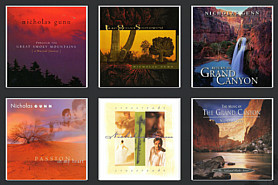 John: Every one of your National Park albums is like a colorful canvas. Each has their own merits, but how would you best describe the sound qualities of your National Park releases?
John: Every one of your National Park albums is like a colorful canvas. Each has their own merits, but how would you best describe the sound qualities of your National Park releases?
Nicholas Gunn: Cinematic is the word that always comes to mind for me. Cinematic music to me is like a soundtrack to be played against experiencing these natural wonders. Over and over again, I have received letters and emails from folks saying “we drove to the South Rim listening to The Music of the Grand Canyon” or “hiked the Appalachian Trail listening to Through the Great Smoky Mountains.”
Like Thirty-One Nights these albums were inspired, in essence, by travel and geographic location. The only difference being that my artist persona somewhat hid behind the National Park theme.
John: In the late 1990’s you founded the Anagram Records Label, and earlier you founded Gemini Sun Records, a label with numerous award-winning artist, many of whom were artists like yourself who made the Top Ten Billboard Charts. Who are some of the artists on the Gemini Sun Record Label under your direction?
Nicholas Gunn: Anagram existed for only around a year or so when I was previously married and it had two other license deals, one with Mars Lasar and one with Loren Gold as well as Cheryl Gunn’s titles and a few of mine as well. When I was divorced, Anagram dissolved and I started Gemini Sun Records. Gemini Sun Records also closed for business in 2009. Both were started as a way to represent artists in the genre of New Age/World Music that was steadily shrinking.
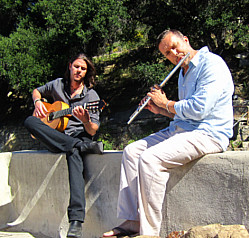 Labels such as Higher Octave, Windham Hill, and Narada were closing or being sold off to the majors as their assets in masters and publishing were the only thing left, sales were dwindling fast! The days of supporting retail such as Natural Wonders and Nature Company were now gone and artists coming off of these closing labels needed a home. Gemini Sun became that home for a select few; David Arkenstone, 2002, Mars Lasar, Medwyn Goodall, through MG Music, Loren Gold, and myself were just a few of the artists it represented!
Labels such as Higher Octave, Windham Hill, and Narada were closing or being sold off to the majors as their assets in masters and publishing were the only thing left, sales were dwindling fast! The days of supporting retail such as Natural Wonders and Nature Company were now gone and artists coming off of these closing labels needed a home. Gemini Sun became that home for a select few; David Arkenstone, 2002, Mars Lasar, Medwyn Goodall, through MG Music, Loren Gold, and myself were just a few of the artists it represented!
John: Would you like to tell us some of the highlights and other aspects, including the drawbacks of owning your own record label?
Nicholas Gunn: In my opinion, it’s a trap in many ways and little positive to talk about. It’s a thankless job that few take on to the degree I did as an artist owned label. I took it on to increase my profitability per sale, to make a difference in a market segment, and to represent great music and artists allowing them to own their own property (masters and publishing). Most artists block the desire to want to know or deal with national distribution, marketing, and promotion – and for good reason! It’s as stressful as hell!
The intricacies of managing the small margins associated with indie national distribution, marketing, and promotion of a niche label within a declining industry, within a declining economy is nothing short of a nightmare! Distributors are set up to protect their bottom line, at all costs! By cross collateralizing all returns, marketing, and promotion against all sales, the music business on this level is nothing more than a consignment business at massive risk to the label. If you couple that with major retailers who fail to comply with retail campaigns but then charge for the advertising they failed to comply with, it’s a fundamentally flawed system that produced the music industry we see and experience today.
John: The entire music industry as a whole has greatly changed over the years since you began producing music. What are some observations you have made over the years, and in what way has the music industry changed, for better or worse?
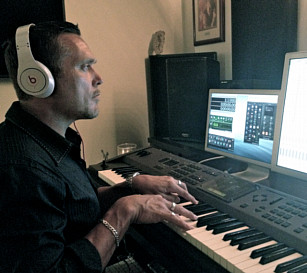 Nicholas Gunn: It’s still finding its way, but for the better! Like any business, it’s all about supply and demand and there is little demand for music sales as it used to exist. Music sales are not the future that I am relatively sure of! The use of music continues to be high, but through streaming, illegal downloading and sharing, and second hand online sales from the massive returns and recycling of the music industry as a whole. It’s all spread very thin at little profit to anyone, including the labels. I think there are a few models to watch, one of which would be the Electronic Dance Music market (EDM).
Nicholas Gunn: It’s still finding its way, but for the better! Like any business, it’s all about supply and demand and there is little demand for music sales as it used to exist. Music sales are not the future that I am relatively sure of! The use of music continues to be high, but through streaming, illegal downloading and sharing, and second hand online sales from the massive returns and recycling of the music industry as a whole. It’s all spread very thin at little profit to anyone, including the labels. I think there are a few models to watch, one of which would be the Electronic Dance Music market (EDM).
This is a model that has been born in the new distribution and profiteering age of music. Here is a platform with which DJ’s are now producing their own content in the studio and performing through the DJ method at low cost and extremely high output. The concept of sales has never been a priority and sharing/remixing within the community is embraced as a way to popularize the genre and its originating artist. The revenues are in packing 100,000 fans into a venue with the requirement the DJ/Producer simply show up with their gear over their shoulder! It’s brilliant!
The top ten DJ/Producers last year collectively made 127 million dollars and stand atop the industry money making leaders. Now, I am not talking about wedding DJ’s, I am talking about talented DJ/Producers – there’s a big difference! Secondly, and this is important I believe, we need to realize that music, especially in recorded form, is now highly dispensable and transferable. A great song, performance, and recording is still just that, great! It will always be consumed, but the real question becomes what will be the support mechanism that will allow for the creation and performance of this content?
Successful artists have a somewhat self-sustaining system, however how does a new unsigned artist become self-sustaining? I believe we are reverting back to the times when art was supported by benefactors and leaders within both business and government. Companies need art to further define and align their products within the marketplace, and leaders of countries will continue to require education and culture in arts to further the human race. It’s now about selling your talent to a group that needs your involvement to further its own cause, that’s how I see it.
 John: Can you foresee any trends developing that may influence your work and perhaps the work of other artists as a whole?
John: Can you foresee any trends developing that may influence your work and perhaps the work of other artists as a whole?
Nicholas Gunn: Quite frankly, this is my last album in the genre for the foreseeable future. I have a great passion for all music and the music business itself and I find the trend of developing more instrumental music within the current instrumental market place quite frustrating and stifling. There really are no venues that support the live performance of this genre and sales are at an all-time low. It’s a testament to my love of the genre that has produced Thirty-One Nights. I wanted to have an album I personally could be really proud of as my departure album.
On the side over the years I have produced my fair share of EDM as it does tend to border on instrumental at times. I have partnered with artist/vocalist Carmen Rainier and we have a project in the works titled (We Are) Nexus. It’s refreshing and invigorating to be a part of a larger and emerging music community that fully embraces the future of the music business. I am a musician and producer first and foremost and I got into this business for my work to be heard. This is the next chapter of my musical career.
John: I heard Thirty-One Nights is on the upcoming nomination ballot for Best New Age Album in the 55th GRAMMY® Awards on Feb. 10, 2013.You will know if nominated on December 5, 2012 isn’t that right, and is there any manner in which Nicholas Gunn fans can support your nomination for a possible music award?
Nicholas Gunn: Actually, it is on the ballot for Best World Music Album which I believe is more appropriate for the album itself. Yes, December 5th is when I will know if Thirty-One Nights receives a nomination. The award is really a peer recognition process of which fans have little part in unless they are a voting member of the academy. All I can say is that after 14 albums, two million sales, and 55 consecutive weeks on the Billboard chart it would be nice to be recognized by my peers; however it will not change the way I go about developing the next chapter of my musical career.
John: Naturally a GRAMMY® Award would put you in the spotlight as an artist, but aside from your own talents as a musician, what external factors have been the greatest influences to your success?
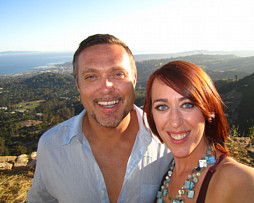 Nicholas Gunn: I would say it’s in taking the risk of wearing all these hats over the years as an artist, writer, producer, engineer, label owner. They all make up for my experience in the business and how I now see the business. Granted, closing my label was an awful experience but liberating and defining all at the same moment. Every passionate path is littered with debris of some sorts and it’s having those experiences that have given me a greater understanding of what I want and what I don’t want. I believe my most successful days lie ahead of me because of this.
Nicholas Gunn: I would say it’s in taking the risk of wearing all these hats over the years as an artist, writer, producer, engineer, label owner. They all make up for my experience in the business and how I now see the business. Granted, closing my label was an awful experience but liberating and defining all at the same moment. Every passionate path is littered with debris of some sorts and it’s having those experiences that have given me a greater understanding of what I want and what I don’t want. I believe my most successful days lie ahead of me because of this.
John: During your career you have contributed money to the National Park organization, American Lung Association, plus you are on the board of directors for the Children’s Creative Project (CCP), in Santa Barbara, California. Clearly the arts and music education for children and other charitable organizations are important to you. Would you like to tell us about your Philanthropy work, and why it is important to you on a personal level?
Nicholas Gunn: Arts and education for children is paramount. I am a result of parents and a system that exposed me to a finer education in art and music. As a society, we tend to embrace mediocrity as a way to shy away from having to learn more about something, it’s an innate human trait. I sit on the board for the Children’s Creative Project because it grants much needed funding for events that expose children to fine art. It’s simply a matter of proper exposure. We become mediocre when we get older, but we are not that way as children. We learn what we are taught and we soak it all up, no matter which way it comes at us early in life. Real Music initiated the donation to The Grand Canyon Association from sales of The Music of the Grand Canyon.
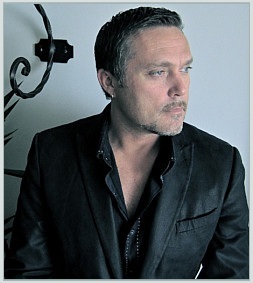 It was and still is a wonderful cause as the money promotes education and awareness of preservation to both children and adults. This trend carried forth for me through realizing it’s important to give back in this manner. Money is cyclical. You have to give as much as you receive.
It was and still is a wonderful cause as the money promotes education and awareness of preservation to both children and adults. This trend carried forth for me through realizing it’s important to give back in this manner. Money is cyclical. You have to give as much as you receive.
John: I would love to release some Nicholas Gunn news about a new project or a concert tour in the planning stages. Is there any additional news you would like to officially announce today?
Nicholas Gunn: I am sorry to say I think the biggest news might be found in my departure from the genre for the foreseeable future. But on a positive note, I have much to give and much to share, only within a different genre. I recently launched a new current events news page at NicholasGunn.com/News. I recommend everyone visit to see what’s new there!
John: Nicholas you are a legendary instrumental artist, regardless of genre or classification, and that my friend will never change! Needless to say I trust we will have a chance to interview again in the future. In closing for now, I want to thank you again for giving everyone this opportunity to find out the latest news about you, and your newest project with Dana Kemmerle and Chris Fossek. Is there anything you would like to say before we close, or express to the fans that have supported you over the course of your career?
Nicholas Gunn: I do want to thank, from the bottom of my heart, the valued fans that have supported me over the years. For passionate people such as you John that still see the value and potential in this beautiful genre of music. There are so many people really, over the years, that have helped me realize my goals, and of course I thank them all. I am eternally grateful.
For more information visit NicholasGunn.com. Sample or purchase albums and songs at the Nicholas Gunn music shop. Find details like the making of Thirty-One Nights, info about Dana and Chris, and visit Nicholas at social sites like Facebook. You can also find albums at major online music stores, including the artist page for Nicholas Gunn at Amazon.com. Interview photos are courtesy nicholasgunn.com & Big Stock Photo – Ardith.

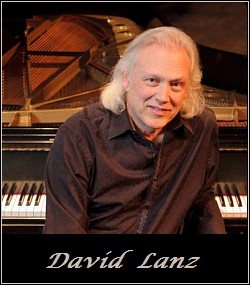 Newest Interview with Pianist David Lanz prior to 2013.
Newest Interview with Pianist David Lanz prior to 2013.
Platinum selling pianist David Lanz is a legendary instrumental recording and concert artist who achieved worldwide prominence early on in the New Age music genre, and over the course of his lengthy career which spans decades. Today David Lanz is recognized as one of the leading concert pianists, and instrumental recording artist.
David Lanz celebrates the 25 year anniversary of Cristofori’s Dream in 2012 by the release of a brand new recorded version of his most popular piano album. New Age Music World host John P. Olsen had an opportunity to interview David Lanz prior to the New Year 2013.
This newest interview covers a variety of topics, including the new solo piano, and piano with instrumental recordings of Cristofori’s Dream, Liverpool – Re-imagining the Beatles, Here Comes the Sun, and a new Christmas album project scheduled for release in 2012.
During this interview with David Lanz there are also questions about his career achievements and personal style as composer. We are pleased to present their conversation to David Lanz’s international fan base and our site visitors.
John P. Olsen: Thank you for giving everyone a moment of your time David. Like your fans, I too have admired your music for many years, so our interview today is especially rewarding to me.
You gained prominence as a new age artist early in your career, and have enjoyed many successes along the way. Let me begin our interview by first congratulating you on a remarkable 25 year career David!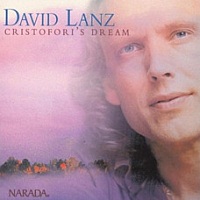
David Lanz: Thanks John, I am happy to be here and speaking with you today!
John: Decades ago you helped put the New Age Music Genre on the forefront by release of Cristofori’s Dream. In fact Billboard Magazine selected Cristofori’s Dream as the #1 album in 1988 when they introduced the Billboard Adult Alternative/New Age Album Chart for the first time. Are you optimistic your 2012 Cristofori’s Dream releases, in either version, may make the Billboard Chart again?
David Lanz: That would be great, however I do not really pay as much attention to charts anymore and without a major label doing the leg work, it may be a stretch, but hope springs eternal – right?
John: Was the overwhelming success of Cristofori’s Dream in 1988 a surprise to you at all, or did you feel after completion you had produced an album, many people then and now consider a masterpiece?
David Lanz: I remember both Paul Speer and I (Paul was my co-producer) sitting and listening to the final mix and thinking, “This is a good record.” That was our response, so the overwhelming success did catch us a bit off guard! When you are doing your work-you don’t really stop to think about its impact, only that you are either satisfied or not.
John: Cristofori’s Dream is your most popular album. What do you feel are the key characteristics about the original Cristofori’s Dream that have made this one of your top selling albums of all time?
David Lanz: There were a number of factors. The timing was right, as radio was very open to the album. The cover version of A Whiter Shade of Pale was a great bridge between pop instrumental and New Age music, and the fact that I had tapped into history by bringing Cristofori’s work and name into the hearts, minds, and ears of the public was a major factor I believe.
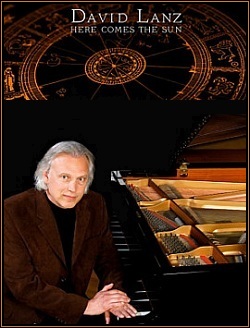 John: How are the first and second Cristofori’s Dream albums alike, and in what ways do the two albums vary?
John: How are the first and second Cristofori’s Dream albums alike, and in what ways do the two albums vary?
David Lanz: Well, the list of songs is the same, but they have been opened up a bit with variations and improvisation and recorded as solo piano pieces this time, without the extras like strings, synths, percussion, etc.
We have also included several bonus tracks not found on the original and created a 16-page booklet that gets into the making of as well as giving historical background on Cristofori himself.
John: During the early years when you lived in Seattle Washington you played in bands, covering a variety of music genres including Rock, Pop, Jazz and Blues. You are widely recognized as an innovator and new age music superstar by your early recordings. In retrospect, what was the catalyst that began your transition to composing and performing new age music?
David Lanz: As I matured as a musician, and as a spiritually aware human, I looked around to see what I could contribute through my music, and the answer was found in a more introspective music and an attitude that focused on the attributes of healing and relaxation. This was the answer to my question, “What does the world need from me?”
John: I have always felt the Piano is perhaps one of the best instruments to express the depth of oneself on a personal level. What was the connection, or reasons you chose the piano over other instruments?
David Lanz: Well that was pretty simple. Both my grandmother and mother played the piano, and they each had pianos in their homes, so I was exposed to that influence as a child and had a natural curiosity about the piano, which led my mother to get me started with piano lessons before I was even 5 years old.
John: As an original song composer, how do you go about the process of composing solo piano music?
David Lanz: That is a big question. Honestly, every song has its own story of origin. The easiest answer is I sometimes just sit at the piano, and improvise until I play something that catches my ear – and it goes from there. There are times however when something in my life will directly affect me emotionally, and then I am able to transform those feelings into music.
John: What led you to compose Cristofori’s Dream?
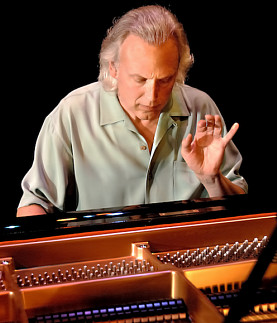 David Lanz: There is a great explanation of that in the liner notes of the new recording. The spark, the divine seed if you will for Cristofori’s Dream, was found in Judith Oringer’s book, Passion for the Piano, a gift received from a good friend, and a very fortuitous gift it turned out to be! In the forward of this book about the piano and various pianists throughout history, was a dedication to a one, Bartolomeo Cristofori, “the inventor of the piano.”
David Lanz: There is a great explanation of that in the liner notes of the new recording. The spark, the divine seed if you will for Cristofori’s Dream, was found in Judith Oringer’s book, Passion for the Piano, a gift received from a good friend, and a very fortuitous gift it turned out to be! In the forward of this book about the piano and various pianists throughout history, was a dedication to a one, Bartolomeo Cristofori, “the inventor of the piano.”
You could have knocked me over with a feather! There I stood in the middle of my kitchen, mouth agape, a thirty something year old pianist who had played the piano most of his life, but had never once stopped to consider that the piano had an inventor. Hello!
Immediately upon seeing the name Cristofori, my imagination mimicked the name and whispered in my mind, “Christ-Euphoria,” followed directly by the title, Cristofori’s Dream. This was a defining moment! It was also highly unusual for me, as song titles rarely appear like this, if ever, or precede a composition, almost always coming to me during or even after a piece has been composed.”
John: You have more new releases for 2012 including The Beatles inspired Here Comes The Sun, which is available in two separate versions. Apart from the solo piano and piano with instrumental aspects, what are the style variances in the way they were composed and recorded?
David Lanz: I always arrange my pieces to stand alone as solo piano arrangements. I do usually leave space in my arrangements as a matter of style. This allows the use of other instruments, but the piano always carries the melody and can easily standalone without any other musical embellishment.
John: Liverpool – Re-imagining the Beatles & Here Comes the Sun are both beautiful with exclusive variations in style. What are the distinctions from one another?
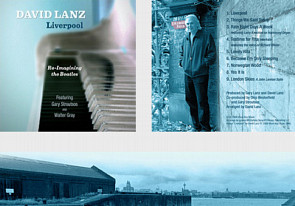 David Lanz: Liverpool was recorded pretty much live in the studio with a bit larger cast of musician, including drums and hand percussion, making rhythm a larger part of the sound. On Here Comes The Sun, we have more of a chamber sound with the music being performed on piano cello and flute only.
David Lanz: Liverpool was recorded pretty much live in the studio with a bit larger cast of musician, including drums and hand percussion, making rhythm a larger part of the sound. On Here Comes The Sun, we have more of a chamber sound with the music being performed on piano cello and flute only.
We referred to ourselves (the 3 of us) as the Liverpool Trio, and performed as the same. Both albums feature primarily the music of Lennon and McCartney, but Here Comes The Sun of course features that wonderful piece from George Harrison as well as an original piece I dedicated to both him and George Martin entitled Sir George-Liverpool Farewell.
John: Clearly The Beatles influence on music worldwide cannot be overstated, but on a personal level, what elements about The Beatles music that compels you to compose and perform their cover songs?
David Lanz: I grew up as a musician and a young composer, being much influenced by the way they composed their songs. I wanted to pass the torch, so to speak, as I have a younger generation of composers who look too my work. I wanted them to see where much of my early influence and inspiration has come from. I believe our early influences really help to shape us in whatever we do in life.
John: How do you make your song selections from the many great albums and songs by The Beatles?
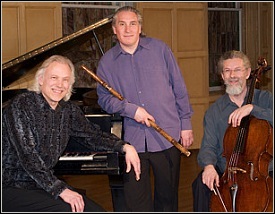 David Lanz: That was a very long process of listening and just trying them out on the piano to see how they laid under my hands. It was a very long labor of love!
David Lanz: That was a very long process of listening and just trying them out on the piano to see how they laid under my hands. It was a very long labor of love!
John: You also have a brand new songbook titled The David Lanz Collection 2000-2011, which is a special group of songs with a connection to family and friends. Would you like to give the details about this new songbook collection?
David Lanz: it was simply a way to put a few highlights from the last decade of music I’ve composed and recorded into a collection for those folks who may only be exposed to my earlier work from the 80’s and 90’s.
There is a very special piece dedicated to my friend Robbie King, who was a musical mentor and passed away several years ago, leaving us much too soon!
John: Being a prolific artist, there is an endless list of albums to choose from out of your current album collection. For anyone who may be new to your music, what 2 albums would you suggest they sample or purchase from each of your solo piano works and piano with instrumentals?
David Lanz: Skyline Firedance features both solo and ensemble versions of the album’s material. Look at Romantic – The Ultimate David Lanz Collection (a 2-CD set with a nice cross section from the first two decades of material, both solo and ensemble) or Painting The Sun and A Cup of Moonlight are a nice representation at my current solo piano work.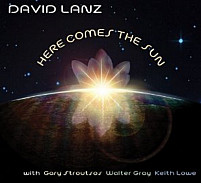
John: Your piano sheet music is quite a hit, and very popular seller too, isn’t that right?
David Lanz: Everywhere I go, I hear from piano teachers that tell me my music is not only popular with their students, but it is easy to teach and laid out well. It makes them look good and everyone is happy. There is now over a quarter of a million books of my music out in the world!
John: That’s impressive to have such a popular selection David! I’ve heard the news you have a new Christmas album for 2012. Can you give the title, and when will you be releasing your new Christmas album?
David Lanz: We are working on having that out by mid-November. This is a solo piano collection of Christmas music entitled Joy Noel.
John: I hope to release additional news for your fans and our readers today if possible. Can you release any news information or perhaps plans for a new album project?
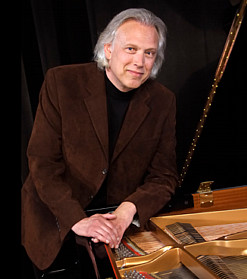 David Lanz: Well, after working on getting 2 new albums released in one year (don’t try that at home!) I will need to take a break and review my next project, which looks to be a solo piano recording. Much of the music is already sketched out, but I imagine I will jump back into to my composing, so stay tuned!
David Lanz: Well, after working on getting 2 new albums released in one year (don’t try that at home!) I will need to take a break and review my next project, which looks to be a solo piano recording. Much of the music is already sketched out, but I imagine I will jump back into to my composing, so stay tuned!
John: You have enjoyed a successful music career practically your entire life. What do you find the most rewarding experience as a professional musician?
David Lanz: Just being able to support my family and myself doing the work I love to do. I love being in the David Lanz business!
John: That’s great David, and I want to thank you again for giving everyone another opportunity to find out more about you, and your newest projects. I hope we can get together by another interview someday. Before we close, is there anything you would like to express to the fans that have supported you over the years?
David Lanz: I am and have been so grateful for the opportunity to express myself in music. To have been so embraced by my fans and other pianists is really overwhelming! I am extremely grateful for this opportunity to do my work and serve the world on my own terms!
Visit DavidLanz.com for news and information about concerts and workshops. Visit the DavidLanz.com Store for CD albums, downloads, and merchandise like DVDs, songbooks and sheet music. Visit the artist section for David Lanz at Amazon. Interview photos courtesy BHP Images, Carole May Images, Kyle Zimmerman & davidlanz.com.

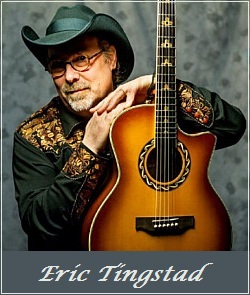 Interview in 2012 with GRAMMY Award-Winning Guitarist, and Cheshire Studios Record Producer Eric Tingstad.
Interview in 2012 with GRAMMY Award-Winning Guitarist, and Cheshire Studios Record Producer Eric Tingstad.
Eric Tingstad is a distinguished artist and record producer who over the course of his lengthy career has recorded many fine albums in a variety of genres.
Famous for his expertise as a songwriting guitarist in a variety of genres, the diverse range of influences include Americana, alternative country, ambient, blues, jazz, rock and new age music. Eric Tingstad’s new release Badlands is a vibrant follow-up to his GRAMMY® Nominated album Southwest.
New Age Music World site host John P. Olsen had an opportunity to interview New Age GRAMMY® Award recipient Eric Tingstad in October of 2012. This interview publication with a variety of topics follows the release of his new 2012 album titled Badlands. Today we are pleased to present their conversation to his fans and to all international site visitors.
John P. Olsen: I would like to thank you for accepting my invitation for this interview Eric. In addition to being a distinguished GRAMMY® Award-winning artist and guitarist, you are also a record producer, so I hope to cover many aspects of your life and career in music during our interview today.
Let me begin by saying your newest Americana album titled Badlands is a wonderfully unique release Eric! I found Badlands is miles apart in theme and style from the majority of new age, world and instrumental albums I have reviewed this year. Writing a Badlands review was a nice change of pace for me. I found it to be a beautifully picturesque album Eric.
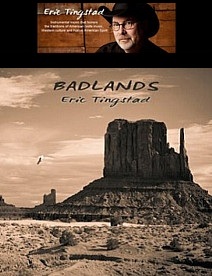 Eric Tingstad: Thank you very much. I have to say that when Badlands was all done, I was very happy to hear how relaxed all the pieces were feeling. Even though there are more teeth and beef than on previously hailed “calming” recordings of mine, Badlands just has this laid back pocket and groove that I was very pleased to hear.
Eric Tingstad: Thank you very much. I have to say that when Badlands was all done, I was very happy to hear how relaxed all the pieces were feeling. Even though there are more teeth and beef than on previously hailed “calming” recordings of mine, Badlands just has this laid back pocket and groove that I was very pleased to hear.
It’s like some really big guy giving you a massage or a powerful engine that’s just idling. A lot of headroom. And whereas Southwest was a bit more gentle, tender and soothing and that all is bliss in the desert, Badlands intentionally has more grit and attitude. Not so much about the spiritual ambiance of the Southwest, but more of the human element and how it resonates with the harshness of the environment.
John: Your new 2012 Americana album Badlands honors the traditions of American roots music and Western culture, and is unique from many previous albums like Acoustic Elegance: Ultimate Collection, Acoustic Garden, Paradise & American Acoustic. How did the idea or inspiration for Badlands originate?
Eric Tingstad: Badlands is the follow up CD to my 2007 release, Southwest and continues my adventures of combining ambient elements and vibe with American roots music. My early musical influences were what I heard on the TV as soundtracks for movies and shows. I watched a lot of western adventures and the Beverly Hillbillies, which was just rich in the roots music of Flatt and Scruggs.
Also one of my earliest mentors was a lap steel player and I was fascinated with that sound that he got by using a table knife! Growing up I had a real cross cultural group of friends and I was fortunate to have some Elders in my life as a child that taught me “the ways.” They had an effect on my beliefs and subsequent interests in Native American culture. Also on Badlands there is my crunchy telecaster underpinnings that contributes an edgy quality and brings me out of my rock n roll closet a bit. I would also have to say that the music of Angelo Badalamenti from Twin Peaks or Ennio Morricone resonates with me. It’s music that creates a sense of place.
John: Badlands features a number of great artist including Nancy Rumbel, Cindy Cashdollar, Byron Metcalf and other fine contributing instrumental artists. Would you like to tell us about some of the artists who perform on Badlands?
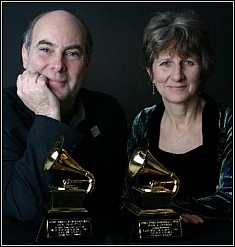 Eric Tingstad: On Badlands I intentionally set out to feature more Western elements and a bit less Native American. And so I pulled back on the native flutes and featured more of the dobro, (both slide and fingerstyle), which conjures up that American roots element and the pedal steel and lap steel that bring out the western sound. I also leaned pretty heavily on the fiddle which was played by Andrew Joslyn.
Eric Tingstad: On Badlands I intentionally set out to feature more Western elements and a bit less Native American. And so I pulled back on the native flutes and featured more of the dobro, (both slide and fingerstyle), which conjures up that American roots element and the pedal steel and lap steel that bring out the western sound. I also leaned pretty heavily on the fiddle which was played by Andrew Joslyn.
The one major component that is the foundation for both Southwest and Badlands is all that great shamanic hand drumming was done by Byron Metcalf. The frame drumming not only ties it all together, but brings that spirit of western landscape and depth of the Native American culture to the recording. I use these instruments because I love the way they sound. And the way they were played.
I did the fingerstyle playing on the dobro but Cindy Cashdollar did all the cool dobro slide work along with lap steel. I did a bit of the pedal steel but all the amazing stuff was done by Terry Lauber. Ben Smith from Heart supplied all the drum kit efforts. There is a large cast of players involved with Badlands. Counting the engineers, I think there were about a dozen.
John: I found Bandlands very picturesque, with ingrained cinematic qualities. Would you say the same, and do you knowingly make an effort to compose music with incorporated cinematic qualities?
Eric Tingstad: Thank you, but I do not set out to make music with cinematic qualities. What I do, is set out to make music that creates a sense of place. I suppose if I makes you see pictures in your head I have achieved that … partially. But, I also want you to see and feel the dryness, the warmth and smell the smells of my locations and themes. Maybe even make you thirsty or hungry.
John: Currently you also provide guitar instruction and offer consultation in the music business. Could you provide some specifics on the services you offer to artists wanting to improve their chances at succeeding in the music business, or artists who want to improve their individual performance goals?
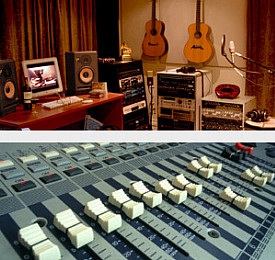 Eric Tingstad: There are many misconceptions about how the music industry works. What I try to do is help with clearing those up and set a realistic course for each individual. It’s helping that I love to do and each client has been different with different needs and expectations. There are so many ways to be involved in the music industry these days and understanding the options is how I can add value to someone’s efforts.
Eric Tingstad: There are many misconceptions about how the music industry works. What I try to do is help with clearing those up and set a realistic course for each individual. It’s helping that I love to do and each client has been different with different needs and expectations. There are so many ways to be involved in the music industry these days and understanding the options is how I can add value to someone’s efforts.
John: Pedal steel guitar is prominently featured on Badlands, but is primarily thought of as a country music instrument. Is there a challenge with transition into your Americana style of music?
Eric Tingstad: I did not find that it was all that difficult. I luv country and roots music and the pedal steel is a big part of why I luv that music. But mostly I luv the steel for it’s beautiful sound. It has such a pure, full and magical tone. It also has the quality of being able to create long legato phrasing, which is something I am always hearing in head. All kinds of music are being played on the Pedal Steel these days, especially rock. And then there is the whole Sacred Steel style of the Campbell Brothers and Robert Randolf.
John: What made you decide to begin performing on a pedal steel guitar, and is the learning curve, or degree of difficulty, far apart from a traditional acoustic or electric guitar?
Eric Tingstad: I was actually recording and producing other players on the steel with my music before I decided to try my own hand at it. I find the pedal steel to be pretty easy to play and some of my favorite styling for it are the simple passages that demonstrate the warm tone of the instrument. The learning curve was not too bad. I am sure that it helped that I had a pretty good grip on guitar and music in general.
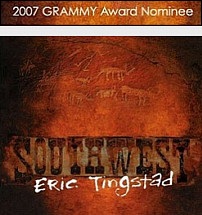 John: I read you perform in the Segovia tradition, but is this style is implemented on a steel strung classical guitar. Could you tell us about some of the finer points regarding this specific performance style?
John: I read you perform in the Segovia tradition, but is this style is implemented on a steel strung classical guitar. Could you tell us about some of the finer points regarding this specific performance style?
Eric Tingstad: I was playing for about 10 years as a youngster before I become involved with studying the classic guitar. I was interested in developing a very fluent fingerstyle both for the right and left hand. I think my classical studies were about the smartest thing I ever did for my career. Apart from just learning the proper physical technique I learned a lot about making the guitar sing with a strong sense of phrasing. I also put a lot of stock in the tone I try and generate.
John: In addition to composing, recording and producing your own music, you are an established record producer who assists other artists including Tingstad and Rumbel, Narayan & Janet, The Halyards, The Road Trip Relief Squad and Louis Landon. Would you like to tell us about your role as a record producer, and provide some details about your music recording and production services at Cheshire Studios?
Eric Tingstad: I like to think of myself as sort of old school when it comes to production. I don’t try to commit the artist to “my sound” but act as a one member audience that gives feedback from that point of view. It’s valuable to remind the artist of the often simple and “taken for granted” things they do that resonates with the listener. I always try to focus on what is best for the song and what will support the lead vocal or instrument line. The goal is to help flush out the intent of the project and keep the artist focused on that original intent. Not always easy to do.
John: You have enjoyed a remarkable music career for over 35 years with many successes along the way Eric. What do you find most rewarding first, as a professional record producer, and secondly as a respected musician?
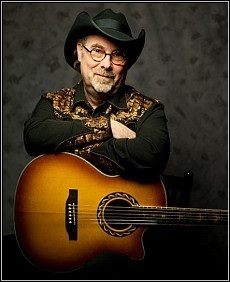 Eric Tingstad: I don’t really think of my part in this wonderful world of music in terms of rewards and respect. I just luv how the music I like makes me feel. I like to listen to music as much as I do to play it and if I can make others feel like I do, then that is all the more better. Helping others realize their musical vision with my production skills is a thrill though and brings me a lot of personal satisfaction. There are so many levels and reasons to enjoy music and I am fascinated by what other players have to offer.
Eric Tingstad: I don’t really think of my part in this wonderful world of music in terms of rewards and respect. I just luv how the music I like makes me feel. I like to listen to music as much as I do to play it and if I can make others feel like I do, then that is all the more better. Helping others realize their musical vision with my production skills is a thrill though and brings me a lot of personal satisfaction. There are so many levels and reasons to enjoy music and I am fascinated by what other players have to offer.
John: I like to report on current music news when I can, so I would like to ask if you have any news announcements or information to pass along about new album projects or special events you plan to make public soon?
Eric Tingstad: I will be continuing in this Instrumental Americana style I have got going now for a couple more projects at least. I will be doing one that is a bit sparser on the production and one that actually will have more vocals. I do lots of songwriting as well with others that needs to be released at some point.
John: Thank you again for allowing me host your most current interview Eric. It’s an honor to meet you, and I wish you continued success. It has been a privilege to provide today’s news coverage about you and your newest release Badlands. It’s a great album and I look forward to your next new release.
Visit the main pages at EricTingstad.com. Purchase or sample albums and songs at Eric Tingstad’s music store or find the best songs and albums by Eric Tingstad at iTunes. Photos are courtesy erictingstad.com & cheshire-studios.com.

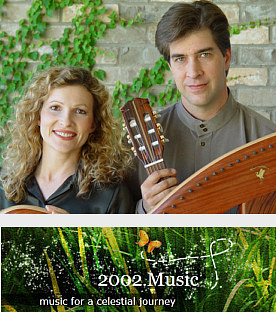 Pamela and Randy Copus of the popular music group 2002 have an interview conversation with New Age Music World host John Olsen about 2002’s newest album titled Believe.
Pamela and Randy Copus of the popular music group 2002 have an interview conversation with New Age Music World host John Olsen about 2002’s newest album titled Believe.
The newest album by 2002 titled Believe is scheduled to be released on October 15, 2012. Believe will be the 14th album by Pamela and Randy Copus since they released their first album as the duo “2002” in 1992.
This year marks the 20th anniversary for the award-winning group 2002. During this interview taking place during September 2012, Pamela and Randy Copus each give individual responses about their newest release and what the future holds for the popular music group 2002.
John Olsen: Thank you both for giving me and your fans a moment of your time. I enjoyed getting to know you over the past few years, and more recently by our earlier interview in 2011.
Let me begin the conversation by saying your newest album Believe, due to be released on October 15th, is said to be unlike any of your previous albums. Knowing beforehand this release is more progressive from your earlier releases, what are some of the ways Believe is alike, and can you give some examples where Believe differs from your earlier releases?
Randy Copus: Believe is different from past albums in that we freely explored the use of lead vocals as a major component of the album. Over half the songs have lyrics. This is a normal evolution for us, I think, since we began our professional careers playing and singing in bands. Progressive rock influences are going to be easy to spot by listeners familiar with the genre. Having said that, there are elements and songs on this album that are quintessential 2002, our signature sound. It’s as though we took the last 20 years of our musical explorations and glued them together into one idea, yet no matter what direction the music takes, we still sound like “us.”
John: In comparison to earlier 2002 albums, was Believe a comparatively easy album for you to produce?
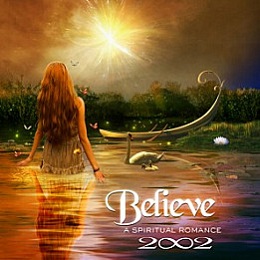 Pamela Copus: Actually none of them have been what I would call “easy to produce.” Some are more complicated and so have taken longer than others to complete. The fun thing about Believe is that each song seemed to really have a perfect spot as far as song order goes. It was magical!
Pamela Copus: Actually none of them have been what I would call “easy to produce.” Some are more complicated and so have taken longer than others to complete. The fun thing about Believe is that each song seemed to really have a perfect spot as far as song order goes. It was magical!
Randy Copus: I think it was one of the harder ones to produce, mainly because of the addition of so many vocals and lyrics. But, all our albums have been more or less hard to create; we set a very high bar for ourselves.
John: Is this a one of a kind album or do you plan to produce more music arrangements that more or less contrast your earlier albums?
Pamela Copus: The “new age” genre contains dozens of sub-genres. There are so many more paths to explore. Who knows where we will go next? We don’t feel pressured to fit into a particular mold. I personally enjoy a great variety of musical styles. As long as a song is good, it doesn’t really matter to me what category it is placed in. Believe was a lot of fun to create because we got to return to the roots of the music we considered good when we were growing up. Isn’t it amazing how certain songs never seem to grow old – even after decades?
Randy Copus: I think we will do more albums that contrast with our earlier works. At this point, our body of work is large enough to be able to explore new directions without alienating existing fans. If an album is a bit too progressive for them, for example, they have lots of the older, more “classic” 2002 available. As artists we have to keep moving forward, evolving, or the music will stagnate.
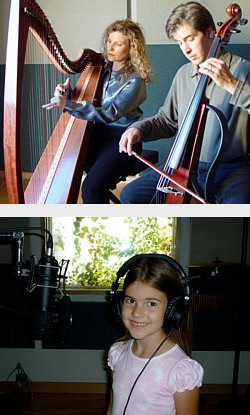 John: You mentioned that your earlier musical influences are noticeable on this album. What were some of your favorite bands growing up that may have influenced this album’s sound?
John: You mentioned that your earlier musical influences are noticeable on this album. What were some of your favorite bands growing up that may have influenced this album’s sound?
Pamela Copus: Some of my favorite bands growing up were Kansas, Genesis, Boston, Heart, and ELO. I also enjoyed listening to Vangelis, Chuck Mangione, and Andreas Vollenweider. Of course I love most classical music as well and I enjoyed playing in the school symphony.
Randy Copus: In the early days as a singer, I was influenced by all the great rock and progressive rock singers- Steve Walsh, Steve Perry, Getty Lee, Jon Anderson, Lou Graham to name a few. You will definitely hear those colors in my voice. Also, we grew up with a lot of great pop music, and there are elements of those influences in Believe as well.
John: The popular bands and artists you named are nearly identical to my favorites, even today. More importantly the artists and bands you named are beloved favorites for millions of people worldwide. New Age music is like all genres by the continual changes from year to year. In your opinion, do you believe new age music will turn out to be more popular or mainstream than its present day standing?
Pamela Copus: The lines separating the musical genres seem to be getting fuzzier. I think with the demise of “brick and mortar” music stores, there is no longer a finite amount of shelf space with a finite number of genres being represented. This is both good and bad. It’s bad in that it’s harder to just pull up a category and do any casual shopping. For example, I see things all the time on the iTunes new age chart that make me scratch my head wondering how that is called “new age” by any definition. At the same time, it’s good because people that would normally not discover some fabulous bit of music now do so quite by happy accident.
Randy Copus: I don’t know about the genre per se, but I do believe “that sound” will become more mainstream, because more people nowadays are looking for popular music that touches them on a spiritual level. It’s interesting- so many of the great new pop songs we hear lately are incorporating that ethereal, “new age” flavor, along with everything else. The Green Children, my current favorite pop group, comes to mind.
John: The year 2012 is your 20th year as the group 2002. You are a popular, award-winning music group whose hit music made the Billboard New Age Charts 9 times. Looking ahead, what’s next for 2002?
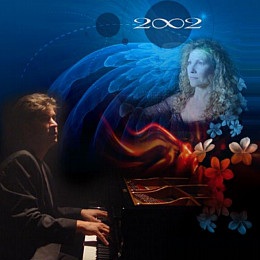 Pamela Copus: I’d love to go even farther into musical exploration – maybe a Celtic harp album with 2002 icing on top – or perhaps even a 2002 chill release. I see Sarah becoming more involved too. She inherited perfect pitch from Randy. In fact, she composed the main melody for the second song on Believe using a set of toy water flutes.
Pamela Copus: I’d love to go even farther into musical exploration – maybe a Celtic harp album with 2002 icing on top – or perhaps even a 2002 chill release. I see Sarah becoming more involved too. She inherited perfect pitch from Randy. In fact, she composed the main melody for the second song on Believe using a set of toy water flutes.
Randy Copus: We are really in such a wonderful place, artistically speaking. We don’t have label executives telling us what kind of albums to make, or what degree of risk we’re allowed to take, so we’re free to engage in any musical adventure that inspires us, as it should be. This is where the best music is going to come from, because it is truly the journey we’re on.
John: Thanks again for giving everyone another opportunity to find out more about you, and your newest project. Is there anything you would like to express to the people who have supported you over the years?
Pamela Copus: We have made such amazing friends in the world. They inspire us to continue, ever onward. Releasing a new album is never the end of the road – It’s just one more milestone on the journey. I hope our friends and fans will continue to enjoy the trip as much as we do.
Randy Copus: We will always be grateful to our friends and fans for the encouragement and support they have given us over the years. It’s been an amazing ride so far, and I believe the best is yet to come.
Find more news and information at 2002Music.com and pre-order Believe. In September you can pre-order the newest release Believe and find 2002 albums at Amazon.com. Cover artwork and all interview photos courtesy 2002music.com.

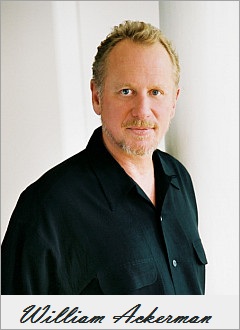 New Age Music World is pleased to present an in-depth, 2012 interview with GRAMMY® Award-winning guitarist, producer, and Windham Hill Records founder Will Ackerman.
New Age Music World is pleased to present an in-depth, 2012 interview with GRAMMY® Award-winning guitarist, producer, and Windham Hill Records founder Will Ackerman.
John P. Olsen: Thank you for accepting my invitation for this interview Will. It’s funny since I feel like I already know you in a way since I have written, and plan to write, reviews for artists who have their newest album produced by you at your Imaginary Road Studio in Vermont. It’s a privilege to finally meet you Will.
Will Ackerman: Hi John, I’ve been admiring what you’ve been doing online for some time and am delighted to have a chance to talk with you.
John: Many of these artists have received award recognition with albums that you produced. Many are now top ranked artists. To what degree does a producer ultimately affect the success of a music recording would you say?
Will Ackerman: Perhaps this is a crafty test of my humility? I hope I pass. Perhaps this is a question better asked of the musicians I’ve worked with. They’re better able to tell you how, specifically, I influenced their work. The process of producing is not at all formulaic for me; each project and human being has their own specific needs and my job is, as much as anything, to be conscious of what their needs are. How active I am in shaping a project is also a very individual matter.
In some cases I am simply helping to create a standard of excellence for the players to achieve in their recordings and in other instances I’m getting into the arranging of the work itself and being very active in envisioning how the material might be dramatically affected by additional production. It really is all over the place and I guess I’d say that my proudest achievement is to figure out where I can best be of help and respond to the person I’m working with rather than imposing the same set of Ackerman rules upon everyone.
John: Some may have a limited knowledge of a record or music producer’s role, and how a producer can greatly influence an artist’s instrumental music composition. Would you provide some details specific to your production services?
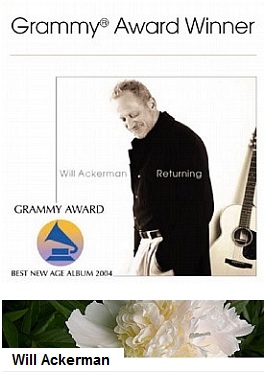 Will Ackerman: Again, the role of producer is simply all over the place. Looking back to Windham Hill days, I think of how my utterly subjective and spontaneous decision to edit George Winston’s Colors/Dance into the epic ten minute piece we know as opposed to the three minute piece it was intended to be is an example of how my instincts manifested themselves.
Will Ackerman: Again, the role of producer is simply all over the place. Looking back to Windham Hill days, I think of how my utterly subjective and spontaneous decision to edit George Winston’s Colors/Dance into the epic ten minute piece we know as opposed to the three minute piece it was intended to be is an example of how my instincts manifested themselves.
Likewise the decision engineer Steve Miller and I made on the dramatic guitar sound for Michael Hedges’ Ariel Boundaries was a milestone. Michael was initially outraged with the liberties we’d taken with what he heard as a simpler acoustic piece. Steve had provided an opportunity and I jumped at it. Michael needed to take a walk for about an hour before coming back to the board to listen, still somewhat incredulous that both Steve and I loved the sound.
I think this story tells a lot about how I work. It’s very subjective, intuitive and flexible. It’s a series of almost binary questions… yes and no… go there or don’t go there? I simply have to trust my instincts and earn the artists trust in those instincts as well. However much success I’ve had and can point to, each new artist I need work with needs to learn that they can trust me. That trust means more to me than anything. I take it very seriously.
John: I have more questions related to your present day role as a producer, but would you first like to tell us how your career began and how your business has progressed over the years?
Will Ackerman: I recorded my first album in 1975. An engineer named Scott Saxon offered to allow me to record free of charge if he was listed as producer and received a royalty. Not having a lot of dough in those days, I easily agreed. Scott then produced my second record, It Takes a Year as well. In watching Scott I learned a lot and at some point decided that I knew enough about recording and had a familiarity with my own tastes sufficient to allow me to trust in my abilities to call myself a producer.
In terms of how my endeavors have changed over the years, it’s easy to point to GRAMMY® nominations and awards, platinum and gold records, millions of records sold and all that. I’m proud of that of course, but I can say with utter sincerity that what I am proudest of is that I’m better at what I do than ever because this is a process of learning about people, learning about yourself and trying to find what’s unique in that combination with every single human being you engage with.
John: In 1976 you founded, and made famous, Windham Hill Records label. After selling Windham Hill Records you chose the name West River Records for your new release The Gathering. Is West River Records modeled in a similar design as Windham Hill Records?
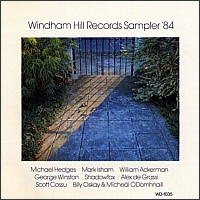 Will Ackerman: I had begun recording in 1975 with my debut guitar album. I had managed to put together a network of 6 independent distributors and was getting a surprising amount of radio airplay out of that recording when those distributors started asking “what’s going to be next of your label.” I didn’t even know I had a label (the Windham Hill name only came into being in 1976 with the awareness that I could release more records into this pipeline) and was stunned to learn that they would distribute anything I brought out. That’s now naive I was.
Will Ackerman: I had begun recording in 1975 with my debut guitar album. I had managed to put together a network of 6 independent distributors and was getting a surprising amount of radio airplay out of that recording when those distributors started asking “what’s going to be next of your label.” I didn’t even know I had a label (the Windham Hill name only came into being in 1976 with the awareness that I could release more records into this pipeline) and was stunned to learn that they would distribute anything I brought out. That’s now naive I was.
Windham Hill became huge. We were doing 30 – 40 million dollars in business annually by 1992 when I sold Windham to BMG in May of that year. I then had a three year non-complete clause and delved into spoken word recordings with a company named Gang of Seven. I absolutely loved that label, but I didn’t have the same success with it that I’d enjoyed with Windham Hill Records.
Virtually on the day that my non-compete with BMG ended in May of 1995 I created Imaginary Road Records with PolyGram, signing a contract with Chris Roberts who had been a friend for many years. Chris Roberts remembers me driving up to the record store he managed in Portland, Oregon (Everybody’s Records) in my Volkswagen bus asking if he’d take 5 copies of my first recording on consignment. Dawn Atkinson, who had been the second most prolific producer for Windham Hill Records was my partner in this.
West River Records is actually a brand new name, created for the release of The Gathering. Imaginary Road Records would have been the ideal name, but because that name is owned by Universal Records via the sale of PolyGram to Universal (and there are still titles in print on that label) we needed to look into another name. My Imaginary Road Studios looks over the West River Valley in Windham County, Vermont and I liked that sound of that.
John: In addition to your role as producer, you are a twice nominated, GRAMMY® Award-winning guitarist. What were some of the turning points in your career, and how did these events affect your career as a producer going forward?
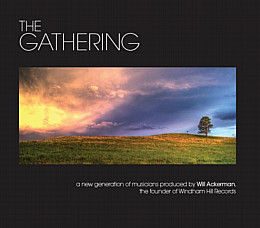 Will Ackerman: The whole thing was a Tiger by the Tail kind of experience. Windham Hill Records grew routinely at 600% a year, sometimes going into even greater growth. There were so many milestones, whether laying Carnegie Hall, playing Red Rocks and the Hollywood Bowl. Touring Europe and playing at the Montreux Jazz Festival. Touring Japan and playing at the Imperial Palace. Our first Gold Record, our first Platinum Record. The list is long and is more a feeling to me than a set of tangible events. It was impossible to hold on to anything, as you reached for it, it was gone because we were moving forward so quickly.
Will Ackerman: The whole thing was a Tiger by the Tail kind of experience. Windham Hill Records grew routinely at 600% a year, sometimes going into even greater growth. There were so many milestones, whether laying Carnegie Hall, playing Red Rocks and the Hollywood Bowl. Touring Europe and playing at the Montreux Jazz Festival. Touring Japan and playing at the Imperial Palace. Our first Gold Record, our first Platinum Record. The list is long and is more a feeling to me than a set of tangible events. It was impossible to hold on to anything, as you reached for it, it was gone because we were moving forward so quickly.
John: In Search Of The Turtles Navel is credited as one of the earliest, founding recordings in the new age genre. What characteristic qualities do you feel define the compositions we recognize today as new age music?
Will Ackerman: I’ve never been a proponent of the term “New Age” to be honest. Going into the reasons for that would be didactic at best. I’d rather talk about what I know, which is Windham Hill. Windham Hill, at least initially, was about acoustic instrumentation. It was about melody and heart.
I’ve learned to take pride in the fact that the music can be listened to enjoyably while washing lettuce in the afternoon (as a woman from Idaho once described to me in a letter) or being the music someone who is soon to leave this earth chooses to listen to in their last hours. Both are honors paid to the musician who provides that pleasure or solace. To me, that is reason enough for being as a person and for Windham Hill Records to have represented a genre unto itself.
John: I read that none of your guitar recordings use standard guitar tuning, which permits an unconventional acoustic sound. Are there any advantages to playing guitar using non-standardized tuning?
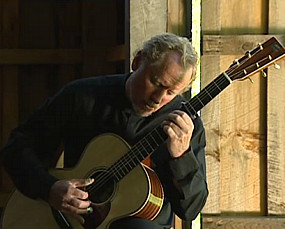 Will Ackerman: I don’t know that there are any particular advantages. Most people would probably say that it’s more bother than it’s worth. I happen to like the sound of open tunings and, after years of contemplating the reasons for my utterly obsessive adherence to constantly changing tunings I’ve finally come to an understanding of my process. I’m playing a trick on myself. By creating a new tuning I am removing intellect completely from the process of “composing.” I simply don’t know the landscape I’m in and so have nothing but emotion to guide me.
Will Ackerman: I don’t know that there are any particular advantages. Most people would probably say that it’s more bother than it’s worth. I happen to like the sound of open tunings and, after years of contemplating the reasons for my utterly obsessive adherence to constantly changing tunings I’ve finally come to an understanding of my process. I’m playing a trick on myself. By creating a new tuning I am removing intellect completely from the process of “composing.” I simply don’t know the landscape I’m in and so have nothing but emotion to guide me.
I’m lost, but in a beautiful, emotionally connected way. I inevitably find a bit of an alpha state and wander about in that landscape until I find various paths which I employ intellect to connect later. So the music is about emotion, not thought. It’s about heart, not mind.
John: New age music is like any music genre by progressing over the years. What do feel makes a good new age or instrumental recording?
Will Ackerman: I listen to all sorts of music. I honestly can’t remember who said it, but I’ve always loved the quote “There are only two kinds of music; good music and bad music.” Obviously I’m not going to pretend to be the arbiter of those definitions tangibly, but I know what I like. I know what I’m looking for as a producer and in these two elements I think this is as close to a Holy Grail as I can offer.
Firstly, does the artist have a musical “voice?” In other words, does this artist sound like everybody else or is there something unique, however hard to pinpoint, in their music. I can hear 2 guitar notes from BB King or Mark Knopfler to know who it is and I can hear two chords from Erik Satie to know who it is.
Secondly, is heart or ego driving the music? This is obviously a judgment call as well, but it’s as clear as can be to me. Maybe another way of asking the question is “am I hearing the truth,” or “do I believe this person?” I have to believe who I’m listening to and investing my heart in, both as a listener and as a producer.
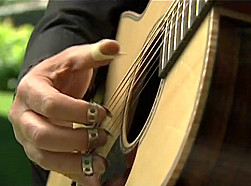 John: Your new West River Records compilation album The Gathering features a lot of great instrumental artists exactly like your highly successful Windham Hill Samplers, which achieved gold or platinum recording status. Do you feel the artist’s songs on The Gathering have the potential for equal prominence?
John: Your new West River Records compilation album The Gathering features a lot of great instrumental artists exactly like your highly successful Windham Hill Samplers, which achieved gold or platinum recording status. Do you feel the artist’s songs on The Gathering have the potential for equal prominence?
Will Ackerman: The record industry is a very different thing today. Even at the major record labels, they refer to 100,000 CDs sold as “the new million.” In other words, the potential of the marketplace even with legal downloads, is probably 10% of what it was. A gold record used to be 500,000 records sold and platinum were 1,000,000. There were a lot of gold and platinum records being handed out in those days, but if we had to wait for achievement of those kinds of numbers today, there would be only a handful of them.
The good news is that the internet can spread the word about good music brilliantly to every corner of this planet. Part of my ambition with The Gathering is to create strength in numbers to some degree. Rather than sit back and let each of these artists fend entirely for themselves, I’ve chosen to move more into the public realm again and, as with the Windham Hill Samplers, say “this is great music… these are great players… these are artists your life will be richer for taking the time to get acquainted with.” I’m doing this interview and others and will not balk at any opportunity to express my faith in these players and in this recording. I genuinely believe we can achieve a much greater visibility together and that we’ve literally just begun.
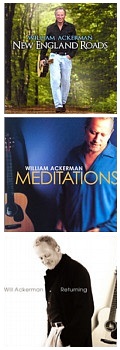 One last point is, I think, important to mention here. The known Windham Hill Records audience is easily identified and we certainly want to let those millions of people know about The Gathering. But what is also heartening to me is the number of emails from kids under 20 I’m getting now. These are kids who are digging through their parents LPs and finding music that they love. I’m guessing that maybe 10 -15% of my emails are from kids in this age range and it’s clearly a growing number and percentage. How great it would be to find a young audience who loves this sort of music, much as my generation found the forgotten American blues players in the late 60’s and 70’s (certainly with the help of the British Invasion). I’ve been contemplating a Gathering sort of recording for some time and now that it’s here I know it’s the right choice.
One last point is, I think, important to mention here. The known Windham Hill Records audience is easily identified and we certainly want to let those millions of people know about The Gathering. But what is also heartening to me is the number of emails from kids under 20 I’m getting now. These are kids who are digging through their parents LPs and finding music that they love. I’m guessing that maybe 10 -15% of my emails are from kids in this age range and it’s clearly a growing number and percentage. How great it would be to find a young audience who loves this sort of music, much as my generation found the forgotten American blues players in the late 60’s and 70’s (certainly with the help of the British Invasion). I’ve been contemplating a Gathering sort of recording for some time and now that it’s here I know it’s the right choice.
John: When selecting an artist’s song for a compilation album like The Gathering, what key elements do you look for in terms of the music qualities?
Will Ackerman: Understand that all the people on The Gathering are people I’ve chosen to produce. These are all people I have the highest regard for as musicians and as human beings. Without being at all lazy, I’ll refer you to my answers a bit earlier on in this dialogue. I need to feel these musicians have a voice that is uniquely theirs and I have to believe that they’re telling me the truth musically.
John: In regards to your production services, you have enlisted engineer and co-producer Tom Eaton. Plus, many of the session musicians in your productions are themselves, award-winning artists who have their own careers. What do you look for when selecting a session artist for a client’s recording?
Will Ackerman: I think you’re asking me how someone ends up being a session player for my productions? The answer is to be the best on the planet and be consistently so and be a genuinely kind, patient, generous human being. Whether we’re working with bassist Tony Levin who’s recorded with John Lennon, Paul Simon, Peter Gabriel, James Taylor and a million others or Steve Holley who’s the drummer for Paul McCartney and Elton John, the people who add to our work here are consummate professionals who are able to pour their hearts into the music and do so in a remarkably ego-less, kind, considerate and caring way.
The criteria for who works here go way past simple talent. Imaginary Road is my home and I’m only letting wonderful people into my home. I don’t care how talented you are; if you’re not able to wear your heart on your sleeve don’t bother to turn up. We use Keith Carlock (Sting and Steeley Dan) as a drummer too along with Arron Sterling (John Mayer and Sheryl Crow). Only last year I met Premik Russel Tubbs who plays sax and wind synths for us.
Premik has become part of the family and has played with Santana, Herbie Hancock, Sting and Billy Joel just to name a few. Violinist Charlie Bisharat and I met when he was playing with Shadowfax on Windham Hill. He and I remain great friends and we work on sessions together often. Charlie Bisharat’s played with Beck, Mary J. Blige, Black-Eyed Peas, Fiona Apple, Michael Jackson, Justin Timberlake and the list goes on.
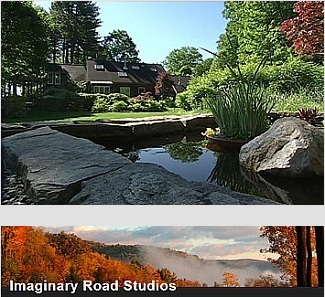 We have a stable of players who are simply too great not to use often: Four time GRAMMY® winning cellist Eugene Friesen just happens to be a neighbor here in Brattleboro and has been a close friend for twenty years now. English horn player Jill Haley drives up from Reading, PA to play for us. Pat Metheny’s percussionist Jeff Haynes has been a dear friend for decades now and lives just over the Green Mountains from here.
We have a stable of players who are simply too great not to use often: Four time GRAMMY® winning cellist Eugene Friesen just happens to be a neighbor here in Brattleboro and has been a close friend for twenty years now. English horn player Jill Haley drives up from Reading, PA to play for us. Pat Metheny’s percussionist Jeff Haynes has been a dear friend for decades now and lives just over the Green Mountains from here.
Trumpet and Flugelhorn player Jeff Oster has a place in Vermont and we get him in here for sessions as often as possible; singer Noah Wilding was crazy enough to marry me so she’s pretty much local too. Jeff Pevar, who records and tours with everyone from Ray Charles to Crosby, Stills and Nash, does guitar work for us too. We’ve just added the incredible talents of Gus Sebring, French horn player for the Boston Symphony to our list of friends. The talent pool we draw upon is considerably larger than this, but you get the point.
John: Let’s say for example I am an artist scheduled to have my music produced by you at Imaginary Road Studios. What can an artist expect when they arrive, and is there a set schedule or itinerary for the duration of an artist’s visit?
Will Ackerman: There is absolutely nothing that is formulaic here. Projects have taken days or months. No two projects are the same. There is a tremendous amount of dialogue that takes place between me and the artist before sessions begin and out of that a plan very specifically designed for the project emerges.
This isn’t a matter of someone simply turning up and starting the recording process. By the time we begin we’ve probably selected 80- 90% of the material, have worked out the arrangements and have some ideas as to what the additional instrumentation will be. That said, we’re never completely right. Some of the music will inevitably change and evolve. You have to really listen to what you’ve recorded and hear what’s it’s telling you.
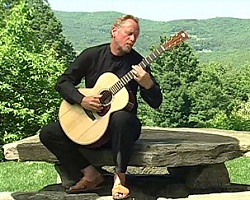 Part of producing is knowing when your preconceptions are no longer valid, but that the music has evolved into something new. It’s part of my job to realize when we have to abandon preconception and allow the music to instruct us. Some of the best music comes about by being open to change and allowing spontaneity to be in charge when it’s productive.
Part of producing is knowing when your preconceptions are no longer valid, but that the music has evolved into something new. It’s part of my job to realize when we have to abandon preconception and allow the music to instruct us. Some of the best music comes about by being open to change and allowing spontaneity to be in charge when it’s productive.
John: When you are in a recording session, do you find yourself constantly motivating an artist in the desired direction, or do you and the artist connect automatically?
Will Ackerman: Once again, John, every person and every session is different. Thankfully, that is the case as the newness keeps me on my toes and aware.
John: How do you make an emotional connection with an artist Will?
Will Ackerman: I’m a musician so I know what it takes to make music that is connected to emotion. How people get there varies greatly. What doesn’t change is the trust that has to be established. If people are going to allow vulnerability into their hearts and music they have to trust me and it’s my responsibility to make that possible for them.
John: Do artists ever have any common misunderstandings about your occupational or leadership role as producer?
Will Ackerman: There is nothing dictatorial in the role. I do have strong opinions and I’m not reticent to express those opinions, but at the end of the day, I’m working for the musicians and their needs and wishes are the ultimate arbiter of where we’re headed.
John: Have there been artists you simply can’t work with?
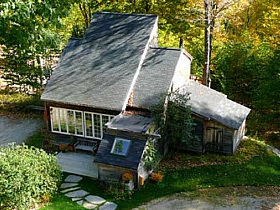 Will Ackerman: Yes, but thankfully that was long ago and my instincts about people and my understanding of myself (including a realistic evaluation of my own strengths and weaknesses) have made for a decade of very happy encounters. It’s hard work and very stressful, so we try not to record for more than a couple of days in a row.
Will Ackerman: Yes, but thankfully that was long ago and my instincts about people and my understanding of myself (including a realistic evaluation of my own strengths and weaknesses) have made for a decade of very happy encounters. It’s hard work and very stressful, so we try not to record for more than a couple of days in a row.
Learning how to keep spirits up even when everyone is very tired and spent is an important part of the process, but simply knowing that everyone needs rest to be productive and happy is a surprisingly important piece of the puzzle. This is where being a bit older actually helps. One comes to understand their own limitations better which is actually more freeing than limiting.
John: You have produced music for esteemed artists like George Winston, Michael Hedges, Liz Story, Alex de Grassi, and many more top-ranked artists in the music industry.
This may be a hard question to answer Will, but do you believe some of your more recent artists, including debuting artists, have the potential to reach the same success? And if so, do you have any advice or a strategy you would offer to artists wanting to improve their performance skills or advance in their music career?
Will Ackerman: I think it’s a matter of scale to some degree. CD sales are way down and legal downloads don’t begin to compensate for the real losses in pirated music. At the same time we’ve gotten to the point where there is very little a major label knows about the current music business that the average internet-savvy teenager doesn’t know.
In fact the average teenager may be far hipper and more contemporary and imaginative than the guys who are still at desks at the big companies. One line I’ve used in talking with people is why give away 90% of the profits to an organization that doesn’t understand the marketplace any better than the average teenager?
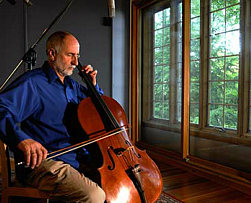 I don’t think this is an exaggerated perspective at all and I think the question is valid. We see established acts reaching the time of contract expiration with major labels and just leaving the majors and creating their own labels with web presence and touring being focal points of their endeavors.
I don’t think this is an exaggerated perspective at all and I think the question is valid. We see established acts reaching the time of contract expiration with major labels and just leaving the majors and creating their own labels with web presence and touring being focal points of their endeavors.
Artists recording on their own labels are keeping 100% of the profit rather than getting maybe a 12% royalty from a major label. Keeping an eye on budget becomes more important than ever (as there are fewer sales and less gross income) and the objective now seems to be about creating a constant internet presence rather than making one huge marketing effort in order to recoup the investment in recording or video etc.
Radio exposure is still important, especially with all of the internet music outlets. Getting reviewed, as always, matters in a big way and given all the websites devoted to niche markets there is more opportunity for attention than ever. Ultimately, however, it’s all about harnessing the internet and touring to cement a relationship with an audience and hone one’s craft.
I recently met a young woman name Kina Grannis who created this incredible video for YouTube. It took 3 months to make the first 10 seconds of this and nearly 2 years to finish. It’s a stop motion video shot against a constantly changing backdrop of paintings done with jellybeans. You heard me right, jellybeans. The video is brilliant, as is Kina, and I believe she’s now had something like ten million hits on this YouTube single. Jelly Belly heard about this and are now underwriting her touring and she just finished a tour of major markets in Europe, then traveled to the far east and Australia as well as the U.S. All of this fueled by a very clever video that her friends help her create.
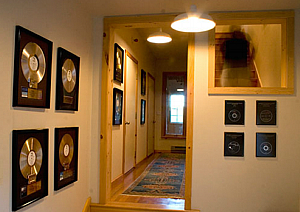 In looking at the New Age market, I see people still doing a video of a babbling brook and posting it as if there is anything compelling in this. It was novel in 1984 when I did the world’s first digital audio laser discs with Pioneer Home Video and Paramount, but that’s been done and done and done. Be clever. Take a chance. Do something different. You may fail, but it’s ordained that you’ll fail by being one of a million people doing the same thing.
In looking at the New Age market, I see people still doing a video of a babbling brook and posting it as if there is anything compelling in this. It was novel in 1984 when I did the world’s first digital audio laser discs with Pioneer Home Video and Paramount, but that’s been done and done and done. Be clever. Take a chance. Do something different. You may fail, but it’s ordained that you’ll fail by being one of a million people doing the same thing.
In terms of live performance, George Winston and I would play a benefit for any 5 watt radio station in the U.S. who would give us airplay and we were willing to work from the ground up. I can remember audiences of 6 people where I gave everything I had.
I think you have to have that commitment and the talent to offer something very special to the world, but what is learned on the road is valuable on so many levels and connects you with your audience.
Getting a sense of an audience’s reaction to a new piece, getting a feel for what’s working and what’s not (both for you and for the audience), is something most effectively done in front of a live audience. They’ll tell you a lot about what will be effective in the marketplace. So in answer to your question; yes artists in any genre can still break out onto the world stage, but to really succeed these days you almost certainly have to have brilliant and original (not necessarily expensive) videos and I continue to believe that live performances are an invaluable training ground.
John: Technology has undoubtedly changed since the time when you first began to produce. What are some examples of how new technology changed the way you produce music in the studio today?
Will Ackerman: Fundamentally, the only deep change is digital and I do a great deal to refrain from a complete embrace of what is contemporary. I’m convinced that digital is not all for the best, though the manipulation of digital information in editing, for instance, is just simply brilliant and is an important part of our process here. My principal microphones are VERY expensive matched pairs of Neumanns. What we do with microphone positioning and configurations are literally unique and very much on the cutting edge.
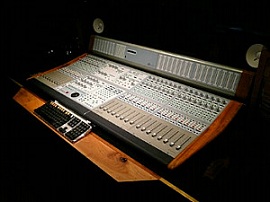 Despite the fact that we’re understandably regarded for our audiophile recordings, our methods are bordering on heretic. I like that. The Hemmingway preamps are rare and a brilliant part of our arsenal. I sometimes use analogue process even in the highest quality digital recordings if I feel there is something to be gained. My own Returning album, which won the GRAMMY® in 2005, was run through Studer heads as part of mastering, for instance.
Despite the fact that we’re understandably regarded for our audiophile recordings, our methods are bordering on heretic. I like that. The Hemmingway preamps are rare and a brilliant part of our arsenal. I sometimes use analogue process even in the highest quality digital recordings if I feel there is something to be gained. My own Returning album, which won the GRAMMY® in 2005, was run through Studer heads as part of mastering, for instance.
And there’s Tom Eaton. Tom’s been with me for over a year now and is simply the most talented engineer I’ve known in my entire life. A pianist himself (he actually plays a range of instruments) Tom brings an academic knowledge of music to the room that my intuitive side is grateful for. I was recently having trouble explaining to Tony Levin what I wanted in a piece and Tom took a minute to talk with me and then hit the talk back and said to Tony, “Tony, Will’s hearing it on the one.” It would have taken another 10 minutes for me to finally explain what I was hearing.
I’ve come to respect Tom’s opinion as much as anyone I have ever known. Increasingly he and I are co-producing and the recordings are the better for it. Tom knows the Windham Hill Records catalog better than I do and this history also informs his understanding of where we’re going and why. He respects my position in the producer’s chair, but he always has my ear and no one in my history has been able to command more attention with a gentle, “I was just wondering if.” The man’s simply brilliant and has brought more to my production environment than anyone in my history. He’s also a wonderful, bright, funny human being who has become family in a very short while.
John: You have a one of a kind Steinway piano, and other high-tech equipment at your studio. Is having the highest quality equipment available for artists to use during their visit, one of the most essential components for your productions?
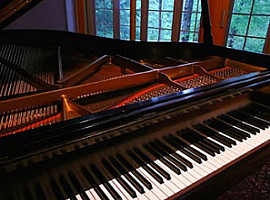 Will Ackerman: Our Steinway is simply magical. I have never recorded anything that compares to it in my entire career. It came here by chance a decade ago as a rental and it simply never left. I just told the owner that he’d have to come up with a price. I called him and told him this and took the rest of the day off and nailed the load-in doors shut and resided the building. He had to sell it to me. When you think of how important the piano has been to my career and how much piano recording I’ve done and you realize that I’m begin utterly honest when I tell you that this is the finest sounding recording piano I’ve ever worked with, that’s a pretty dramatic statement.
Will Ackerman: Our Steinway is simply magical. I have never recorded anything that compares to it in my entire career. It came here by chance a decade ago as a rental and it simply never left. I just told the owner that he’d have to come up with a price. I called him and told him this and took the rest of the day off and nailed the load-in doors shut and resided the building. He had to sell it to me. When you think of how important the piano has been to my career and how much piano recording I’ve done and you realize that I’m begin utterly honest when I tell you that this is the finest sounding recording piano I’ve ever worked with, that’s a pretty dramatic statement.
There are many quality products that I don’t need. We actually don’t have a lot of toys here. It’s very fundamental stuff. I have some very purist ideas about how to record instruments and it begins with the fact that I want to be inside the instrument. I want to be more proximate to the instrument than almost any producer on the planet.
I want to hear guitar recorded so that it sounds as it does to me when I’m holding it. I want the piano to move from left to right, bass to the high notes and feel like you’re sitting at the piano. I don’t want to soften edges a lot. I don’t want the recordings to be dreamy even if the music itself is. I want the listen to be deeply aware that this is a piece of wood and steel they’re listening to. I think this is partly why I just shy away from keyboards (however good their sampling has become) so much. I love the world of acoustic music. It’s what drives me, and I’m always searching for ways to get even closer and more detailed in my listening and recording. I’ve recently made a discovery about cello, for instance, that pleases me a great deal.
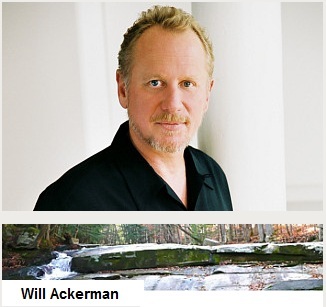 John: Thank you again for giving me and everyone a moment of your time Will. I have a deep respect for your work, and I hope we have a chance to interview again in the future. I am sure there will be fans and artists worldwide reading the newest Will Ackerman interview in 2012. Is there anything you would like to express to the artists and fans that have supported you over the years?
John: Thank you again for giving me and everyone a moment of your time Will. I have a deep respect for your work, and I hope we have a chance to interview again in the future. I am sure there will be fans and artists worldwide reading the newest Will Ackerman interview in 2012. Is there anything you would like to express to the artists and fans that have supported you over the years?
Will Ackerman: First of all, I’d like to say thank you to everyone who agreed to be on The Gathering. My deepest thanks to these wonderfully talented and lovely human beings;
Masako, Paul Jensen, Stanton Lanier, Kathryn Kaye, Rudy Perrone, Fiona Joy Hawkins, Jeff Oster, Dean Boland, Frank Smith, Todd Boston, Rocky Fretz, Shambhu, Kori Linae Carothers, Peter Jennison, Denise Young, Devin Rice and Erin Aas, Lawrence Blatt, Ronnda Cadle, Ann Sweeten, Ken Verheecke and Patrick Gorman.
My thanks too to all the musicians I’ve been blessed to work with. There are musicians I’m producing now and musicians I’ve just finished producing that we didn’t have room for on The Gathering. I hope our success with this project is such that we’ll have a chance to release a second volume.
I hope your readers will support The Gathering. We purposefully decided to make this affordable. At $12 and 74 minutes it’s a bargain and getting turned on to 22 new musicians is a pretty great experience in life. We hope you’ll think of The Gathering as gifts and just a thank you to those in your lives. We’ll be deeply grateful for your help. Will Ackerman.
Visit WilliamAckerman.com and the Imaginary Road Studios. You can sample or purchase The Gathering at CDBaby.com. The majority of artists Will mentioned on The Gathering compilation release have album reviews at this site. Visit my pages dedicated to Will Ackerman and artist tags located in a right hand module. Photos are courtesy williamackerman.com.

Kitaro is a GRAMMY® and Golden Globe Award-Winning musician in the forefront of today’s international music scene. One notable fact about his artistry is its universal appeal, bringing forth a message of peace, respect and unifying cultural connection of Eastern music with Western music.
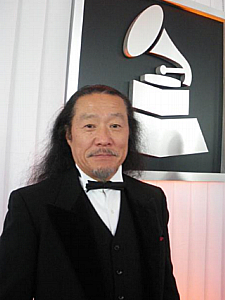 Kitaro is a music icon recognized worldwide as a primary founder of the New Age Music Genre, but then again, the principal influence heard in his instrumental classics are uniquely his own, and in a classification by themselves. This is a point of admiration about Kitaro’s music that simply cannot be overstated.
Kitaro is a music icon recognized worldwide as a primary founder of the New Age Music Genre, but then again, the principal influence heard in his instrumental classics are uniquely his own, and in a classification by themselves. This is a point of admiration about Kitaro’s music that simply cannot be overstated.
Over the course of his distinguished music career which spans over three decades, Kitaro has produced an extensive collection of beloved instrumental classics to millions of people from every nation.
Kitaro began his innovative music career with the release of his debut solo album entitled Astral Voyage in 1978. From this time forward, Kitaro has been a leader in the music industry. The recipient of a GRAMMY® Award, 14 nominations and a Golden Globe award, Kitaro is an artist accustomed to winning prestigious awards and acclamations for his quality work year after year.
You will discover Kitaro’s music compositions are masterful in style and theme. The Silk Road series, Sacred Journey Of Ku-Kai series, Thinking Of You album, and Impressions of the West Lake are some of his most prized work.
New Age Music World host John P. Olsen had an opportunity to interview Kitaro in the early part of March 2012, prior to Kitaro’s performance at a special multimedia, live concert event in Uruguay called FAROSUR. Today we are pleased to present their conversation to Kitaro’s international fan base and to all site visitors.
Kitaro Interview in 2012;
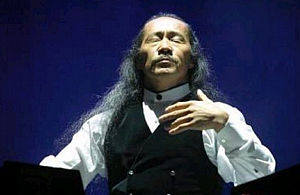 John P. Olsen: Hello Kitaro, thank you so much for accepting my interview invitation. It is a privilege to host your newest interview in 2012, here at New Age Music World. I was already very familiar with you, and the music you produce, plus I enjoyed reading even more about you while preparing for our interview together. You are indeed one of the most fascinating artists I have ever interviewed Kitaro.
John P. Olsen: Hello Kitaro, thank you so much for accepting my interview invitation. It is a privilege to host your newest interview in 2012, here at New Age Music World. I was already very familiar with you, and the music you produce, plus I enjoyed reading even more about you while preparing for our interview together. You are indeed one of the most fascinating artists I have ever interviewed Kitaro.
Kitaro: Hello this is Kitaro, Thank you for inviting me to this interview.
John: Let me begin by saying, you are an artist who has acquired worldwide, international fame. You were born in Japan, but have lived in America for many years too. Your music regularly has a fusion of ancient or ethnic instruments with modern electronic synthesizers. What first gave you the idea for integrating instruments with near opposite sound qualities?
 Kitaro: I started my music career in high school, that’s era (end of 60’s and beginning of 70’s). I listened to so much music from other countries, mostly from USA and Europe. I was very surprised by impressionable sounds. I felt like I opened the door of the new world. It was a synthesizer.
Kitaro: I started my music career in high school, that’s era (end of 60’s and beginning of 70’s). I listened to so much music from other countries, mostly from USA and Europe. I was very surprised by impressionable sounds. I felt like I opened the door of the new world. It was a synthesizer.
John: In regards to ethnic instruments and electronic synthesizers, do you find it a challenge to unite the two classifications of instruments in your arrangements?
Kitaro: For me, it was not difficult to combine these elements. It’s a very enjoyable moment.
John: Has living in countries around the world with varying cultures been the greatest influence with your music, and if so, how much of a role does social culture influence your music?
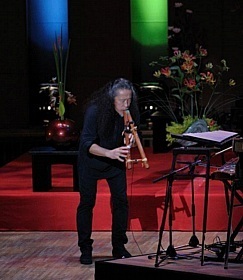 Kitaro: I still have a home on mountainside in Japan. It’s a 250 years old home. I learned many things; living culture, nature, life – how important these element are for our lives. Also I believe that my music is one of the elements of nature.
Kitaro: I still have a home on mountainside in Japan. It’s a 250 years old home. I learned many things; living culture, nature, life – how important these element are for our lives. Also I believe that my music is one of the elements of nature.
John: You were honored with a Japan America Society Art Without Borders award in 2002. Can you tell us about the organization and the reason they presented their premier award to you?
Kitaro: I believe most of the members of this organization want to make a better relationship between Japan and USA through our work.
John: Your Love and Peace Planet Music Tours have made your music accessible to concert audiences worldwide. Your music has universal appeal. It is what sets you apart from other artists, and makes you special. How do you make the connection of unity with your concert audiences?
Kitaro: I believe music has a power to influence audience’s mind and soul. So, we are trying to make peaceful mind within our sounds.
John: Since people of various countries often have their individual tastes in music, have you ever performed concerts to fit the tastes of Eastern or Western audiences, or do you always strive for universal sound qualities?
Kitaro: Sometimes when we visit another country and perform, we try to re-arrange the song to fit the audience and perform some of the songs which people know as a popular song. It’s very fun for us too.
John: You are proficient on a number of traditional instruments like guitar, keyboards, and percussion. What indigenous instruments do you play, and what do you feel are the natural melodic qualities of each one?
Kitaro: I have traveled many countries and collected many traditional musical instruments. And I’m still trying to play and make beautiful sounds of these instruments. Since each instrument has a deep culture influence of each country, it is a timeless process for me.
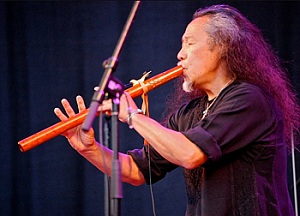 John: Of the many orchestral and ethnic instruments you play, which instrument(s) do you feel best speaks from the heart, or are your collection of instruments simply a tool for your own inner expression?
John: Of the many orchestral and ethnic instruments you play, which instrument(s) do you feel best speaks from the heart, or are your collection of instruments simply a tool for your own inner expression?
Kitaro: I’m trying to have an experience of different cultures to see the behind of the sounds and instruments.
John: Percussion instruments likewise have a special place in your heart too. I read each year you make a customary pilgrimage to Mount Fuji to perform a formal drum ceremony. Would you like to tell us about the Wadaikos tradition?
Kitaro: Rhythm and beat is our PULSE and our BLOOD. I have never learned drumming but we can play some, because drumming is a simple thing but deep – following our heart beat.
About Taiko-drum ceremony at Mt. Fuji in Japan: It has been already 24 years since we started. This ceremony is not complicated explanatory thing. It’s very simple.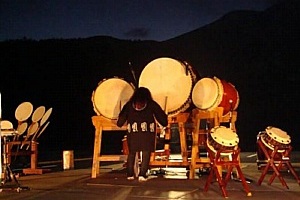
This is an appreciation for this Mother Earth and to create ties to it through drumming.
We invite many people from the young to the old. Any ages can come to Mount Fuji. Then we play drum together on the full moon night in September every year. Same as many spiritual Native tribes doing, we try to connect to spiritual moments through the drumming.
John: Your instrumental music is an unlimited collection, or in a universal category of its own style. Although your music can’t be defined by one music style or genre, your earliest albums began the structural foundation for the New Age Music Genre.
When you first began producing music decades ago, did you envision the instrumental music you were producing at the time was to be a major influence, past, present, and future with the new age genre?
Kitaro: I have never thought of becoming ”New Age Music” like an individual Genre. But I believe this kind of sounds and music is what we need. I’ll keep going on my music.
John: You have a long and enduring relationship with Tangerine Dream founder Klaus Schultz. What is your association with Klaus Schultz, and how did your friendship begin?
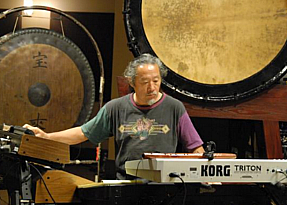 Kitaro: In my First recording at England during the 70’s, we tried to propose him if he could produce for our Band, because we like Tangerine Dream sounds. Our Band (Far East Family Band) focused on progressive and electric music since we started the band.
Kitaro: In my First recording at England during the 70’s, we tried to propose him if he could produce for our Band, because we like Tangerine Dream sounds. Our Band (Far East Family Band) focused on progressive and electric music since we started the band.
John: I read you and the late Takeshi Kato, who was the Chairman of the Korg Corporation also had an enduring relationship over the years too. Would you tell us about your friendship with Takeshi Kato and the influence he has made with your music?
Kitaro: Mr. Kato supported many musicians, not only Japanese musicians but musicians from all over the world for more than 40 years. In early days of company “KORG,” he and I always worked with engineer discussing and explaining what kind of sounds we like to have, then engineer tried to create machine. In those days, we have still used analogue technology (I still like this technology).
He passed away last year – He was like my FATHER.
John: I am truly sorry to hear of your personal loss. I didn’t realize you were so close. Takeshi Kato will be missed by many people worldwide. You have collaborated with many equally great rock music artists like Grateful Dead drummer Mickey Hart, on The Light Of The Spirit, and progressive rock YES vocalist Jon Anderson, on Transcendent Dream, both of which were highly successful albums. Your soundtrack and modern day opera Impressions of the West Lake was likewise a partnership with international filmmaker Zhang Yimou. Would you please tell us about your projects with Zhang Yimou?
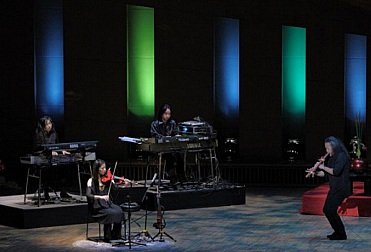 Kitaro: Mr. Zhang Yimou offered me to make original music for “Impression of the West Lake” in 2007. First, it was their idea – Then I had a trip to China to have meeting with production people. And they showed me my recent DVD ”TAMAYURA,” which is a collaboration with Butoh Dance company performed at traditional Japanese Garden.
Kitaro: Mr. Zhang Yimou offered me to make original music for “Impression of the West Lake” in 2007. First, it was their idea – Then I had a trip to China to have meeting with production people. And they showed me my recent DVD ”TAMAYURA,” which is a collaboration with Butoh Dance company performed at traditional Japanese Garden.
Mr. Zhang Yimou told me that they wanted to make the stage like this – I was so surprised, and the production was not easy. Because work continued with construction and composing music at same time, depending on stage direction handled by Mr. Zhang Yimou. We always waited for his comments. During the project, I enjoyed working with him so much for his dynamic direction and mind.
John: You were honored by a Composer Award at the 51st Golden Globe Awards for your wonderful Soundtrack for Heaven & Earth, a movie directed by Oliver Stone. Would you like to tell us about your soundtrack compositional work with film director Oliver Stone?
Kitaro: This Film was a third film of Vietnam War by Mr. Oliver Stone, as for my understanding. I learned many things; film score, filming, production and etc. I had a trip to Vietnam with him (Mr. Stone), his crew, actors and actresses. Since the film director decided everything; sounds, editing and all the details, even when my composition has done, he needed to confirm if music is right for the scene. And it took four years. His work had a lot of intention. That is good mood for me.
John: The Sacred Journey of Ku-Kai series was conceived during the days after the tragedy of September 11, 2001 (9/11). What was the setting, and the reasons for you to produce the Sacred Journey of Ku-Kai series?
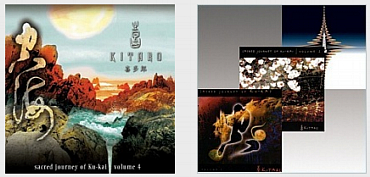 Kitaro: I focused on thinking about what is ”world peace,“ then I came up with this project. It has not finished yet. It’s still on the way to become “World Peace.” I believe Human will make “World Peace” someday.
Kitaro: I focused on thinking about what is ”world peace,“ then I came up with this project. It has not finished yet. It’s still on the way to become “World Peace.” I believe Human will make “World Peace” someday.
John: The Silk Road Series is said to be one of your many arrangements considered a musical masterpiece. What were the circumstances surrounding the production of your highly acclaimed Silk Road Series?
Kitaro: I had been influenced by the theme of Silk Road which is an ancient road between Asia and Europe.
My imagination has grown so much with this theme at the time NHK offered to me to make music for Silk Road. Also I had a trip to China and Soviet Union (old day) after finishing composition. It was a fun trip. All of the places I visited were peaceful. But they changed too much today.
John: You composed the soundtrack for a Japanese television documentary series that ran for five years titled Silk Road. How does the soundtrack music differ from the Silk Road series album collection?
Kitaro: I had a travel to Silk Road by “SOUND.”
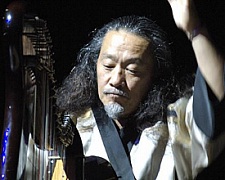 John: Your music has earned you a GRAMMY® Award and 14 Nominations over the years. These are significant awards and nominations. Are album awards and acclamations of your musical works important to you at all, or do you consider them simply a testimonial of your many achievements?
John: Your music has earned you a GRAMMY® Award and 14 Nominations over the years. These are significant awards and nominations. Are album awards and acclamations of your musical works important to you at all, or do you consider them simply a testimonial of your many achievements?
Kitaro: Awards are not my goal.
John: Over the years while attending the GRAMMY® Awards, you have had many opportunities to form friendships with other artists who were under award consideration like yourself. Could you tell us about your experiences while attending the awards ceremony?
Kitaro: When I got 43rd Grammy Awards, my friend David Foster was on stage and he called my name. David said “congratulation” and I could release my tension and relax and talk.
John: I am certain there will be a number of debuting and professional artists who will read our interview. Many artists maybe look to you like a mentor, and hope to achieve the level of success you have reached in your career. Do you have any words of advice you can offer, or a strategy an artists should bear in mind during the course of their music careers?
Kitaro: Each artist has a different theme. So it’s not easy to say something. Maybe only I can say is, “You can compose and create Music for another person, simply just as a gift for another all living thing and for this planet. That would be GREAT. Trust your feeling.”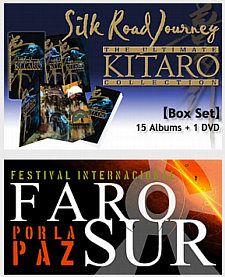
John: On March 27, and March 28, 2012 you have a special live concert event in Uruguay. It is a premiere event conceived by Emil Montgomery called FAROSUR. I read this is a multimedia artistic show, and collective group effort. Who are some of the artists involved?
Kitaro: This event will be a great friendship concert between Emil. Suzanne Ciani and I will perform some of the music (new song) together. We will perform every song from our HEART.
John: What is the theme or purpose of the FAROSUR concert event?
Kitaro: My understanding is “WORLD PEACE.” It’s beyond everything.
John: Your philosophic viewpoint is a matter of record. It is one of peace, respect and unity, shared by many people. What does it “feel like” to be a respected artist, who has an opportunity to express your message of peace worldwide?
Kitaro: We hope music effect all over the world. People can feel and think about future.
John: During your international concerts around the world, you have performed live before audiences of over 50,000 people. Would you like to tell about your experience meeting people worldwide, what it means to you personally, and how it influences the music you produce?
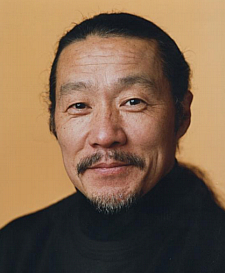 Kitaro: We always appreciate that many people come to see our performance. But our performance is not only our performance. We are performing with an audience, making collaboration.
Kitaro: We always appreciate that many people come to see our performance. But our performance is not only our performance. We are performing with an audience, making collaboration.
John: I would love to release some news for your fans about a new Kitaro album or a concert tour in the planning stages. Is there any additional Kitaro news you would like to announce today?
Kitaro: I’m working and producing a Native American person’s (Dennis Banks) song which is related with Nature, living with Nature, songs coming from life style and spiritual experience.
John: Your music is very much on the forefront of today’s music scene. Interest in your music has grown tremendously over the years, and you have a wonderful story to share. It has been a privilege to host your newest interview in 2012 Kitaro. I hope we have a chance to visit again to update everyone on the current news about you. In closing for now, is there anything you would like to express to our readers, and the fans that have supported you throughout your career?
Kitaro: I really appreciate all of listeners and audience and all of living things on this planet.
“Thank you so much.” Kitaro![]()
Visit the DomoMusicGroup.com homepage, their Kitaro page, and Domo Music Group store page for Kitaro.
Photos are courtesy kitaromusic.com and domomusicgroup.com.
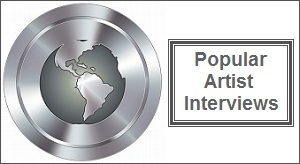 New Age Music World prides itself in offering visitors a variety of ways to find out more about their favorite artist. Music interviews are an excellent way to learn more about today’s popular artists and their music in a contemporary setting. I am pleased to announce two esteemed popular artist have accepted my interview invitation.
New Age Music World prides itself in offering visitors a variety of ways to find out more about their favorite artist. Music interviews are an excellent way to learn more about today’s popular artists and their music in a contemporary setting. I am pleased to announce two esteemed popular artist have accepted my interview invitation.
Kitaro & Yanni are two popular interview guests whose open conversations about their life and music are currently scheduled for an exclusive music interview here at NewAgeMusicWorld.com.
Kitaro & Yanni are two of today’s top instrumental artists, whose fans of all nationalities number into the millions. It’s a privilege to present an interview for their fans and my site visitors. A word of thanks to Kitaro and Yanni for giving us a moment of their time.
Read 30 music interviews with popular artists on my interview section. I am preparing for more music interviews with popular artists so check back for another announcement about future guest artists. BigStockPhoto copyright – Ihfgraphics.

AOMusic is a select group of artists whose foundation for their music is in part, a humanitarian message about children around the world who are in need of our assistance. In addition to the beautiful world fusion rhythms heard on their release – …and Love Rages On! – it’s the children and boys choirs featured on AOMusic’s album that is in itself special.
The children’s youth choirs from Africa, America, China and the People’s Republic of Georgia are underprivileged children who are often the tragic victims of war and famine, in some cases due to greed and corruption within their own governments. Many of the children featured in AOMusic’s choirs are homeless or orphans.
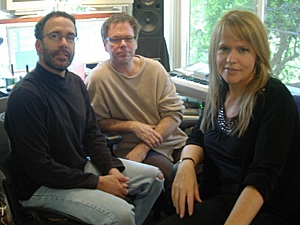 AOMusic has a message to share by their music. The principal members of AOMusic group are founder Richard Gannaway, Jay Oliver, and lead singer Miriam Stockly. The message of the principal members, in addition to their contributing artists, is sincere and a simple one. It’s about children who need our help. Through music they hope to raise awareness by reaching both our ears and our hearts.
AOMusic has a message to share by their music. The principal members of AOMusic group are founder Richard Gannaway, Jay Oliver, and lead singer Miriam Stockly. The message of the principal members, in addition to their contributing artists, is sincere and a simple one. It’s about children who need our help. Through music they hope to raise awareness by reaching both our ears and our hearts.
For some people it is much easier to let someone else do what is necessary to help combat the plight of children in need, and too many times the message falls upon deaf ears. Thankfully, there are people worldwide who do take on the task by their contributions of time and money. They are the people we would like to express our gratitude.
New Age Music World host John Olsen has interviewed founding artist Richard Gannaway and vocalist Miriam Stockly of AOMusic. It is our hope everyone can learn more about the children and AOMusic’s message through music album entitled …and Love Rages On!
Interview with AOMusic Members;
John P. Olsen: Richard and Miriam, thank you for consenting to this interview. I have learned a lot more about AOMusic, and your mission to bring awareness to the plight of the children’s choirs featured in your newest album. I am able to recognize your personal contributions on behalf of the children, and your desire to get other people involved is sincere, and it’s a privilege to participate by hosting our interview today.
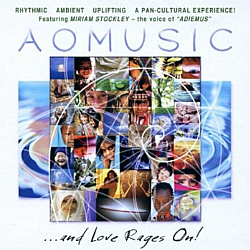 Let me begin by saying your album is a fine release. In fact, earlier I selected AOMusic’s – …and Love Rages On! – for the Best New Age Albums in 2011 Awards on January 1, 2012 here at New Age Music World. I have a lot of questions about the children featured in your release, but let me let me ask a couple questions about the album they have performed choir vocals on first.
Let me begin by saying your album is a fine release. In fact, earlier I selected AOMusic’s – …and Love Rages On! – for the Best New Age Albums in 2011 Awards on January 1, 2012 here at New Age Music World. I have a lot of questions about the children featured in your release, but let me let me ask a couple questions about the album they have performed choir vocals on first.
Your release was selected a qualifying album in Zone Music Reporter’s 2011 Album of the Year, Best World Album and the Best Vocal Album categories. With the ZMR Awards for 2011 to be announced on March 11, 2012, do you have confidence – …and Love Rages On! – will be among the albums selected in the Zone Music Reporter Awards in 2012?
Miriam Stockly: I have high hopes for – …and Love Rages On! – and certainly winning one of these prestigious awards would be a great honor for us all.
John: With the 3 Zone Music Reporter Album of the Year, Best World Album and Best Vocal Album categories, do you feel you have a better chance of winning in any particular award category – since you can pretty much tell which albums by other artists you are competing with in each award category?
Miriam Stockly: As a composer and artist, I am rooting for Album of the Year or Best World Album. As a singer, a huge part of me would be really chuffed if we managed to get Best Vocal Album. I am very biased when it comes to the quality of vocals we perform on this album.
 Richard Gannaway: It is great to see that the album has connected strongly with ZMR’s global network, and we hope the uniqueness of AOMusic’s universal palette shines through in these categories.
Richard Gannaway: It is great to see that the album has connected strongly with ZMR’s global network, and we hope the uniqueness of AOMusic’s universal palette shines through in these categories.
John: I must say your release really is special from the rest, so I hope the best for you in the ZMR Awards later in 2012. The children and boys choirs featured on – …and Love Rages On! – are youth choirs from Africa, America, China and the People’s Republic of Georgia. How did you select the children and boys choirs for your world fusion release?
Richard Gannaway: Thank You! Thus far, we haven’t needed to go searching the world for children’s ensembles. In most of the regions we travel, our hosts procure good choirs for us, and we arrange to record them on location. I also receive numerous invitations to record children in several countries.
With regard to this album: We were introduced to the CRC Children’s Choir during our first trip to Beijing in 2001. The Martve Boys Choir was introduced to me at a press conference in Tbilisi for a possible concert to benefit a local orphanage. The Johannesburg ensemble is from the grammar school Miriam attended as a child, and the other two choirs are from the towns we each reside in.
John: Could you give us some information on the international choirs, featured in – …and Love Rages On! – album?
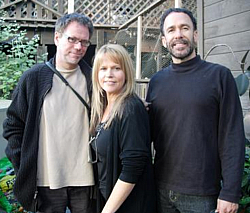 Richard Gannaway: The CRC Children’s Choir is a group of kids that are handpicked from all over the Republic of China. They are the best-trained youth choir we have ever encountered, and their ears are highly developed. They were very shy and reserved at first, though by our third trip to Beijing, they were in full form.
Richard Gannaway: The CRC Children’s Choir is a group of kids that are handpicked from all over the Republic of China. They are the best-trained youth choir we have ever encountered, and their ears are highly developed. They were very shy and reserved at first, though by our third trip to Beijing, they were in full form.
The Martve Boys Choir in Tbilisi is the preparatory version of the famous Rustavi Singers. A few of the children are recruited from orphanages, and the choir is underfunded. The vocal polyphony is a Georgian folk tradition that blends East, Middle East and Western influence – very beautiful.
The choir in Johannesburg is from a grammar school, well known for its music program, and directed by three women with prestigious classical backgrounds. Several of the children are from the countryside, and a few are adopted by the school, which sometimes takes in homeless kids.
John: What is the best part about working with, and getting to know the kids of all nationalities personally?
Richard Gannaway: There are several things wonderful about that, but primarily it is a tremendous curiosity the children exhibit towards us, because westerners do not often engage them in this way. In the places we tend to visit, their lives are full of tradition, and they are very keen on sharing customs. Naturally their joy and enthusiasm is a great experience, and when we add their tracks to a song, it never fails to surprise the three of us how they bring that final measure of authenticity and spirit we like to strive for. Aside from travel logistics, they are probably the easiest part of the production process, which anyone in the recording arts will attest, can be very meticulous work.
John: I read you have also established a non-profit foundation to benefit the children and other fundraising projects. How are your donations distributed to the organization, and where can people donate money?
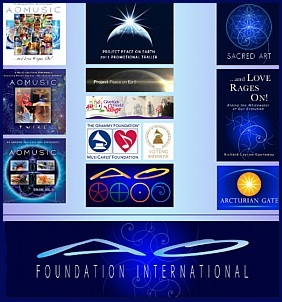 Richard Gannaway: AO Foundation International is an umbrella for well-organized, grassroots causes around the globe, and we have barely scratched the surface of what is out there. The focus is on children, community and sustainability.
Richard Gannaway: AO Foundation International is an umbrella for well-organized, grassroots causes around the globe, and we have barely scratched the surface of what is out there. The focus is on children, community and sustainability.
The AOFI non-profit model will ultimately provide a way for artists to share intellectual property with several of these charities, as well as specific causes in the regions where we record children. Presently, through HavServe, Arcturian Gate (our indie label) donates 10% of this album’s sales to construction of a sustainable village in Haiti, where children were orphaned by the 2008 earthquake. People can make a donation to the AOMUSIC 4 Haiti campaign by visiting our website – aomusic.com.
John: The children and boy’s choirs are very much an integral part of – …and Love Rages On! You also have a number of great artists who perform instrumentals. Could you tell us about the contributing artists?
Richard Gannaway: Yes, the circle of contributing artists has expanded over the years. Sandeep Chowta is a popular Bollywood film score composer, and as a contributing producer, he brings a vast resource of talent in that region. Ashwin Srinivasan plays Indian flute, which Sandeep recorded in his Mumbai studio.
Michael Cooney is a national champion piper from Tipperary who played Irish penny whistle on the album, and was recently nominated for an Irish Music Association Award. Kimba Arem from Boulder, Colorado played didgeridoo on our last two albums, and is known all over the world for her work in music and sound therapy.
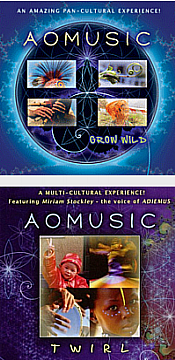 The AOMusic regulars are Andy Georges, who helps out with various stringed instruments, and has been recording with Jay Oliver and myself since the early nineties. He occasionally contributes as co-writer, and spends a lot of time doing film score work on the west coast. George Bernardo (percussion) and Doug Lunn (bass) are also regular contributors whom we have known for many years, and they just completed Doug’s first solo album, the Doug Lunn Project, which is now getting excellent reviews in the jazz world.
The AOMusic regulars are Andy Georges, who helps out with various stringed instruments, and has been recording with Jay Oliver and myself since the early nineties. He occasionally contributes as co-writer, and spends a lot of time doing film score work on the west coast. George Bernardo (percussion) and Doug Lunn (bass) are also regular contributors whom we have known for many years, and they just completed Doug’s first solo album, the Doug Lunn Project, which is now getting excellent reviews in the jazz world.
John: How were you introduced to the music professionals who make up AOMusic?
Richard: Jay Oliver and I are originally from St Louis, Missouri and met there in 1988 through a mutual friend as he was about to go on tour with Jimmy Buffett. We invited Miriam to sing on On Jai Ya in 2001, though we didn’t meet her until she and her family moved to Orlando, Florida a few years later.
Jay introduced me to Andy Georges in 1989, who helped me start the rock project Tiger & the Helix. I met George Bernardo in Tampa, Florida in 1995 soon after releasing the Peace Face album, and in 2002 we all met Doug Lunn at our Carlsbad studio, while he was touring with Peter Buffett’s Spirit Dance project.
John: You both are primary members, in addition to Jay Oliver. How did AOMusic begin, and how has AOMusic progressed over the years musically?
Richard Gannaway: In 1996, I had just come off an overseas Helix tour with visions of a new project full of world textures and children. I approached Jay with the idea, and as altruistic as it seemed at the time, he was eager to explore it with me.
Peter Gabriel, Deep Forest and Adiemus had already broken some really interesting ground, which seemed to imply a frontier of hybrid possibilities, so we simply took songs I had written for the next Helix album and replaced the rock instruments with key-generated ethnic samples. Our female singer friends recorded the refrains in a higher register to emulate children, and at the time, Jay was touring on and off with Glenn Frey and Dave Weckl, though we finally released the Grow Wild album in 2000.
Since then, we have been exploring music traditions in other parts of the world, which gives us a new depth of field for putting songs together. Jay offers a lot of possibilities for supporting a piece with interesting harmony. He is also a perfectionist when it comes to rhythm and feel, which has taught me quite a lot.
After our sessions, we spend a good amount of time discussing why we are so smitten with this or that new musical discovery, and most of the time it just comes down to a few simple chords and a melody. We have learned that if we bring Miriam a well-crafted musical bed to sing over, she’ll be inspired to do amazing things.
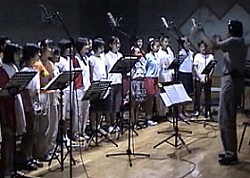 John: AOMusic was selected to compose theme music for the 2008 Summer Olympics in Beijing and Give Kids the World. Plus AOMusic is featured in the 2011 promotional trailer for Project Peace On Earth. How did you both become involved with these projects, and what is the mission behind the projects?
John: AOMusic was selected to compose theme music for the 2008 Summer Olympics in Beijing and Give Kids the World. Plus AOMusic is featured in the 2011 promotional trailer for Project Peace On Earth. How did you both become involved with these projects, and what is the mission behind the projects?
Miriam Stockly: I was living in London at the time when I received a call from Richard in the States. He asked me if I would be interested in working on a piece of music he and Jay had composed specifically for the Chinese Olympics. He had heard my work with ‘Adiemus’ and he wanted to incorporate my African kids tribal sound (to which I had become synonymous) into the track. That is how I became involved.
Richard Gannaway: Frank Mayor of Cinevision International brought Jay and I to Beijing in 2001 and introduced us to a China Record Company executive who was asked by the Beijing Olympic Committee to procure theme music. We gave him Grow Wild as a demo, and the committee liked it enough to give us a go at it.
Give Kids the World is a fantasy resort where terminally ill children from around the world can go with their families – often the end product of the Make a Wish Foundation. Miriam and I were invited to tour the complex, after which they asked us to write their theme piece, which is the first track Gaiya Lo Mane.
Steve Robertson of Project Peace on Earth called me in 2009, just after we released the Twirl album and invited AOMusic to be a musical ambassador for the project. The PPOE vision is to hold concerts once a year at a sacred site, like Stonehenge, the Great Pyramids, Machu Pichu, etc, and simulcast the show to a global audience for fundraising, similar to Live-Aid. The proceeds then feed and clothes children in the Middle East and Africa.
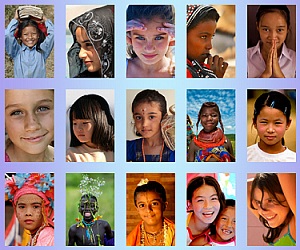 John: Richard, I know you and Miriam are committed to helping children around the world, and you try to spread the message and support them in a number of ways. What moved you, or what was the catalyst that first led to your own personal decision to provide support for children’s projects?
John: Richard, I know you and Miriam are committed to helping children around the world, and you try to spread the message and support them in a number of ways. What moved you, or what was the catalyst that first led to your own personal decision to provide support for children’s projects?
Miriam Stockly: I am a mother of two beautiful and talented children, who have been fortunate enough to grow up in a loving and nurturing environment, unlike so many children in war torn, weather stricken and third world countries. Children are an inspiration to us all. Their innocence touches our hearts and the message that is sent out via the sound of children’s voices is a very powerful one. I have always supported children’s charities, beginning with an African child I ‘adopted’ many years ago via the Red Cross.
Richard Gannaway: At the start of this project, I was simply creating an international aesthetic of children to convey a message of unity. It was not until AO began traveling in the developing world that I saw how many of them live in the most abject poverty imaginable.
It first struck me on a highway outside Manila while driving past miles of city waste heaps where thousands of homeless children lived. I saw the same wretchedness in the slums of Mumbai and urban squatter villages in South Africa. I think it changes most anyone from our culture who sees that firsthand.
John: The album – …and Love Rages On! – was composed different from a studio album. What was the process in which the both of you, and Jay Oliver composed, performed, and finalized the choir, vocal and instrumental parts?
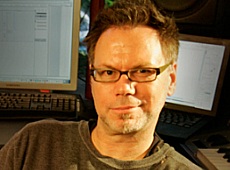 Miriam Stockly: Sometimes Richard would send me scratch tracks, to which I would write top melody lines. I would then fill in harmony blocks of vocals and the track would go over to LA for maestro Jay’s transformation. Other times, the track would come to me after Jay and Richard had put together the music arrangement and I would write melodies and (vocalese) lyrics over the top of the arrangement, followed by blocks of multi layered vocals.
Miriam Stockly: Sometimes Richard would send me scratch tracks, to which I would write top melody lines. I would then fill in harmony blocks of vocals and the track would go over to LA for maestro Jay’s transformation. Other times, the track would come to me after Jay and Richard had put together the music arrangement and I would write melodies and (vocalese) lyrics over the top of the arrangement, followed by blocks of multi layered vocals.
Richard Gannaway: Living in three different cities makes for an interesting way to produce an album, especially with sixty to a hundred tracks to mix per song. It works, because the three of us share a strong commitment to the music, and at the end of the day, that’s what it’s about for us. After 15 years AOMusic still leads us into new musical territory, and getting people to connect with the songs is what ultimately fuels AO Foundation International, so we have to keep improving.
John: Miriam, you also have your own solo career, releasing the albums Miriam, Second Nature & Eternal, plus you have performed vocals on Karl Jenkins’ Adiemus albums. Was integrating the choir parts and your vocals (vocalese) for AOMusic a lot like the chorales in Adiemus albums?
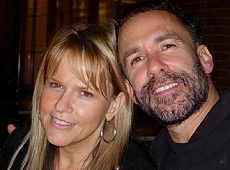 Miriam Stockly: To a certain extent, yes. The African choral sound I introduced into the Adiemus sound is what originally brought Richard, Jay and I together. However, as AOMusic has evolved, so has the vocal sound. I still use the African sounding voices when required, but I have since incorporated many other vocal textures into the mix to give the project light and shade.
Miriam Stockly: To a certain extent, yes. The African choral sound I introduced into the Adiemus sound is what originally brought Richard, Jay and I together. However, as AOMusic has evolved, so has the vocal sound. I still use the African sounding voices when required, but I have since incorporated many other vocal textures into the mix to give the project light and shade.
John: I understand you both are presently working on a new AOMusic album in 2012. I would love to release some information to help get the message out about AOMusic’s new album if possible. Is there any information you can tell us about with your newest project?
Richard Gannaway: Our upcoming album is scheduled for release in early 2013, and will feature children from Haiti, Nepal, Germany, Ireland, India and the Cherokee Nation outside of Asheville, NC. We have a new contributing producer, Bill Whelan of County Galway, Ireland whom we are honored to have among us, and we’ll be tracking some interesting new artists in Sandeep Chowta’s Mumbai studio this summer.
John: Perhaps there are some readers today who are interested in supporting the children too. What would you say to anyone reading our interview, about why it is so important to get involved and help support the kids?
Miriam Stockly: John, someone needs to be the voice of these children. They have been displaced by acts of God, man-made wars, greed and corruption within their own governments. They are the future of our planet and we need to take off the blinkers and get involved. As humanitarians and parents, it is our moral duty to do what we can to give these kids a voice and a fighting chance.
Richard Gannaway: Children populating our cultures today naturally enable our transition through the present changes, because they are a living providence of hope, and we should nurture each one as though kindling a flame for our survival.
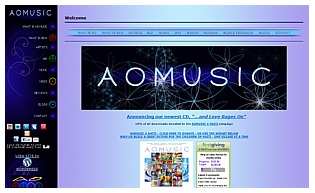 John: Your message is indeed worth sharing. Thank you both again for taking time out for our interview together and I hope we have a chance to visit again soon. I wish the best for AOMusic in the Zone Music Reporter Awards for 2012.
John: Your message is indeed worth sharing. Thank you both again for taking time out for our interview together and I hope we have a chance to visit again soon. I wish the best for AOMusic in the Zone Music Reporter Awards for 2012.
I always try to write a news publication about the ZMR Awards after the winners are announced so I hope to include AOMusic in one or more categories when announced on March 11, 2012. In closing, is there anything you would like to express to AOMusic fans and people who have supported you and the children over the years?
Richard Gannaway: Our deepest gratitude to ZMR and a world of great radio hosts and listeners for supporting these wonderful music genres. We are sincerely honored and privileged to be in the running this round.
Miriam Stockly: We thank you all from the bottom of our hearts for your loyalty and your support throughout the years, for believing in the quality of the music and message within. Most importantly, the children around the world thank you for not forgetting about them.
Visit the AOMusic.com homepage to sample or purchase or visit Amazon.com. Visit the primary member’s websites at RichardGannaway.com – MiriamStockley.com – JayOliver.com. Read more about the organizations Richard and Miriam mentioned at; AO Foundation International – HavServe – AOMUSIC 4 Haiti campaign. Photos are courtesy aomusic.com.

Al Conti is a GRAMMY® nominated musician people worldwide recognize as a composer with a natural ability for producing some of the most vibrant, story based albums in the new age and world music genres. Al Conti’s ability to intermingle his story based tales of intrigue into every one of his award winning albums, in part, originates from his life experiences and extensive international travels.
Al Conti is a nominee for the 54th GRAMMY® Awards in the Best New Age Album category, selected for his 2010 album entitled Northern Seas. Along with Al Conti’s GRAMMY® nomination in the new age genre, Northern Seas was also selected in Amazon’s Top 10 list for Best New Age Albums of 2010. Earlier albums Scheherazade, Poeta & Shadows have made other “best album of the year” and “top 10 album charts” at other organizations.
Northern Seas is the fourth album from Al Conti, and a fine release that highlights his abilities as composer, arranger, and multi-instrumentalist. The storyline on Northern Seas chronicles the ancestral homeland and Nordic heritage of Scandinavia with wondrous glory. The rich instrumental landscape captures your imagination, and valiantly stands the high ground on this resolute masterpiece aptly named Northern Seas.
 Northern Seas features 10 songs in a fascinating blend of new age and world fusion with a Celtic inscription on several songs. There is a unique atmosphere by using ancient instruments in parity with traditional instruments. Al and contributing artists create a unique feel blending kantele, harp, hurdy gurdy, pump organ, accordion, and tribal drums with piano, violin, cello, acoustic and electric guitar.
Northern Seas features 10 songs in a fascinating blend of new age and world fusion with a Celtic inscription on several songs. There is a unique atmosphere by using ancient instruments in parity with traditional instruments. Al and contributing artists create a unique feel blending kantele, harp, hurdy gurdy, pump organ, accordion, and tribal drums with piano, violin, cello, acoustic and electric guitar.
The folklore of Norse traditions brought to the surface by Al Conti is deep, rich, and intriguing while portraying a tale of Norsemen during a time of Viking sovereignty. Every song on Northern Seas is crisp, clear and refreshing, as if detailing the pristine landscape and panoramic mountain vistas by the deeply spacious tonal qualities.
New Age Music World host John P. Olsen had the opportunity to conduct a December 2011 interview with Al Conti, a 54th GRAMMY® nominee in the Best New Age Album category. Today we are pleased to present their up-to-date interview to Al Conti’s fans and to our site visitors – several days prior to the New Year 2012.
GRAMMY® Nominated Al Conti Interview;
 John Olsen: Thank you for consenting to my interview, Al. First I would like to congratulate you on your GRAMMY® nomination for Northern Seas! This is great news. It always pleases me when I hear an outstanding artist and their work are given the recognition they deserve. Northern Seas has many fine qualities, many of which were pointed out by a number of positive reviews at your site, AlConti.net. I was glad to be among those to contribute an album review, and I hope to have conveyed the award-winning potential, and some of the finer aspects of your work in the album review I wrote earlier.
John Olsen: Thank you for consenting to my interview, Al. First I would like to congratulate you on your GRAMMY® nomination for Northern Seas! This is great news. It always pleases me when I hear an outstanding artist and their work are given the recognition they deserve. Northern Seas has many fine qualities, many of which were pointed out by a number of positive reviews at your site, AlConti.net. I was glad to be among those to contribute an album review, and I hope to have conveyed the award-winning potential, and some of the finer aspects of your work in the album review I wrote earlier.
John: Aside from the fact Northern Seas is in the category for Best New Age Album, I feel Northern Seas is to some extent the most progressive of the five GRAMMY® nominated albums by a variety of instrumental qualities. Do you agree, and if so, do you feel having a nominated album that varies instrumentally from the rest will work to your advantage?
Al Conti: Hello John, it is my pleasure to be here with you! Many reviewers have commented before on how my work is rather different than much of the New Age music available these days. Some have called my work ‘cutting edge.’ Personally, I feel that New Age music is very rich in its diversity, and my work is a part of that spectrum. Whether my music’s edge works to my advantage or not, I am not sure.
During the nomination process, I have indeed heard from many peers, mostly from other genres, how they found my music to be so different. I guess it has, in the end, worked to my advantage. The ironic thing is I never strive to compose music that is different, per se, but just to be true to myself as an artist and simply create what comes from within me. The rest is all excruciating work!
John: On Northern Seas you pair old-world instruments of kantele, harp, hurdy gurdy, pump organ, accordion and tribal drums with modern instrumentation of piano, violin, cello, acoustic and electric guitar. I am familiar with the majority of songs on your earlier albums Scheherazade, Poeta & Shadows, but I would like to know, if this blend of ancient and modern instruments is consistent throughout every one of your four releases?
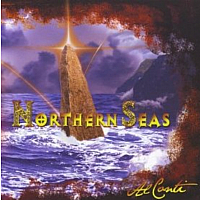 Al Conti: Since my album Scheherazade, I’ve been drawn consistently to rediscovering ancient instrumentation, and this also blends very well with the mystical landscapes I like to explore. People have responded very well to the use of these instruments. There is also something beautiful to me in bringing instruments and sounds into a modern content. It feels like I am in some way honoring the past by bringing these instruments into a more contemporary setting. I am never quite sure what will come out of me musically and I am always challenging myself as an artist with each release.
Al Conti: Since my album Scheherazade, I’ve been drawn consistently to rediscovering ancient instrumentation, and this also blends very well with the mystical landscapes I like to explore. People have responded very well to the use of these instruments. There is also something beautiful to me in bringing instruments and sounds into a modern content. It feels like I am in some way honoring the past by bringing these instruments into a more contemporary setting. I am never quite sure what will come out of me musically and I am always challenging myself as an artist with each release.
John: Would you tell us about the outstanding artists who performed instrumentals with you on your GRAMMY® nominated release?
Al Conti: I have been blessed to have worked with some amazing people, and continue to do so. For Northern Seas I wanted to work mostly with local talent, and except for Francesca Genco (vocals), all are Vermont artists. Among the contributing talent in Northern Seas there is the immensely-talented violinist Hannah Beth Crary, who was truly magnificent to work with and my trusted guitarist and engineer André Maquera.
John: You also have a team of music professionals you depend on for technical details and final production. Would you like to mention the people who helped you finalize Northern Seas?
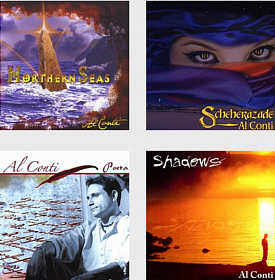 Al Conti: While I do a big part of an album’s mixing myself as I compose, I depend heavily on André Maquera, of West Street Digital, in Vermont, for the final mixing and mastering on my projects. I have worked with him since my first release, Shadows, and feel he understands my approach so well at this point as to know how to work with whatever I bring his way. Mastering is also a very arduous process and my hearing can only handle so much. Aside from the actual music engineering and recording, I work with a fantastic team of people that help oversee the other aspects of my career, without whom I could not do what I do.
Al Conti: While I do a big part of an album’s mixing myself as I compose, I depend heavily on André Maquera, of West Street Digital, in Vermont, for the final mixing and mastering on my projects. I have worked with him since my first release, Shadows, and feel he understands my approach so well at this point as to know how to work with whatever I bring his way. Mastering is also a very arduous process and my hearing can only handle so much. Aside from the actual music engineering and recording, I work with a fantastic team of people that help oversee the other aspects of my career, without whom I could not do what I do.
John: What do you feel are the most positive attributes of Northern Seas?
Al Conti: I think Northern Seas went in a different direction than my previous album Scheherazade. I feel it showcases my versatility as a musician and composer. My audience can hear a more classically-oriented side of me in my album Poeta, a more exotic and sensual one with Scheherazade and a more aggressive and brooding, yet also fun and hopeful side with Northern Seas.
John: In addition to your GRAMMY® nomination, Northern Seas made the Amazon Top 10 list for Best New Age Albums of 2010, and many of your earlier releases were also awarded “best of the year”, “top 10 charts”, and other “best album lists and top 100 charts.” What do you believe has been the most important influence that has led to your overall successes as an award-winning composer, arranger, producer and multi-instrumentalist?
Al Conti: I compose what comes through me, and this changes depending on the project I am working on at any given time. I tend to go to a certain emotional place when I compose and the right material flows through me. When a project is finished, it is as if someone has turned the creative faucet off, and nothing else comes through, so I know I am done. I believe that the key to anyone’s success, especially in this business, is made up of various elements such as what I mentioned above, coupled with hard work, perseverance, gut feeling, luck, timing and fate.
 I also believe it is important to follow one’s own path and not be overly influenced by what other artists do. While there may be a music trend we all follow and music that influences our style, it is good to do what really comes from the heart and not try to imitate someone else. I simply do what I do, surround myself with a magnificent team and we all pull forward in our own way, but in the same direction.
I also believe it is important to follow one’s own path and not be overly influenced by what other artists do. While there may be a music trend we all follow and music that influences our style, it is good to do what really comes from the heart and not try to imitate someone else. I simply do what I do, surround myself with a magnificent team and we all pull forward in our own way, but in the same direction.
John: Every one of your new age albums is based a theme or legend and portrays a story. What is the story based representation or theme behind Northern Seas, and how did you arrive at the concept for Northern Seas?
Al Conti: Northern Seas is based on Norse mythology. While my previous album, Scheherazade, was based on the teller of the fantastic Arabian tales, Northern Seas was a little more complicated to nail down as a concept. I did a tremendous amount of research when the idea for this project first came to me. I could have based the album on a particular Norse myth, but I felt that there were many important ones that would have been left out. The album as a concept takes many of the Norse myths and weaves them into one cohesive narrative.
John: How do you transpose an inspirational or story-based theme into a musical arrangement?
Al Conti: This is also something that is very hard to describe, because I do not have a specific formula that I follow. Each project is based on a particular myth or tale. This already sets the parameters I will work within because each part of the world and its respective culture has a definite music style, which I then follow.
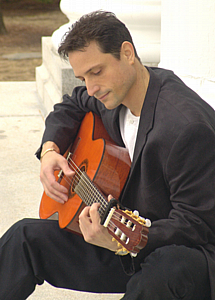 Scheherazade was Middle Eastern; Northern Seas is Nordic, Celtic and Germanic. But I also do not want to compose an album that is fully regimented by a culture’s musical style and mood, thus I tend to modernize the music to make it more appealing to a Western audience. As such, I end up with the music I compose, which is peppered with world cultural influences, yet remains primarily New Age. I do believe my past as an actor also thoroughly influences my approach to my music compositions because I innately tend to approach my music composition as a film.
Scheherazade was Middle Eastern; Northern Seas is Nordic, Celtic and Germanic. But I also do not want to compose an album that is fully regimented by a culture’s musical style and mood, thus I tend to modernize the music to make it more appealing to a Western audience. As such, I end up with the music I compose, which is peppered with world cultural influences, yet remains primarily New Age. I do believe my past as an actor also thoroughly influences my approach to my music compositions because I innately tend to approach my music composition as a film.
John: At your music blog – alconti.blogspot.com – you detail how producing music has changed for you since the earliest years when you first began producing music. What are some of the changes you have made over the years, and the challenges you face while producing music today?
Al Conti: Many of the changes are dictated to me by the music industry that I am a part of. I feel one of the biggest mistakes artists can make is to not accept the fact that the music business is, first and foremost, a business. Since I came from an acting background, well versed in the complex workings of that business, I simply translated acting to music and brought along with me the same work ethics I had from that part of my life. I also feel each project I undertake lays the groundwork for the direction of my career. Because I am also a perfectionist, nothing I compose is ever good enough for me and I always strive to better myself.
John: Has having your own Shadowside Music label been a major influence with the manner you produce and market your music?
Al Conti: Absolutely. I can decide what I want to create without having to answer to someone else’s idea of what I should be creating. I also have full control over every aspect of my career and creative output. Because I happen to also be the producer and arranger of my own albums, I can truly follow my gut instinct and move forward from there. Of course, I knew that the path I chose was plagued with risks and I did not know if these would pay off until they did.
Much like an actor producing and directing his or her own film, producing one’s own album can either make or break you. For me, luckily, it was the former, not the latter. It was a great risk, but I took it head on. I am at a point now in my career where I can honestly say that the path I chose has indeed paid off and I can continue forward knowing I am doing what I am supposed to be doing and that it is working out well. As people now ask me for advice, I find myself saying, “Hey, my path and how I walked it to this point has worked for me, but it may not work for you at all.” Thinking of many successful artists, I venture to say you’ll find each got there in very different ways.
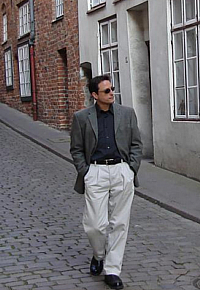 John: Early in life you were determined at a very young age to become an actor. You appeared in commercials and were an actor in the acclaimed As The World Turns American television series. By all accounts Al, you had achieved the acting career you envisioned for yourself. What was the turning point where you decided to change direction to pursue a music career, and how did this change to a new career transpire over the years?
John: Early in life you were determined at a very young age to become an actor. You appeared in commercials and were an actor in the acclaimed As The World Turns American television series. By all accounts Al, you had achieved the acting career you envisioned for yourself. What was the turning point where you decided to change direction to pursue a music career, and how did this change to a new career transpire over the years?
Al Conti: I do not think any artist will ever say, “Yes, I achieved what I artistically set out to achieve,” because we’re always looking forward to the next creative project. As an actor, I do not think I ever fulfilled that which I strived to achieve since I was a child, and I believe music has allowed me to express artistically in ways acting did not. I also came to a place in my life where I did not have the need to play someone else to express myself. With music, regardless of the project, I am always expressing my truest self through my work, yet I can be an actor at the same time because my projects are pretty much like a film that is being played out musically.
John: I read you were born and raised in Buenos Aires, Argentina. Your grandfather was a concert pianist, and your mother was a classical ballerina. What are your thoughts – do you believe talents in the arts, in fields like theatre or music, are heredity, or, do you feel non-genetic factors play more of a role with inclinations toward an individual’s profession?
Al Conti: I cannot honestly say. I know I was born an artist, which as a child created nothing but problems for me in school. But because my parents and grandparents (and even beyond that to my extended family) were and are artists in their own way, I was lucky in that they completely encouraged me. I do, however, believe that we are born with the talents we will hopefully hone throughout our lives, whether you are an artist, teacher, lawyer, social worker or whatever. I tried being other things than an artist and failed miserably.
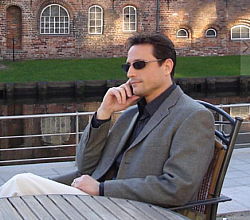 It was clear to me that I could only work in the arts. This is why I cringe when parents force their kids to play the piano or do anything else artistic if the child really has little inclination in that direction. It would have been the same for me if, say, my parents had forced me to be right handed while my inclination was to be left handed. As an actor, I saw some sad things happening with parents who would bring their children into auditions. Not pleasant!
It was clear to me that I could only work in the arts. This is why I cringe when parents force their kids to play the piano or do anything else artistic if the child really has little inclination in that direction. It would have been the same for me if, say, my parents had forced me to be right handed while my inclination was to be left handed. As an actor, I saw some sad things happening with parents who would bring their children into auditions. Not pleasant!
John: While living in Argentina, you grew up listening to ethnic music from many parts of the world, plus you have extensively traveled the globe. Would it be fair to say your music is a vehicle that describes many of your life experiences and international travels?
Al Conti: I think as artists we take everything we have gathered throughout our lifetime and put it into our work, because what we do comes from the deepest fibers of our beings. Because I was raised in different cultures, this broadened my horizons culturally. I innately know how one culture can function differently from another. When I compose music, based on a certain culture, the way that culture expresses itself deeply affects how I compose.
John: You have led a diverse life compared to many people. You now reside in the state of Vermont in the United States. What is it about the state of Vermont you adore?
Al Conti: I have always felt at home in Vermont. It is a state with deep French Canadian roots, which in many ways resembles the culture in which I was raised. Those cultural roots can still be felt in Vermont. While I have lived in a few different states in the U.S., Vermont is definitely the only one I have ever felt like calling my home.
John: I read at – alconti.net – you are currently working on your fifth album. I would love to release some Al Conti news for your fans and our readers today if possible. Can you release any information about your newest, fifth album project?
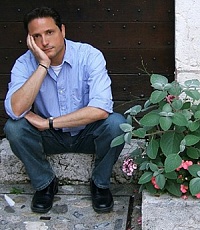 Al Conti: I usually tend to be very private about what project I am currently working on. I blame my past as a superstitious actor for this! I never want to jinx the project. There are also the legal ramifications of my talking about it at such an early stage. What I can say is that the album’s progress is half way, and I am excited that there are some very well-known guest New Age artists that will be participating in the project.
Al Conti: I usually tend to be very private about what project I am currently working on. I blame my past as a superstitious actor for this! I never want to jinx the project. There are also the legal ramifications of my talking about it at such an early stage. What I can say is that the album’s progress is half way, and I am excited that there are some very well-known guest New Age artists that will be participating in the project.
I can also say that the album will be more on the lines of my previous work Scheherazade, and I think people will be very happy about that, even though it is far from that album’s Middle Eastern theme. As an artist, I never want to repeat myself musically, so I strive to keep moving forward. While I know that many people loved Scheherazade, and it would be easy for me to fall back into another Middle Eastern theme, I refuse to do so. My current project is based on yet another beautiful legend and I will let my audience discover it as the time approaches. It is tentatively scheduled for release in September 2012.
John: During your work with humanitarian organizations, you teamed up with television celebrities Kevin Bacon, Jessica Alba, and Shelly Morrison for a charitable benefit. Can you tell us about your contributions with humanitarian organizations over the years?
Al Conti: As an artist with a certain level of success, I always feel I need to give back. Because I have been touched by many situations in my life, I feel like those are the ways I can give back. Unfortunately, we live in a world that has many, many causes we could rally for, but eventually, one can only do so much.
I have chosen carefully the charities I align myself with. AIDS, Leukemia and Alzheimer’s, as well as breast cancer, have all affected people I care about. In my own way, I try to raise awareness about these illnesses. I find that when people like what you do they are more apt to listen and take notice. When recently asked by a dear friend and fellow New Age artist about how I felt regarding my GRAMMY® nomination, I replied that I feel like this now allows my heart to give more. I truly mean that.
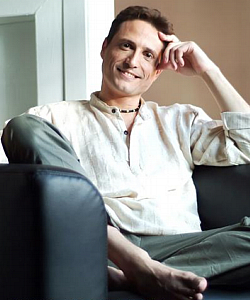 John: I read you are also involved in a wellness organization called The Spa Buzz, an organization that helps spread the message of wellness through activities like their awareness-raising bus tour. Would you like to tell us about your contributions with The Spa Buzz organization?
John: I read you are also involved in a wellness organization called The Spa Buzz, an organization that helps spread the message of wellness through activities like their awareness-raising bus tour. Would you like to tell us about your contributions with The Spa Buzz organization?
Al Conti: Yes, I was involved with this event as they toured the country promoting a message of health and wellbeing. This is something my team initially brought to my attention and I agreed to take part in it by lending my music to the project and attending events on the East Coast, because I truly believe people can be healthier, pay more attention to and be in tune with their bodies. The Spa Buzz did a great job for health awareness, and promoted the way music can contribute to wellness along the way.
John: You have enjoyed a remarkable career as a musician, Al. What do you find most rewarding as a professional musician?
Al Conti: I think, as I mentioned before, the more success I find as a musician, the more I am able to give back to others. Once I heard a saying that went: “When you get to the top floor, make sure to send the elevator back down for somebody else.” I never forgot that. While I do not think I am anywhere close to the top floor, I do believe that with a certain amount of success, there comes a responsibility to give back, and the universe sends our way those who can benefit from what we have to give, and vice-versa.
John: Thank you again for taking time out for our interview. I wish the best for you in the 54th Annual GRAMMY® Awards scheduled for Sunday Feb. 12, 2012. In closing for now, is there anything you want to bring up, or express to your fans and the people who have supported you over the years?
Al Conti: There are always a few things, for sure. One is something I always speak of when able to, and that is the sad state of music piracy. Since I have been involved in the music industry, I have become increasingly aware of the ravages that the illegal download of music is doing to artists worldwide. Many people do not even realize that they are actually stealing music. While some do indeed believe that we, as artists, should work for free, most simply do not realize the impact they have on the economy with even just one song illegally downloaded.
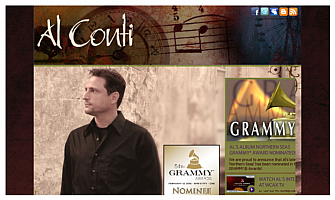 Independent musicians now form a large part of the music industry and they do not make millions, far from it. Many can barely survive on the income they receive from their music work. I would hope the right amount of respect be given to their efforts by actually purchasing their work rather than downloading it illegally.
Independent musicians now form a large part of the music industry and they do not make millions, far from it. Many can barely survive on the income they receive from their music work. I would hope the right amount of respect be given to their efforts by actually purchasing their work rather than downloading it illegally.
A fellow artist, Loreena McKennitt, is a big spokesperson for this, and she has actually had to lay off people from her company because the illegal downloads of her work have made it impossible for her to maintain their employment. This is extremely sad for me to see. No one would ever accept to work for free, why should artists?
Thanks so much for this time, John, and for the work you do for New Age music!
John: I get to know many artists personally, and I feel the same way too about the music piracy issue of illegal downloads. I am pleased to be in a position to help get the message across. I look forward to writing more about you soon Al.
Visit the alconti.net homepage and his music store where you can sample or purchase all four albums, and keep up with the latest news. You are invited to visit Al’s official blog at alconti.blogspot.com and Facebook page. Read my Al Conti page.
Photos are courtesy alconti.net and with additional photographer credits of – Michael Mattern, Patrick Cote, John Young, Gerrit Ohm, and Kay Dillenberger.

GRAMMY® nominated composer David Arkenstone is a celebrated new age artist who has produced an extensive collection of great instrumental albums over the course of his distinguished career. David Arkenstone’s popularity as a favorite artist for many persons including myself is clear when you consider he has sold well over a million albums throughout his extensive career as a popular favorite.
The admiration for David Arkenstone and his reputation as a top new age artist is apparent by other benchmarks too, having reached the Top 10 Billboard New Age charts twenty times. He is a gifted musician accustomed to playing a variety of instruments, some of which include electronic keyboards, piano, cello, flute, harp, mandolin and a number of ethnic guitars. David is also a talented percussionist, sings vocals on some of his albums, and regularly performs live music during tours as a performing new age concert artist.
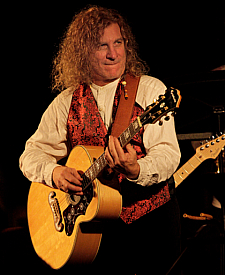 David Arkenstone is a three times GRAMMY® nominated musician, having earned nominations for his three albums In the Wake of the Wind, Citizen of the World, & Atlantis. In addition he has composed numerous recordings for film and television, some of which are shown on the History Channel, Discovery Channel, NBC Sports and many other televised programs.
David Arkenstone is a three times GRAMMY® nominated musician, having earned nominations for his three albums In the Wake of the Wind, Citizen of the World, & Atlantis. In addition he has composed numerous recordings for film and television, some of which are shown on the History Channel, Discovery Channel, NBC Sports and many other televised programs.
Echoes of Creation is a new soundtrack he composed for Jan Nickman’s nature inspired film that was aired on PBS stations nationwide. David has also composed a number of top rated computer gaming scores like World of Warcraft, Blade Runner, Lands of Lore, Earth and Beyond & Emperor.
David Arkenstone and his popular album collection are a broad array of ambient, Celtic, contemporary instrumental, world, electronic, and new age fusion. Diversity is a unique characteristic of David Arkenstone’s ingenious skills as a songwriter and his extensive music collection. He also performs live concerts with Seth Osburn and John Wakefield in his world music inspired band Mandala.
New Age Music World host John P. Olsen recently had the opportunity to provide a December 2011 interview for internationally famous David Arkenstone. Today we are pleased to present their up-to-date interview conversation to David’s fans and to our site visitors weeks prior to the new year 2012.
David Arkenstone Interview;
John Olsen: Thank you for giving everyone a moment of your time David. Like your many fans, I too have been an admirer of your music for many years, so our interview together is especially rewarding to me personally.
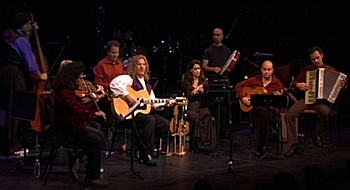 I noticed at your website you appear to have a close connection with your fans by easy access and information for them at your website news page, Twitter and Facebook social networking pages.
I noticed at your website you appear to have a close connection with your fans by easy access and information for them at your website news page, Twitter and Facebook social networking pages.
Over the years, the internet and technology has influenced everyone to some extent, and new technology directly applies to the technique in which you produce music.
John: Would you like to begin our interview by telling us about your life as a musician in the early years, preceding the time when technology changed the way you produce music?
David Arkenstone: I had several different configurations of my rock band, Arkenstone. I played guitar and keyboards. I’ve always loved synths and used them in my music, as well as all kinds of different sounds. So I was doing that. Once synthesizers and computers started communicating, I threw myself into that world and never looked back. I was able to hear things I could only previously imagine.
John: Since computer technology or electronic music has influenced the process in which you compose, what has proven to be the most beneficial aspect of your electronic enhanced orchestrations?
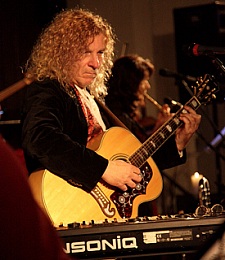 David Arkenstone: That would be all the things I can hear at the same time. Like a fully orchestrated piece with percussion, strings, brass, woodwinds. Or if I’m doing a more non-orchestral piece, I can hear the guitars with the drums, keyboards, generally all the sounds I use. This is so beneficial to being able to shape the piece as I go. There is an endless amount of tweaking until I’m satisfied. This can sometimes take a long time!
David Arkenstone: That would be all the things I can hear at the same time. Like a fully orchestrated piece with percussion, strings, brass, woodwinds. Or if I’m doing a more non-orchestral piece, I can hear the guitars with the drums, keyboards, generally all the sounds I use. This is so beneficial to being able to shape the piece as I go. There is an endless amount of tweaking until I’m satisfied. This can sometimes take a long time!
John: Many of your releases have bold majestic themes and popular music influences. When composing, do you intentionally set out to merge many influences into your music compositions, and how do you achieve a proper balance of electronic and instrumental orchestrations?
David Arkenstone: I usually try to start with a concept that resonates with me, and then decide which aspects of that concept I would like to illustrate with music. After the pieces begin coming out, I figure out my ‘palette.’ From that I can find a balance of sounds and decide which elements can be computer generated and which should be live musicians. This period includes a lot of exciting exploration.
John: Along with your Echoes of Creation Soundtrack & Ambient World releases, don’t you have a varied collection of Celtic songs?
David Arkenstone: Celtic Journeys is a compilation of my Celtic inspired recordings on the Green Hill label.
John: In your diverse music collection, Visions of Christmas is another relatively new release. With the holiday season drawing nearer every day, perhaps you could tell us about the songs on Visions of Christmas, and how your holiday album was produced?
David Arkenstone: I love the holidays and have been doing holiday concerts for a long time. This album came about because I was playing a lot of arrangements in our Winter Solstice concerts that I’d never recorded.
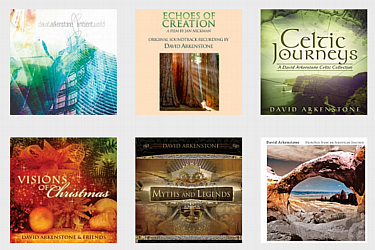 I really wanted to do another Christmas album and my producing partner, Victoria Paige Meyerink, suggested we combine the concert tunes with some of my favorites for Visions of Christmas. We’ve also filmed several of the concerts and we’re working on a DVD of the Winter Solstice Tour.
I really wanted to do another Christmas album and my producing partner, Victoria Paige Meyerink, suggested we combine the concert tunes with some of my favorites for Visions of Christmas. We’ve also filmed several of the concerts and we’re working on a DVD of the Winter Solstice Tour.
John: Again, I am very familiar with your entire discography David. Likewise, I am confident the majority of people reading this interview are too. For those who may be less familiar with your variety of great releases, what 4 albums would you recommend to them as a starting point to begin sampling your discography?
David Arkenstone: Visionary, Atlantis, Myths and Legends & Ambient World.
John: Yes, I certainly agree your 2 disc collection of songs on Ambient World is an excellent choice. This is one of your new albums I would recommend to everyone too. Earlier, Victoria Paige Meyerink informed me that Ambient World was listed in the 25 Essential Echoes CD’s for 2011. In your diverse music collection, I find many of your albums “boldly adventurous” if I can phrase it this way. Many releases including Eternal Champion & Quest Of The Dream Warrior are best described as having epic or majestic themes. Do you begin a project with a predetermined theme or does a project’s theme define itself later on while you are composing?
David Arkenstone: I usually start with a thread of an idea, though also it can materialize after I’ve composed several pieces. That can generate ideas for me, or a more specific direction.
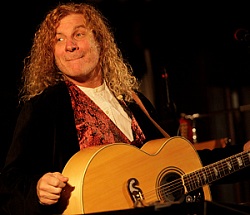 John: You have composed numerous music recordings for film and television like the History Channel, Discovery Channel, NBC Sports and others. The Echoes of Creation soundtrack you produced with Emmy award winning director Jan Nickman is another example of your outstanding film scores.
John: You have composed numerous music recordings for film and television like the History Channel, Discovery Channel, NBC Sports and others. The Echoes of Creation soundtrack you produced with Emmy award winning director Jan Nickman is another example of your outstanding film scores.
In addition your numerous computer gaming scores like World of Warcraft, Blade Runner, Lands of Lore, Earth and Beyond, & Emperor. What are some of the challenges and dissimilarities involved with soundtrack, film and gaming scores verses composing music for an album?
David Arkenstone: A music album is completely free. I think of the road I want to go on, what instruments I want to use, and all of the final outcome. With a project involving another person’s vision, I have to determine the palette, style, and mood that will best fit the project. Then I have to please my collaborators and make sure all the elements work together.
John: Would you tell us about your world music group Mandala?
David Arkenstone: I recently started this group with a couple of my friends, Seth Osburn & John Wakefield, to perform more world music inspired pieces that are more improvisational in nature. Some are very danceable, and some are very moody, but all of them have a spiritual aspect. Mandala is evolving and we recently filmed a concert. We will be releasing footage once it’s fully edited.
John: In addition to your numerous album releases, you have been a concert performer for many years, including the renaissance festivals earlier this year. Would you like to provide some details about the musicians who perform with you, and what one can expect when attending a David Arkenstone concert in terms of atmosphere, interaction, and songs you play?
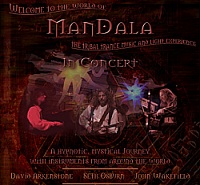 David Arkenstone: It’s fun to step back in time. Basically, it’s me and the band without synths and sometimes little amplification. We’ve been invited to several Renn fairs and enjoy being in costume and playing some of my Celtic inspired works.
David Arkenstone: It’s fun to step back in time. Basically, it’s me and the band without synths and sometimes little amplification. We’ve been invited to several Renn fairs and enjoy being in costume and playing some of my Celtic inspired works.
A lot of the World of Warcraft fans attend and I really love performing live to such enthusiastic crowds. It’s a relaxed atmosphere and I have the opportunity to meet with people who’ve been following my career – one person saved tickets from one of my first concerts, brought them to the fair and asked me to autograph them! People bring all sorts of memorabilia.
John: I heard the news you have plans for a new David Arkenstone album with a release date sometime in 2012. Do you have an album title for your new project, and can you tell us about the music you have in mind for your new release for 2012?
David Arkenstone: Well, I’m not ready to say too much about it yet. There are vocals, lots of drums and orchestra, as well as all the other instruments I play. I’m very excited about it. The album is collaboration with Charlee Brooks, a wonderful singer and writer, and it’s one of the most rewarding experiences of my career. We have written it almost as a soundtrack.
John: You have a large international fan base, and you have enjoyed a successful music career practically your entire life. What do you find the most rewarding experience as a professional musician?
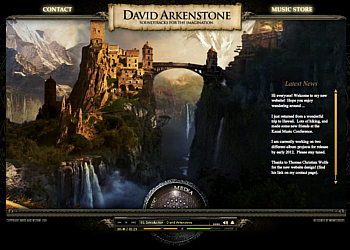 David Arkenstone: That’s simple, the most rewarding aspect is that people enjoy my music and because of that, I get to do what I love every day. I’ve been lucky to make music that resonates with so many people, and their support and kind words make every day a musical joy.
David Arkenstone: That’s simple, the most rewarding aspect is that people enjoy my music and because of that, I get to do what I love every day. I’ve been lucky to make music that resonates with so many people, and their support and kind words make every day a musical joy.
John: Your new website looks fantastic! It’s easy to navigate too. I know you have a new album project you are working on and a busy schedule so I want to thank you again for letting me host your most current interview David. It has been a privilege to provide today’s news coverage about you!
I will publish more articles about you in time but do you have any departing words before we close for now?
David Arkenstone: Just that I appreciate your support of music and your efforts to connect musicians with the listeners. I hope everyone will enjoy my new 3-D website and follow me on Facebook and Twitter.
Visit the new davidarkenstone.com website and purchase his music at David’s online store or find at David’s profile page at domomusicgroup.com. Discover more fine artists at domomusicgroup.com homepage and read my David Arkenstone page. Interview photos are courtesy David Arkenstone.

Multi-platinum pianist Jim Brickman is one of today’s most beloved artists whose selection of romantic piano and Christmas music spans across a wide variety of popular music genres. With 6 of his albums acquiring Gold and Platinum status, it’s easy to see why Jim Brickman is a prominent celebrity in the popular and new age instrumental music genres. Likewise, he is renowned as the greatest pianist in the Adult Contemporary genre category, having charted more than any other male performer.
 Jim Brickman is a highly recognized entertainer and recording artist who has thrilled millions of people for years with his award winning collection of popular piano music which can range from solo piano, popular, mainstream music, adult contemporary, and a wonderful selection of Christmas albums, many of which are available in CD and DVD formats.
Jim Brickman is a highly recognized entertainer and recording artist who has thrilled millions of people for years with his award winning collection of popular piano music which can range from solo piano, popular, mainstream music, adult contemporary, and a wonderful selection of Christmas albums, many of which are available in CD and DVD formats.
With 6 Gold and Platinum albums, 2 GRAMMY® nominations, and 30 chart topping adult radio hits, Jim Brickman is accustomed to prestigious awards and recognition. Along with 2 SESAC Songwriter of the Year awards, a Canadian Country Music Award, and a Gospel Music Association Dove Award, he is tied for the most #1 albums in Billboard’s New Age charts. Presently listed in the Top 10 of Billboard’s New Age Charts are three of Jim’s albums; All is Calm, Romanza, & Love.
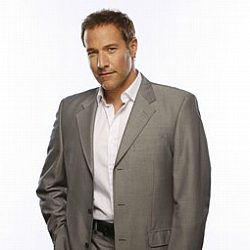 Jim Brickman is likewise cherished for his countless album collaborations with other popular celebrity artists, some of which include Lady Antebellum, Kenny Loggins, Martine McBride, Olivia Newton-John, Donny Osmond, Carly Simon and Michael W. Smith. During the course of his lengthy career Jim Brickman has become a household name, having crossed over into mainstream piano music that is adored by millions of people worldwide.
Jim Brickman is likewise cherished for his countless album collaborations with other popular celebrity artists, some of which include Lady Antebellum, Kenny Loggins, Martine McBride, Olivia Newton-John, Donny Osmond, Carly Simon and Michael W. Smith. During the course of his lengthy career Jim Brickman has become a household name, having crossed over into mainstream piano music that is adored by millions of people worldwide.
The Christmas holidays are a special time of year that symbolizes another period in time when people often associate Jim Brickman, and his special variety of piano instrumental Christmas music. Currently Jim is beginning his 2011 Holiday Concert Tour in the continental U.S. Also recognized for his humanitarian efforts, Jim is involved with many charitable foundations dedicated to improving the lives of children and their families, including Autism Speaks, UNICEF and Camp Heartland.
New Age Music World host John P. Olsen had an opportunity to interview Jim Brickman at the very start of his opening Christmas Concert Tour in 2011. Today we are pleased to present their conversation to Jim Brickman’s international fan base and to our global site visitors.
Interview with Jim Brickman;
John Olsen: Thank you so much for accepting my interview invitation Jim. I realize this is an especially busy time for you. It is truly a privilege to be the host for your most current interview. Currently you are about to begin your 2011 “A Christmas Celebration” Concert Tour, which has numerous concert venues in major cities throughout the continental U.S.
John: When traveling across the country on tour with full entourage I imagine the excitement of every performance takes a lot out of you, and the entire team. How do you and everyone on the team re-energize and prepare for the next concert?
Jim Brickman: Each city, theatre and audience is different. Knowing this helps keep the performances fresh and exciting. It really is like celebrating Christmas every day.
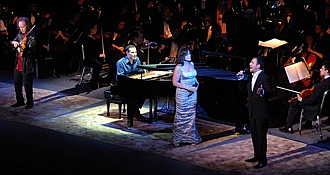 John: During your Christmas Concert Tour in 2011 you have special guest vocalist Anne Cochran and Ben Utecht, with violinist Tracy Silverman. I have heard these artists on your YouTube videos and must say you have a great team Jim! Would you like to tell everyone about the exceptional artists who will be performing with you during this year’s A Christmas Celebration Concert Tour?
John: During your Christmas Concert Tour in 2011 you have special guest vocalist Anne Cochran and Ben Utecht, with violinist Tracy Silverman. I have heard these artists on your YouTube videos and must say you have a great team Jim! Would you like to tell everyone about the exceptional artists who will be performing with you during this year’s A Christmas Celebration Concert Tour?
Jim Brickman: I’ve been performing with Anne Cochran and Tracy Silverman for many, many years. Anne and I met in high school. I look forward to performing with her, not only because we are close friends, but because she has a beautiful voice and a great personality.
Tracy is a brilliant musician who adds a dimension to my concert that you don’t normally expect to hear. Ben Utecht is new to the tour, but may be a familiar name to NFL football fans. He was a member of the Super Bowl Championship Indianapolis Colts. He has a powerful voice that brings new meaning to familiar songs and old favorites. Ben has a large presence on stage, and he wears his Super Bowl ring!
John: How many seasons have you held Christmas concerts to date, and how do you determine which of the many exceptional artists to choose from will be performing with you? If it is not a secret, can you tell us some of the Christmas songs concert attendees will hear during your 2011 season?
Jim Brickman: This is the 16th year of the holiday tour. I will be playing holiday favorites and a few songs from my latest CD Romanza. Plus the hits, because everyone wants to hear the hit songs. I hope for a few hours the audience can wrap themselves up in the holiday spirit through my music.
John: Over the years you have been Grammy nominated, won countless music awards, in addition to 6 of your releases attaining Gold and Platinum status. It is obvious people adore your music Jim. Do you feel there a specific element about your music that you feel has helped you achieve worldwide popularity?
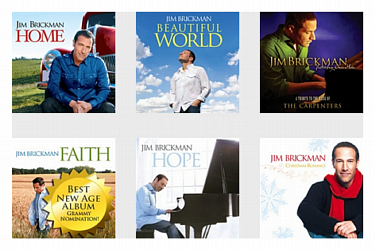 Jim Brickman: As I write music, I think about where people will be listening to it, and how it will make them feel. Because the majority of my songs have no words, people can listen, apply it into their own lives, and take away what they need to hear.
Jim Brickman: As I write music, I think about where people will be listening to it, and how it will make them feel. Because the majority of my songs have no words, people can listen, apply it into their own lives, and take away what they need to hear.
John: I am confident most people reading this interview are familiar with your music. For those people who may be less familiar with your many albums, what albums would you suggest for a starting point for them to begin sampling your music?
Jim Brickman: If You Believe is my signature song and I think it also best represents my “sound.” It symbolizes my dream of composing and performing, and the belief in myself to bring it to fruition. It’s on the CD Picture This.
John: From your great selection of Christmas music CDs and DVDs, what would you recommend they sample or purchase?
Jim Brickman: That’s like asking which is your favorite child. I have a new CD called All Is Calm that’s available at Target.
John: You have been a successful musician nearly your entire life. Knowing there are other artists reading our interview today, can you give any advice or offer a helpful strategy to those artists who are just beginning their music career?
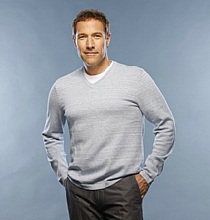 Jim Brickman: Listen to many different artists that you enjoy and admire. Hear what it is in their music and lyrics that speak to you. Then when you sit down to write, adopt what you like from other elements and make it your own.
Jim Brickman: Listen to many different artists that you enjoy and admire. Hear what it is in their music and lyrics that speak to you. Then when you sit down to write, adopt what you like from other elements and make it your own.
So many pianists tell me “Everyone says I sound like Jim Brickman. How do I start my career?” Well, there’s already a Jim Brickman, so I tell them the best way is to create a new, unique sound. Find places to be heard. And don’t be afraid of rejection. Find places to play and show off your talent. Start small and get your style and personality known so that you can grow your career.
John: In regards to your talents as a pianist, would you say you have natural born talents as a pianist, or has it merely taken practice and dedication to reach the level of expertise you have achieved?
Jim Brickman: I started playing piano when I was 4. I begged my parents to buy me a piano. So, that part was natural. I had a lot of piano teachers growing up, and they all wanted me to play in what I call “their style.”
It wasn’t until I studied at the Cleveland Institute of Music, that I found a teacher who helped me develop my own style. It evolved out of my classical training and my love of pop music. That’s what you hear today.
John: You have collaborated on numerous projects with famous artists like yourself over the years. Would you like to tell us about your experience while working with esteemed artists like yourself?
 Jim Brickman: I love writing with different people because each one draws something new out of me. As I write I hear a specific sound singing the vocals. I love using new voices that may not be familiar to listeners because they come to me with an eagerness and fresh energy. Of course, many have gone on to become household names like Martina McBride and Lady Antebellum.
Jim Brickman: I love writing with different people because each one draws something new out of me. As I write I hear a specific sound singing the vocals. I love using new voices that may not be familiar to listeners because they come to me with an eagerness and fresh energy. Of course, many have gone on to become household names like Martina McBride and Lady Antebellum.
John: When visiting your jimbrickman.com website I read you are offering a “Jim Brickman Escape Cruise” in 2013, where you and anyone interested can sail the Eastern Caribbean together. What are some of the cruise destinations you have traveled during your earlier vacation cruises, and what are some of the onboard cruise activities?
Jim Brickman: We have sailed all over the Caribbean, and the Mexican Riviera. Two years ago we took an amazing trip to Alaska, and this year we went to Hawaii. I do two concerts onboard, usually in a cabaret style theatre that lends itself to a more casual performance.
A favorite for the fans is the songwriting workshop where we actually write a song with the help of the audience. My parents have become a popular addition to the cruise, and we have a Q&A session with them where they tend to say more than they should! There are casual get-togethers where we all just hang out.
What’s really cool is that a lot of the same people who come back year after year and have made lifelong friends that they continue to travel with.
John: I saw at your website the CDs and DVDs items in your Christmas store section are generously priced at $10 and under. Even your newest releases Romanza & All Is Calm CDs are on sale. Would I be correct in saying Christmas is a very special time for you, and could you tell us why Christmas holds so much significance to you personally?
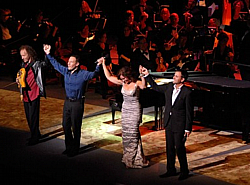 Jim Brickman: This may sound corny but, what makes Christmas so special to me is the music. We hear the same songs year after year. They create memories that tie generations together.
Jim Brickman: This may sound corny but, what makes Christmas so special to me is the music. We hear the same songs year after year. They create memories that tie generations together.
The old songs are sung in their original form or updated versions, but the message is the same. And sharing that with audiences every night is a wonderful gift I can share.
John: You are also involved with many charitable foundations for children. Would you tell us about your work as a philanthropist?
Jim Brickman: I try to get involved with charities that are affected by my music. When I heard that children with Autism responded to my music, I got involved with Autism Speaks. After Beautiful World was released, we raised money for UNICEF.
People tell me how my music has helped them through chemotherapy, and really hard times in their lives. It important to me to help raise awareness any way I can. Also, a scholarship has been established at my alma mater the Cleveland institute of Music in my honor.
John: Do you have any news or information to pass along regarding any new album projects you may have or special events you will be announcing soon?
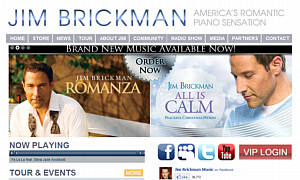 Jim Brickman: I produced a Carpenters tribute show called Yesterday Once More that is currently touring the US. I’d love to do more theatrical type shows, maybe even write for Broadway!
Jim Brickman: I produced a Carpenters tribute show called Yesterday Once More that is currently touring the US. I’d love to do more theatrical type shows, maybe even write for Broadway!
John: Thank You again for spending time with us by way of our interview Jim. I look forward to the day when I can follow-up by another interview together.
In closing for now, do you have anything you would like to express to the people who will be attending a concert this year, and the many fans that have supported you throughout your career?
Jim Brickman: I am most humbled by people who tell me how my music has touched them. You really can’t measure something like that that in awards and sales.
Visit the jimbrickman.com homepage and the Jim Brickman Store. Find more about the topics Jim mentioned like his Holiday Concert Tour schedule for 2011 & 2012, and listen to his radio program at brickhouseradionetwork.com. Read my pages dedicated to Jim Brickman. Photos are courtesy Kirkland Performance Center & jimbrickman.com.

Suzanne Doucet is an award winning composer, producer, recording artist, and conceivably the worldwide leading authority in the new age music industry today. Beginning with her early founding innovations in the new age music business while living in Germany, Suzanne Doucet’s extensive career which spans a number of decades has played a vital role in the New Age Music genre. This is a point that remains true today, and one that simply cannot be overstated.
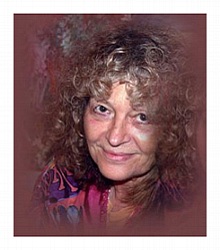 Suzanne Doucet continues her important leadership role by specializing as a creative consultant to artists, producers and record labels, radio programmers, distributors and music retailers around the globe. The New Age Music Circle is another venue where people of all nationalities have an opportunity to meet Suzanne Doucet, and participate in open dialogue at the forum she hosts from her home in Los Angeles California.
Suzanne Doucet continues her important leadership role by specializing as a creative consultant to artists, producers and record labels, radio programmers, distributors and music retailers around the globe. The New Age Music Circle is another venue where people of all nationalities have an opportunity to meet Suzanne Doucet, and participate in open dialogue at the forum she hosts from her home in Los Angeles California.
The New Age Music Circle is an international online community forum and discussion platform where top new age artists, industry professionals, and music fans alike can share music, videos, post information about events and participate in forum dialogue that cover a wide range of topics. Suzanne Doucet’s Music Circle is the leading international forum where all interested people and artists have an opportunity to join and meet new friends, exchange ideas with one another, and find out more about many of your favorite artists.
In this comprehensive 2011 interview, review publicist John Olsen has asked questions that detail many biographical aspects of Suzanne Doucet’s life and early career, up to her present day leadership role for which she is recognized today.
Suzanne Doucet Interview;
John Olsen: Thank you for consenting to my interview Suzanne. People want to know more about you, and it is truly an honor to present your most current interview to your many fans, colleagues, and the over a thousand New Age Circle Forum members currently on the membership roster. As a forum member myself I recognize membership extends to people from all parts of the world internationally. Would you like to begin our interview by telling everyone about the Circle, in terms of how the New Age Music Circle began, its mission, and plans for the future?
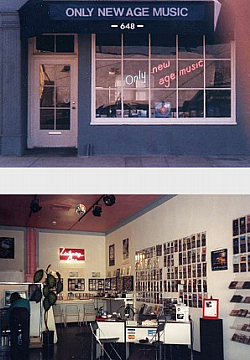 Suzanne Doucet: Thank you John for giving me the opportunity to have this interview with you. I feel very fortunate to be able to express my views with someone so experienced and prolific like you. To answer your question about the New Age Music Circle, this is how it actually began. Many years ago, in 1987 when we, (my husband James and I) opened the first and only new age music store in the world in West Hollywood/Melrose district, I also started an organization called “The New Age Music Network.” This organization was designed to support our genre and to bring our community closer together.
Suzanne Doucet: Thank you John for giving me the opportunity to have this interview with you. I feel very fortunate to be able to express my views with someone so experienced and prolific like you. To answer your question about the New Age Music Circle, this is how it actually began. Many years ago, in 1987 when we, (my husband James and I) opened the first and only new age music store in the world in West Hollywood/Melrose district, I also started an organization called “The New Age Music Network.” This organization was designed to support our genre and to bring our community closer together.
Somehow our store very quickly became a busy center and hub not only for customers, but also for artists and industry people. It was a time when new age music became very popular and we had monthly gatherings and events in our store for the new age music community. This eventually expanded into the International New Age Music Conference in 1989. Two more conferences followed and the First New Age World Music Festival at the Wiltern Theater in Los Angeles. We also had New Age Music Awards. Our early members included Stephen Hill, Peter Baumann, Steven Halpern, Michael Hoppé, Peter Kater, Richard Burmer, Michael Stearns, Paul Horn, Jai Uttal, Steve Roach, Matt Marshall from Higher Octave, the Radio Station 94.7 The Wave, Suzanne Ciani and many others. During the recession in 1992 we had to close our physical store after 5 years but quickly took Only New age Music online. We registered NewAgeMusic.com in 1995. However the New Age Music Network was dormant after our last conference in 1991 until 2008. Then in 2008 the idea surfaced to reactivate the New Age Music Network online and to reconnect with all previous members, along with many new members, so I started the New Age Music Circle under the Ning Social Networking site online at: NewAgeMusik.Ning.com.
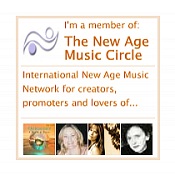 I guess it was just the right time, because many of my old friends and colleagues including Frank Schenker, Lloyd Barde, Steven Halpern, Kit Thomas and Michael Hoppé asked me why don’t we reactivate the New Age Music conference. I thought before we reactivate the conference we have to recreate the “official membership organization.” Now in terms of reactivating a New Age Music Conference I am suggesting to focus more on an event. This could be the New Age Music Awards (NAMA) followed by the conference. These are our plans for the future. Many members of the circle have responded very enthusiastic about this idea. I hope we can manifest it in 2012 or 2013.
I guess it was just the right time, because many of my old friends and colleagues including Frank Schenker, Lloyd Barde, Steven Halpern, Kit Thomas and Michael Hoppé asked me why don’t we reactivate the New Age Music conference. I thought before we reactivate the conference we have to recreate the “official membership organization.” Now in terms of reactivating a New Age Music Conference I am suggesting to focus more on an event. This could be the New Age Music Awards (NAMA) followed by the conference. These are our plans for the future. Many members of the circle have responded very enthusiastic about this idea. I hope we can manifest it in 2012 or 2013.
John: Sounds from the Circle is a 3-album collection of releases from Circle member artists who submitted their New Age, or related sub-genre music to you for the 2009, 2010, and 2011 compilation albums. Would you tell us about the 3 Sounds from the Circle releases?
Suzanne Doucet: When I started the New Age Music Circle, a lot of artists placed their music on their pages, and in order to be able to listen on a continuous basis I featured my favorite tracks on the front page at the Circle Forum. I was amazed how much new music and great new talents were there, whom I was not aware of. I thought that their music and the music of all circle members should be made available to a broader audience and should also reach the industry and the media. My friend Beth Hilton and I came up with a concept for an MP3 compilation versus a regular CD. We were able to lower the cost for the participants and expand the listening time as well as having an innovative approach that might catch people’s attention for our genre. I invited the artists of the circle to participate for a small fee and the response was great!
 We also made the Sounds from the Circle I, II & III available on iTunes as a play list, so the general public can purchase the compilations and every artist is receiving digital download income. We are sending the compilations to the media and we are distributing them at major tradeshows such as INATS or MIDEM. Right now I am preparing Sounds from the Circle IV, which should be available in early 2012. We are reaching a lot of people and we are able to promote the music from the artists of the circle as well as the New Age Music Circle itself and last but not least, the New Age Music genre!
We also made the Sounds from the Circle I, II & III available on iTunes as a play list, so the general public can purchase the compilations and every artist is receiving digital download income. We are sending the compilations to the media and we are distributing them at major tradeshows such as INATS or MIDEM. Right now I am preparing Sounds from the Circle IV, which should be available in early 2012. We are reaching a lot of people and we are able to promote the music from the artists of the circle as well as the New Age Music Circle itself and last but not least, the New Age Music genre!
John: You have an extensive career Suzanne, which began during the years you lived in Germany. What was your earliest introduction to music, and at what point did you decide to pursue a career in music?
Suzanne Doucet: The earliest introduction to music I can remember was singing a Christmas song on stage when I was 2 ½ years old. I remember very clearly standing there seeing the audience and singing this beautiful song which translated said: “I am coming from heaven to bring you a message.” Later I would grab any instrument and try to play it. I recall my mother teaching me how to play harmonica when I was 5 and later I was given a violin at the age of 8 by my grandfather, but I was not allowed to practice in the house where we lived. So, I would go into the forest and play there. When I was eleven I was able to practice piano and started piano lessons, which also included me starting to write my first compositions. I was very fortunate to have a piano teacher who was quite “new age” in her approach. The book we used in the lessons was called The Inner Listening. In the beginning I had to play one tone after another and listen to it until the sound vanished into silence. Only many years later I understood the value of those lessons and what a great teacher I had.
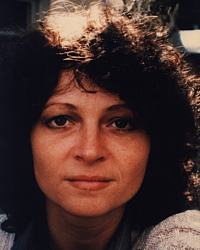 However I studied all classical composers and played Mozart, Bach, Beethoven, Schuman, Schubert, Chopin, Bartok and many more of the popular classical and modern composers. My mother who was an actress had the most incredible vinyl music collection you can imagine and played continuously classical, jazz, Folklore and what we today call World Music.
However I studied all classical composers and played Mozart, Bach, Beethoven, Schuman, Schubert, Chopin, Bartok and many more of the popular classical and modern composers. My mother who was an actress had the most incredible vinyl music collection you can imagine and played continuously classical, jazz, Folklore and what we today call World Music.
When I was 16 I lived in Switzerland. I really missed the piano and wished for a guitar. I taught myself to play the guitar and learned over 300 folk and pop songs in many different languages. I also started to write my own songs and when I moved to Munich Germany and later to Paris France, I would sing in clubs, in the streets and parks. I was also very involved in painting. My family always thought I would become a painter. I started drawing when I was 3 and painted in oil and aquarelle later until my music career took over and I concentrated more on composing, writing and performing. I actually sold a few paintings at the age of 16 and financed my “independence” by moving to Munich Germany on my own without any financial support from my parents!
John: Early in life as it turned out, you became a very popular artist who achieved rock star status with several #1 hits in the 1960’s and 1970’s. Would you tell us about this period in your life, and the effect this had on your music career from then on?
Suzanne Doucet: It was really not my intention to become a recording artist. It just happened. I went to Munich to go the Academy of Visual Arts and I was planning to maybe go to acting school as well. However I missed the enrollment and made a living partially with selling newspapers in the arts quarters of Munich, mostly in the evenings in clubs. It was much easier to sell those papers when I sang a few songs with the bands.
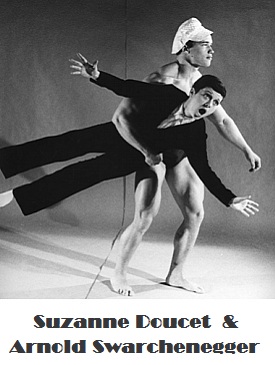 There was also song competitions going on every week and I won first place most of the time, which got me my first job as a singer in an American Forces Night Club. That was a great training because I had to learn 40 plus American standards (songs) in two weeks and I had to play percussion, guitar and sometimes piano in the band. A few months later a colleague of my mother asked me if I wanted to do an audition for the main German TV station NDR in Hamburg. They were looking for completely unknown talents and planning a series of improvised shows. Improvisation was one of my passions and I loved to do standup comedy, sketches, and improvised scenes.
There was also song competitions going on every week and I won first place most of the time, which got me my first job as a singer in an American Forces Night Club. That was a great training because I had to learn 40 plus American standards (songs) in two weeks and I had to play percussion, guitar and sometimes piano in the band. A few months later a colleague of my mother asked me if I wanted to do an audition for the main German TV station NDR in Hamburg. They were looking for completely unknown talents and planning a series of improvised shows. Improvisation was one of my passions and I loved to do standup comedy, sketches, and improvised scenes.
I went with a very talented young actor and friend Martin Luettge, and we had no expectations whatsoever to get the gig. We were very excited just to have a chance to see a television studio. Actually that was much more important to us. We were very surprised that we were the only ones invited, and we had a contract for two years in our pocket when we left. That first show was a success and a few other TV shows followed. In the same year I received an offer from a record company to do a single. I wasn’t too crazy about singing German pop songs, but I made a deal with Leif Kraul who was the president of Metronome. If I had a hit record I would then be able to record an album with my own songs. He agreed to my proposal not knowing that my second single (the German version of the U.S. hit Be my Baby) went to the #1 charts in Germany. After 2 subsequent hit singles I went to Leif in 1965 and asked him about our agreement. He was not too happy about it and said that “we should not confuse the public now.” This was his way of saying no. So, I offered to produce my first album myself, and with my own money. The only condition was that Metronome would release the album. He agreed, probably thinking that, I would never do that but six months later I put the finished master on his desk. That was the album Rot wie Rubin. This changed my status in the entertainment industry in Germany completely.
John: I found your career as an actress and television entertainer very impressive Suzanne. You were in fact a star! I read during your role as entertainer and hostess for popular, prime time television shows in Germany and Switzerland, guests on your prime time televised programs included the famous superstars; Bee Gees, Grateful Dead, Keith Emerson, David Bowie, and many more star celebrities. Do you have some memorable stories you would like to share while you were an entertainment hostess, and would you tell us all about your career as an actress?
Suzanne Doucet: I always worked as an actress throughout my career which included plays, theater and musicals like Godspell with Donna Summer in Munich, TV-Plays and doing voice overs, directory assistance, script and film editing. I also started directing and producing when I was 19 – 20 years old. Because of my mother being an actress, mostly theater, I performed on stage very early at age 11 and played my first main role on stage when I was 17.
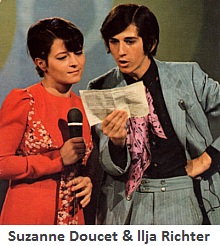 Pretty much everything I did in my career happened unexpectedly. All of a sudden I found myself a singer, appearing in major TV shows next to celebrities and being on cover pages, getting hundreds of fan letters per day. It was a great time and I took the opportunity to learn as much as I could, but I was never really attached to this world of glitter and fame.
Pretty much everything I did in my career happened unexpectedly. All of a sudden I found myself a singer, appearing in major TV shows next to celebrities and being on cover pages, getting hundreds of fan letters per day. It was a great time and I took the opportunity to learn as much as I could, but I was never really attached to this world of glitter and fame.
Something in me was always pointing to a deeper reality and my vision was to express those thoughts and feelings through art. One of the greatest opportunities for me was that I could travel the world through my ability to perform and enjoy experiencing many different countries and cultures. I came to the U.S. for the first time in 1968.
My main interest was not to be in the spotlight, but to produce and direct. I had a passion for film as well. My vision of an ideal art form was music combined with visuals. So, I took every opportunity to learn wherever I was. While shooting TV shows I studied what the camera was doing, went to the editing room and discussed production topics with the producer and director. How can entertainment be improved? How can we bring in more quality and important messages?
Swiss and German TV asked me to become a host in their top music shows and I happily accepted. Being a host for 2 of the most popular European shows at the time was another opportunity to do things differently! I was able to co-create the concepts of the presentations in the format of innovative sketches and of course there were many interesting encounters with great artists, managers, musicians, directors and industry executives. One of the shows I did was in Switzerland was called Hits a gogo. It was a live TV show, which I liked much more than taped shows. There is something amazing for me in the “irreplaceable moment” and the uniqueness of “this is it.” Even if the walls are falling or someone is not showing up in time, which happened in my shows several times, you have to pull through. It is like playing theater or performing on stage. You never know how it will turn out and that brings in the magic. I had to speak 4 languages in this show. German, French, Italian, and English. I think the funniest show was one in which I addressed the UK artists in Italian and the French guys in German, the German artists in French and the Italian artist in English.
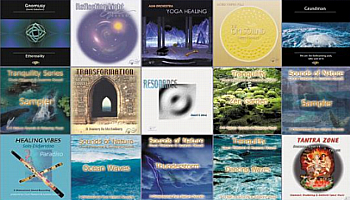 I remember having David Bowie in 1968 with his first hit Space Oddity in my show and the progressive rock group Yes and so many other great performers. Unforgettable was for me Keith Emerson with his group The Nice as my guest in the first color TV show in Switzerland. He played the song America. It was an awesome performance! You can see this video on You Tube. Several years later I saw him again with Emerson, Lake & Palmer in New York, at Madison Square Garden. That was one of the greatest concerts I have ever seen in my life!
I remember having David Bowie in 1968 with his first hit Space Oddity in my show and the progressive rock group Yes and so many other great performers. Unforgettable was for me Keith Emerson with his group The Nice as my guest in the first color TV show in Switzerland. He played the song America. It was an awesome performance! You can see this video on You Tube. Several years later I saw him again with Emerson, Lake & Palmer in New York, at Madison Square Garden. That was one of the greatest concerts I have ever seen in my life!
John: Early on you established your own record company (Isis Music International) and had introduced new age music in Europe for the very first time by songs from your album entitled In Essig und Oel. In fact, many of your songs and albums like Red as a Ruby & Reisefieber were very innovative. Could you tell us about your groundbreaking songs, albums, and releases you produced with other artists?
Suzanne Doucet: Yes, after having been signed to various Indies and major labels of Metronome, Liberty, Prom (CBS, TELDEC), Phillips and EMI. Still struggling with the industry about quality and commerce, I finally decided to start my own label. My first release was my last album as a singer with what you could call “new age songs” in 1979. I was singing songs about my own “spiritual journey.” This endeavor was quite successful and I received a lot of applause from the audience, the media and the industry! I was organizing my own PR, radio and retail tour, which was challenging. But most of the TV and radio hosts were supportive and embraced the idea that an artist would start their own label with enthusiasm. I was able to get onto the music charts and do well with my first release Reisefieber, which was also my last album as a singer.
 I had started already in 1970 to break out of the traditional pop format by releasing a psychedelic Krautrock adventure on Phillips. A triple album called Zweistein (artist/group) Trip, Flip Out, and Meditation. You can see from the titles where I was heading. I went from psychedelics to spirituality like many other colleagues from my generation. In 1974 I recorded In Essig & Oel which was my first album with new age songs and poetic songs describing a deeper meaning of life and searching for truth.
I had started already in 1970 to break out of the traditional pop format by releasing a psychedelic Krautrock adventure on Phillips. A triple album called Zweistein (artist/group) Trip, Flip Out, and Meditation. You can see from the titles where I was heading. I went from psychedelics to spirituality like many other colleagues from my generation. In 1974 I recorded In Essig & Oel which was my first album with new age songs and poetic songs describing a deeper meaning of life and searching for truth.
Musically I believe that I was fortunate to always work with the most outstanding musicians, arrangers and sound engineers. And as a producer I always pushed the envelope. The result was that these productions stood out and received raving reviews for what they were. You could not really compare my albums with anyone else. That was on one hand a great advantage on the other hand seemed an obstacle for the industry. They could never seem to place me in one particular category.
I was always looking for the best possible way of expression and I never liked to conform to certain preconceived ideas or concepts. This was already apparent in my first album production Rot wie Rubin with Rio Gregory. The best description for this album is probably “Ethereal, Poetic Songs and Sound Paintings.” These elements always remained in my albums. I was looking for something new and innovative, and later with artists such as Christian Buehner, Gary Miraz, Chuck Plaisance or Tajalli, I explored new sounds and new ways of composing, performing and recording in the instrumental world of new age music.
John: You have numerous collaboration and solo albums, many of which were groundbreaking at the time like we have talked about earlier. Of your latest recordings and re-releases, what are some albums you would suggest people to sample, for those who may not be as familiar with your music?
Suzanne Doucet: My first collaboration with Christian Buehner was the album Transformation in 1982. From my solo albums I would recommend Reflecting Light & The OM Sound. With Tajalli I recorded Tantra Zone and with Chuck Plaisance over 40 albums of Nature Sounds and Nature Sounds with Music. I would recommend The Sounds of Nature Sampler and the Tranquility Series Sampler. Resonance with Gary Miraz is one of my favorites because it was created so effortlessly. Sireena in Germany recently released a compilation of my singer, songwriter era. The album is called Wo sind all die schoenen Jahre. It has songs from 4 albums. The songs can be sampled at Tunes.
John: You moved to California in 1983 and later founded the very first new age music retail outlet store in the world called Only New Age Music. Would you tell us about your business experience and events during this time in your life?
Suzanne Doucet: The idea to open up a store dedicated to the New Age Music genre came from my own experience by having to go to 5 different stores to find 5 different albums. I thought there should a place where people can find everything they are looking for in new age music. My husband and daughter Natascha, who was 7 years old at the time, drove cross-country twice and we visited every bookstore and every distributor of new age music we could find in 1983 – 1984. We also visited and met with many artists and upcoming record labels. We went to new age communities and centers and shows like the Whole Life Expo and others. It was exciting for us to see that there was a real community, much larger than in Germany or Europe at the time. We started selling our own cassettes from Isis Music in Venice at the boardwalk in 1986 and we wanted to expand into a retail outlet. It took us 6 months to find the right place. My son Shaman was 6 months old, and Natascha was 10 years old when we sold cassettes at the beach.
John: I read many customers of your Only New Age Music store were famous celebrities. Steve Martin was one celebrity. Who were some of the other regular patrons of your business?
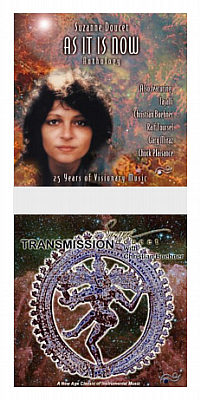 Suzanne Doucet: Robert Redford, Sylvester Stallone, William Schatner, Prince, Sonja Braga, Shirley Maclaine and many others. They all bought new age music from our store for various reasons. I guess we had opened the store at the right time in the right place. The day after our official opening we had the LA times, Billboard magazine, Eyes on LA, CBS News, and in the weeks and months following, Japanese and European Television as well as Life Magazine and many more. Two months after our opening the mainstream Radio Station KTWV – The WAVE started playing new age music and sent every listener who called our way. We were able to co-sponsor concerts with The WAVE like Suzanne Ciani at the Roxie (which was a FIRST) and so we became the center hub for new age music. It all just happened naturally.
Suzanne Doucet: Robert Redford, Sylvester Stallone, William Schatner, Prince, Sonja Braga, Shirley Maclaine and many others. They all bought new age music from our store for various reasons. I guess we had opened the store at the right time in the right place. The day after our official opening we had the LA times, Billboard magazine, Eyes on LA, CBS News, and in the weeks and months following, Japanese and European Television as well as Life Magazine and many more. Two months after our opening the mainstream Radio Station KTWV – The WAVE started playing new age music and sent every listener who called our way. We were able to co-sponsor concerts with The WAVE like Suzanne Ciani at the Roxie (which was a FIRST) and so we became the center hub for new age music. It all just happened naturally.
John: Another first you are credited with is your production and direction of the very first 3 international New Age Music Conferences. Plus you organized the very first New Age World Music Festival featuring 22 international bands and musicians in Los Angeles. Please Suzanne, would you tell us all about your leadership role in these historic events involving the New Age Music genre?
Suzanne Doucet: As I mentioned before the new age music network that was formed in 1987 evolved into these conferences and the concert at the Wiltern. I had this vision that the public did not really grasp the multitude of diverse influences from various cultures and musical styles that new age musicians would incorporate in their music. I felt a concert bringing as many different expressions of this music on stage would be the driving force behind the idea for the store, for the conference, and the concert.
John: Today during your present position as marketing strategist, consultant and online retailer, you assist hundreds of musicians, producers, record labels, radio and radio programmers, and music retailers. It seems you offer assistance to nearly everyone! This is a really broad question but would you outline your responsibilities, professional services you offer, and the corresponding websites?
Suzanne Doucet: I have been assisting other artists and record labels with the help of my husband James since 1987. Because I have a broad view of the new age music market being an artist, publisher, label owner, retailer, promoter and producer myself, I can put myself almost into anyone’s shoes. I am very often looking at campaign strategies from various aspects to make sure it works for the artist, but also for the media person, the retailer or the distributor. Whether we are talking about production, packaging, promotion, sales or advertising it has to work for everyone involved. Many artists see everything from their own perspective only, so I am coaching them and assisting them in whatever their project is.
I have been very fortunate to work with amazing talents such as Alex de Grassi, Patrick O’Hearn, Liquid Mind, Omar Akram, Christopher Franke (TG), Paul Avgerinos, Golaná, Ray Leonard, Michael Hoppé, Fiona Joy Hawkins, Lia Scallon and Hennie Bekker, to mention a few. I also worked with various record labels in the capacity of a creative consultant.
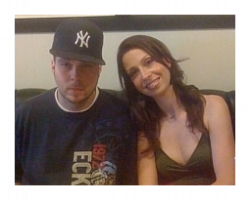 I assisted Soundscan with their New Age genre definition and programmed several DMX music channels. What I am offering is assistance with audio and video production, packaging, graphics, promotion and marketing. I provide innovative ideas and new solutions in any area of the project. You could also call me a project director and/or project manager. I believe one of the most important aspects of my work is that I fill in the gaps. I usually find out very quickly what is missing and help provide the missing components. My strengths also involve strategy, campaign planning and looking for creative ways of enhancing a project. I love graphic arts and filming. Whenever needed I create artwork, and together with my husband and Beth Hilton to produce videos, interviews and visual music clips. You can see some on YouTube.
I assisted Soundscan with their New Age genre definition and programmed several DMX music channels. What I am offering is assistance with audio and video production, packaging, graphics, promotion and marketing. I provide innovative ideas and new solutions in any area of the project. You could also call me a project director and/or project manager. I believe one of the most important aspects of my work is that I fill in the gaps. I usually find out very quickly what is missing and help provide the missing components. My strengths also involve strategy, campaign planning and looking for creative ways of enhancing a project. I love graphic arts and filming. Whenever needed I create artwork, and together with my husband and Beth Hilton to produce videos, interviews and visual music clips. You can see some on YouTube.
I still don’t have any formula and look at every project with fresh eyes. I work with a team of professional promoters, marketing experts and distribution channels. I believe I am quite flexible with my services and I am willing to talk for an hour with someone and give him or her, the information he or she can use with no strings attached, or work on a continuous basis, monthly, or sometimes for years. One of my clients has used my services for almost 20 years on and off. I can take on tasks myself and do work for the artist but I prefer that the artist learns everything I know, so they can do it themselves and they won’t require my assistance anymore.
John: I read you serve on the GRAMMY® committee. If the NARAS (National Academy of Recording Arts and Sciences) guidelines allow, can you tell us your role while serving on the GRAMMY® Awards committee?
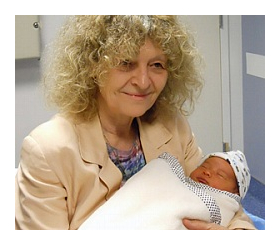 Suzanne Doucet: I am not allowed to specifically talk about my role at NARAS (National Academy of Recording Arts and Sciences), but I have to say that I enjoy very much what I am doing there for the past 25 years.
Suzanne Doucet: I am not allowed to specifically talk about my role at NARAS (National Academy of Recording Arts and Sciences), but I have to say that I enjoy very much what I am doing there for the past 25 years.
John: Your career so multifaceted and diverse Suzanne! I am sure there are many topics I am leaving out. Is there anything you would like to tell about yourself? Perhaps you could tell everyone about the recognition and achievements you have been honored with during your career?
Suzanne Doucet: It might be important to mention that through immaterial gifts from my parents I was able to learn a lot very early in life which enabled me to have trust in whatever I was doing. My mother being an actress introduced me from infancy on to theater, art, music, literature, philosophy, healthy living, yoga and metaphysics. My father, a Jungian Psychologist introduced me early on to the most important questions in life, for example who I am, what life is all about, and how can find understanding of this existence. Without them I would not have been able to accomplish the various things I did in life, so I am very grateful to my parents for their support.
I would also like to mention that I was always conscious of the spiritual reality as long as I can remember, but never attached to any religion or group. I studied many spiritual traditions and I also studied psychologists such as C.G. Jung. Through my father’s (Dr. F.W. Doucet) studies in parapsychology, and super learning in the late sixties and early seventies I slowly integrated metaphysical elements into my work, and that’s how I really came to create new age music. My father inspired me to study Pythagorean Harmonics, which to me is one of the most fascinating subjects on earth and this study naturally gave me the understanding why music created with a certain consciousness and understanding is so essential for everyone on this planet.
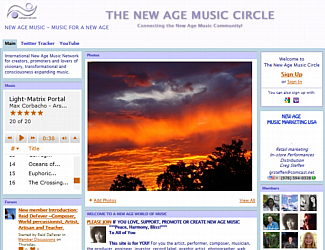 I also have to thank my musical mentor Rio Gregory, an incredible pianist, arranger and composer whom I met when I was 16. He guided me musically for many years and we wrote many songs together. Also Anja Hauptmann, my lyrical collaborator and best friend was instrumental in many ways. There were numerous other friends and colleagues who inspired the work I am doing and every one of them has a place in my heart.
I also have to thank my musical mentor Rio Gregory, an incredible pianist, arranger and composer whom I met when I was 16. He guided me musically for many years and we wrote many songs together. Also Anja Hauptmann, my lyrical collaborator and best friend was instrumental in many ways. There were numerous other friends and colleagues who inspired the work I am doing and every one of them has a place in my heart.
There were a few awards. I remember in 1966 I won second place at the Song Festival in Knoggke, Belgium. I received an award in Italy even earlier in 1962, which was the Golden Margharita in Viareggio Italy, and there might have been a few other festivals in Europe. In the U.S., I received a Silver Award for best Music Video at the Houston Film and Video Festival for Starflight, a visual music piece produced and directed with Christopher Toussaint. I received a COVR award for Feather on the Wind – an album a co-produced with Golaná. I also wrote the title song and won an award for Best Mediation and Best Electronic Album for my collaboration with RAY (Ray Leonard). The album is called Celestial Touch.
John: Thank You again for taking time out for our interview Suzanne. I trust we will find time to interview again in the future. For now, is there anything you would like to express to your fans, colleagues, or Circle members?
Suzanne Doucet: Many thanks to everyone I was able to meet, and for sharing their music and experiences with me. I am blessed to have met so many wonderful people in my life, many of them in the new age music community. I love my fans, colleagues and Circle members. I am grateful to be part of such a creative and talented community, and I truly do not perceive myself so much as the doer but more as an instrument among many others in this fabulous orchestra of existence. Thank you too John for this interview.
You can visit Suzanne Doucet & Circle members at NewAgeMusik.ning.com & her personal SuzanneDoucet.com website. You can find more great music for sample or purchase at her NewAgeMusic.com & NewAgeUniverse.com sites. Visit her YouTube Channel & her New Age Music Channel and my Suzanne Doucet page. Photos are courtesy Suzanne Doucet.
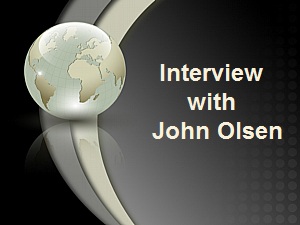 NewAgeMusicWorld.com is honored to be a helpful source of information to visitors searching for top new age albums, songs, videos and the very best music available today. Along with my role as review publicist, I regularly feature many of today’s top artists by an interview publication. Writing interview and review editorials for my website visitors are just part of what I do while offering free support to the many independent and label musicians I represent worldwide.
NewAgeMusicWorld.com is honored to be a helpful source of information to visitors searching for top new age albums, songs, videos and the very best music available today. Along with my role as review publicist, I regularly feature many of today’s top artists by an interview publication. Writing interview and review editorials for my website visitors are just part of what I do while offering free support to the many independent and label musicians I represent worldwide.
I have 19 interview publications at New Age Music World presently, plus I have several interviews scheduled with artists almost everyone will recognize. I will keep these esteemed new age musicians a secret for now, but I do want to tell you about my most recent interview. While my name is far from a familiar name, the site host for The Music Explorer, Alvaro Villa André from Spain requested an interview with me. During my interview I answer his questions related to the great musicians I feature at New Age Music World.
The interview with John Olsen if anything gives insight about my responsibilities as a site host and the artists I represent. I am not here to promote myself so I basically give my viewpoint as an artist representative and music site host. Rather than publish this interview at my website, visit The Music Explorer to find out more about my responsibilities if you would like.
Note: The music blog containing the interview is down for an undetermined time but you may read about some of today’s top artists I have interviewed on my Interview Section. Two future editorials I have are a “Best Christmas Albums” and “Best New Age Music Albums in 2011” articles, so visit New Age Music World again soon.

Coburn Tuller from Springfield Missouri is a New Age artist releasing an innovative new album that is capturing the attention of many review publicists, and the buying public upon its initial release. One reason for the increasing interest given to his debut album is undeniably the relaxing qualities of his music. Another reason could be related to the unique melodic intonations heard on his first album which were produced from a musical instrument he invented and has named The Tones.
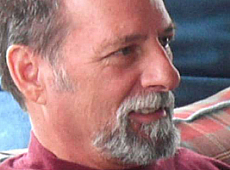 Coburn Tuller’s first album release is entitled Butterfly Tones. It is a rare occasion when an artist can discover a completely new and original sound identity for themselves, but this is the given circumstance with Coburn Tuller.
Coburn Tuller’s first album release is entitled Butterfly Tones. It is a rare occasion when an artist can discover a completely new and original sound identity for themselves, but this is the given circumstance with Coburn Tuller.
The exclusive Butterfly Tones release which features 9 songs of melodic bell timbres has proven to be an innovative source of musical harmony, and one of the most original arrangements available in recent memory.
New Age Music World host John Olsen recently had the opportunity to meet Coburn Tuller in person for their interview which covers topics about Coburn’s first release and his one of a kind instrument. Included are accolades of praise made by some of the industry’s top New Age review publicists. Music World is pleased to present this interview to Coburn Tuller’s fans and to our site visitors.
Interview with Coburn Tuller;
John Olsen: It was truly a pleasure to meet you and your family for the first time Coburn. My wife and I also had a great time meeting some of your friends and the impromptu concert you performed for everyone on the unique instrument you invented and have aptly named The Tones.
Coburn Tuller: Glad you enjoyed it. It’s always a pleasure to have good friends over and playing the Tones is always fun.
John: Would you like to begin by telling everyone the circumstances of how your idea for The Tones first began?
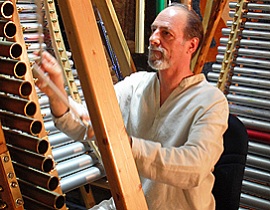 Coburn Tuller: It was during one of my midnight walks when I heard the sound of wind chimes wafting through the evening air. I’d heard the tinkle-tinkle kind of chimes before, but these were the new generation of beautiful sounding wind chimes that had just come out. That was in October of 1996. The nest day I was passing my favorite metal store and just cruised in to see what they might have in the left over bin. Among the chunks of aluminum was a round tube that when struck with a mallet sounded for almost 2 minutes. I was mesmerized. So I went back to get some more and soon had 7, then 14 and then 20 Tones to play and experiment with. Thus began 12 years of various designs and many detours until the present set emerged.
Coburn Tuller: It was during one of my midnight walks when I heard the sound of wind chimes wafting through the evening air. I’d heard the tinkle-tinkle kind of chimes before, but these were the new generation of beautiful sounding wind chimes that had just come out. That was in October of 1996. The nest day I was passing my favorite metal store and just cruised in to see what they might have in the left over bin. Among the chunks of aluminum was a round tube that when struck with a mallet sounded for almost 2 minutes. I was mesmerized. So I went back to get some more and soon had 7, then 14 and then 20 Tones to play and experiment with. Thus began 12 years of various designs and many detours until the present set emerged.
John: Our interview together includes pictures of your instrument, but to give everyone a better idea of what is involved, could you describe the materials and dimension of The Tones?
Coburn Tuller: The present set was completed in 2008. It consists of 90 tones of aluminum and brass ranging from 7 in. to over 6 ft. in length. The three wooden pyramid frames are slightly over 8 feet high and the entire set is 7 feet deep x 9 feet across. All together is weighs almost 750 pounds.
John: You were telling me that over the past 15 years you have devoted a lot of time perfecting your instrument which must have been a real challenge at times. What were some of the early prototypes like, and could you describe some of the challenges involved with fabricating a new musical instrument?
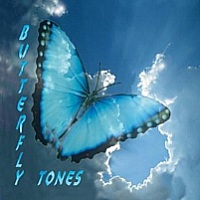 Coburn Tuller: There were a variety of early designs. At first I simply suspended each Tones in cradles of fishing line at each node. After a few months I rigged a set of 25 Tones into a frame with two layers, one on top of the other like a marimba or two layer amadinda. I tried simply bolting the Tones in place but found that they had almost no ring at all, so I went back to the string idea experimenting with various types of cord and eventually went back to heavy duty fishing line for this model. I played this design all through the first winter and following spring until I had more time to experiment.
Coburn Tuller: There were a variety of early designs. At first I simply suspended each Tones in cradles of fishing line at each node. After a few months I rigged a set of 25 Tones into a frame with two layers, one on top of the other like a marimba or two layer amadinda. I tried simply bolting the Tones in place but found that they had almost no ring at all, so I went back to the string idea experimenting with various types of cord and eventually went back to heavy duty fishing line for this model. I played this design all through the first winter and following spring until I had more time to experiment.
I next tried other kinds of metal, copper, aluminum conduit and stainless steel-whatever I could find at the salvage yard. The stainless sounded more like hitting a pipe but the other two had promise. Mind you, I had to work my normal business as a set builder so there were weeks and even months when we had a big set to build that I had absolutely no time whatsoever for Tones.
I suppose the biggest prototype was the five layer instrument I began around 2000. It was to have 2 layers of aluminum thick wall, one of aluminum conduit, one of copper and a fifth of brass if I could find it at the scrap yard, which was where a good portion of the metal came from. I did get the first two layers built including the damper system designed to allow the Tones to be muted by degrees depending on how hard you pressed on the pedals. But I suspended the project when it failed to ring like I knew it could if only I could build it correctly. You see, the main impetus has always been the sound and even when other people would complement me on the sound it made, I always knew there was another dimension of sound in there somewhere.
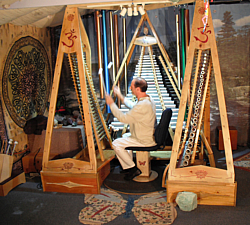 About this time I noticed that I was playing one note more than any other. At first I thought I just liked the G tone best, but eventually I noticed that particular note had vibrato as well as sustain. This caused me to rework the entire set and replace every note with one that had vibrato. Quite the chore since only one in 5 or 6 Tones has that quality.
About this time I noticed that I was playing one note more than any other. At first I thought I just liked the G tone best, but eventually I noticed that particular note had vibrato as well as sustain. This caused me to rework the entire set and replace every note with one that had vibrato. Quite the chore since only one in 5 or 6 Tones has that quality.
In 2002 we started a yoga studio and I built a set of 7 Tones that hung vertically from a simple sweeping Zen type frame. We used it for om meditations before and after yoga practice. It was a little tricky since the Tones would swing and clang together if you were not real careful how you struck them. One day, one of the strings broke and the Tones crashed to the floor. In frustration I asked my then sweetheart Ellen, “What should I do now?” She leaned over and peered at the wreckage and said,”What if you hang them horizontal.” Brilliant! Then I saw that they could have a pyramid shaped frame and I was off and running in the direction that led to the present set. It took another 2 years to build the first pyramid set and an additional 3 more years for the other two pyramids, but the sought after design was finally coming together.
The biggest challenge all along has been that there is nothing else like it so I had no one else’s experience to go on. I just had to keep at it until either I stumbled upon the right course or, as so often happens, someone else suggested something that turned out to lead to the best way to do it.
John: Was tuning each aluminum tube to a true pitch one of the most challenging aspects, and could you tell us the tuning scale or harmonic pitch of The Tones?
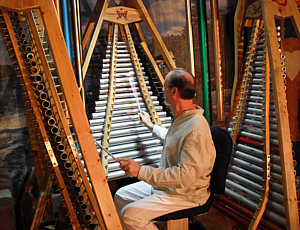 Coburn Tuller: Tuning was very involved. I had design a tuning device that consisted of a strobe tuner like what piano tuners use along with a frequency counter so I could know exactly each tone’s vibration. I would cut and listen, then trim by degrees until the note was right.
Coburn Tuller: Tuning was very involved. I had design a tuning device that consisted of a strobe tuner like what piano tuners use along with a frequency counter so I could know exactly each tone’s vibration. I would cut and listen, then trim by degrees until the note was right.
Shaving off too much, even the thickness of a sheet of paper, meant the Tone was too sharp and went to recycling. Even shooting a coat of clear finish on a Tone could make it sharp. My final method was to rough tune, finish, then fine tune and hope I didn’t go over. All in all, to get the 90 Tones I have now, I have been through more than 600 pieces of tubing.
The scale, too, is tricky because I wanted to tune to what is called Just Intonation, the scale that early classical music was played in and that is closest to the vibration of the major chakras. That way, the Tones would have a healing and relaxing effect. Since no other instrument is tuned to this scale, that was also a rather involved process.
John: I can see how involved the development has been. Now we have a better idea of the instrument you performed on for your first album entitled Butterfly Tones, could you tell us your early music history and educational background in music?
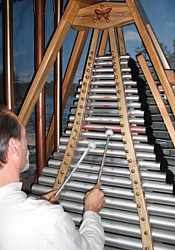 Coburn Tuller: I started playing guitar as a young teenager and especially liked open tunings. I built my first dulcimer at age 17 and even made a few for sale over the years. In 1978 I joined a Belly Dance Troupe called Arabesque. I was the leader of the band on a special two neck dulcimer/guitar instrument I fashioned from my Grandfather’s old Harp Guitar.
Coburn Tuller: I started playing guitar as a young teenager and especially liked open tunings. I built my first dulcimer at age 17 and even made a few for sale over the years. In 1978 I joined a Belly Dance Troupe called Arabesque. I was the leader of the band on a special two neck dulcimer/guitar instrument I fashioned from my Grandfather’s old Harp Guitar.
In college I took up piano and synthesizer as part of a music and dance major. In 1979 built a special 3 neck dulcimer I called the Dulcitar, following that in 1982 with a Yang Chin or Chinese Hammer Dulcimer, both of which I used to write the music for some of my dances and video pieces while at the university. I also wrote the songs and incidental music for a children’s production while there.
John: Knowing your earlier experiences as a musician, was it easy to make a transition and begin composing music for a completely new instrument, and how did you compose the music for your first album?
Coburn Tuller: Actually, I originally thought I would build and sell Tone Sets, but there was always one more improvement to make and when I had the present set completed, the music just started coming through. Fortunately, I had done recording before so it wasn’t a completely new and overwhelming proposition. It did take almost 3 years, however, to compose the 9 tracks on this CD. Sometimes it was merely waiting for inspiration but often I would get a new idea while fine tuning a particular note or I would hear a train whistle in the distance and hum a counterpoint which would begin a new piece. Sometimes I just hit the Tones and let them ring and played with melodies under the sustained notes. One day my sweetheart Mary said, “Just play the low and high C note,” so I did and that developed into Mystic Dream. I guess the short answer is various ways of composing.
 John: When you composed Butterfly Tones, did you write the musical notations for the 9 songs on a music sheet, or do you compose and perform by memory alone?
John: When you composed Butterfly Tones, did you write the musical notations for the 9 songs on a music sheet, or do you compose and perform by memory alone?
Coburn Tuller: I perform entirely by memory.
John: You and I had talked about the many possibilities in which your music can be applied to instrumental scores simply because of the unique intonations of your instrument. If the opportunity arose, would you consider collaborating with another musician by having other New Age artists utilize your music for a combined project together?
Coburn Tuller: Definitely. I would welcome collaboration and would love to be part of another project.
John: Given the fact there is a lot involved in composing, producing, and marketing an album, do you find being a recording artist who has marketed his first album a rewarding experience, and what are some of the challenges to marketing an album yourself?
Coburn Tuller: Fortunately, I published a book in 1995 so had some experience with marketing then. This introduced me to the major New Age distributors and magazines. The internet, however, has changed almost everything about the marketing game so it’s been rather a steep learning curve with much more to come. The biggest challenge is obtaining album reviews and seeing them published so that potential fans can learn about the music and be encouraged to listen to the clips online. I also have ads in the major magazines that go to buyers for the New Age Bookstores and boutiques. As always with doing anything yourself, it takes a lot of time but is rewarding when a project becomes successful like this one is becoming.
John: I read some great reviews on your website reviews page. Would you like to tell us what some of the other review publicists like me have said about The Tones and the innovative musical arrangements you have created on Butterfly Tones?
Coburn Tuller: The reception from major reviewers has been extraordinary! All in all, I couldn’t be more pleased with the excellent reception this CD is garnering.
Michael Diamond called the Tones “a stunning work of art” that “produces exquisite sounds that reverberate and sustain creating a sea of harmonic overtones.”
Kathy Parsons suggests the music as “an ideal accompaniment for massage, meditation and relaxation by taking a person’s focus into a new musical realm altogether.”
Bill Binkelman describes the music as “rich, resonant bell-like tones with amazing, sustained durations that overlap like ripples in a pond.”
Steven Ferrino said “I am noticing the ambiance of my office coming to life with the vibration of the notes filling the room. The playful notes seem to have a life of their own as they bounce off the wall.”
Alejandro Clavijo of ReviewsNewAge.com wrote my newest album review. Alejandro said; “Coburn Tuller has created a lovely album, unlike any other music CD on a percussion instrument. The instrument has a fascinating harmonic richness, depending on the intensity of the blow, the brightness and sound can vary in intensity and this creates a beauty that resides in each composition.”
John: I agree with them totally! The positive statements from these review publicists are a superb reflection of your work! Recently you told me you are planning on another project. Is your second release going to be similar to your first or do you have something else planned on your second recording?
Coburn Tuller: I have been talking with one musician friend in particular about putting some violin and/or mandolin tracks on my upcoming CD I plan to begin this fall.
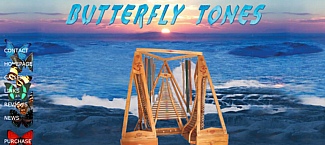 I think the next CD should have something new that expands on what has come before. As such, I have just completed the addition of a set of copper Tones to the main set which brings the count up to 120 Tones. The copper Tones have an almost Asian quality to them and a shorter sustain which allows for a different kind of melodic interplay.
I think the next CD should have something new that expands on what has come before. As such, I have just completed the addition of a set of copper Tones to the main set which brings the count up to 120 Tones. The copper Tones have an almost Asian quality to them and a shorter sustain which allows for a different kind of melodic interplay.
John: Sounds wonderful! We look forward to your second release. Coburn, I enjoyed meeting you, and hope we can arrange another get together soon. In closing, is there anything you would like to comment on that we haven’t talked about?
Coburn Tuller: Just to say I love the music The Tones can create and I am thrilled I can share it with your special audience.
Visit Coburn Tuller at his butterflytonescd.com homepage and visit his CDBaby.com or Amazon.com to sample or purchase. Read what others are saying on Coburn’s reviews page, and find more on our page dedicated to Coburn Tuller.
Photos are courtesy butterflytonescd.com.
